



For 30 years, Furtherfield has pioneered the critical imagination of art, technology, and networked cultures. In this time dominant global actors have created and imposed systems that support contemporary life for some at the same time as poisoning our planetary-wide environment and societies at an escalating rate. There is an urgent need to adopt the principles of less, again and differently, in a fair and equitable way. Seeking to cause less harm. Acting again on the knowledge that has been available (if ignored or downplayed) for decades. Acting differently in response to emerging knowledge, ways of knowing, being and feeling. Understanding our work in this way, how it exists within a living system, is one way of accepting how we are all material beings situated within vast chains of consequence, enmeshed within larger ones. This requires a different standard of responsibilities, a way to be responsive and accountable in a changing world working to address the uneven impacts on people, creatures, and places that may be geographically remote from us, but which nevertheless bear the cost of our actions.
In 2025 we shift the main focus of our work from our long-standing gallery in Finsbury Park, North London to a mid-sized town on Suffolk’s East coast. With a population of 24,000, Felixstowe town is our new home, where we will join existing communities, cultural partners, ecosystems, and species. This transition is a modal shift for the organisation and means we are doing things differently. In Felixstowe, we begin a new journey of becoming an embedded and community-needs-led art organisation focused on art, technology, and eco-social change. Eco-social change is systemic transformation, integrating social justice and ecology— to create fairer, more resilient futures for all.
With this move we commit to being in relation to communities, contexts, and biodiverse regions that are entirely new to us. In creating this policy we hope not only to “move to” but to “move with” our new location, developing different relationships with ourselves, each other, and the land, at the same time composting and letting go of existing practices and connections that harm. This environmental action plan therefore refers to listening, learning, flexibility, agility, stamina, synchronisation, and interpersonal mobility that will be required.
Our first environment action is to sign up to Culture Declares Emergency. Our second has been to develop an environmental policy for the next three years. Our third will be to make two climate pledges by the end of year one.
“We declare that the Earth’s life-supporting systems are in collapse, threatening biodiversity and human societies everywhere.
Alive to the beauty of our planet, we unite to challenge the dominant global power structures that fail to protect us as they disregard scientific consensus, silence marginalised voices and perpetuate ecocide.
As Declarers, we take action to harness the power of arts and culture to express heartfelt truths and address deep-rooted injustices, to care for and create adaptive, resilient and joyful communities, and to influence the urgent and necessary transformation of harmful global systems.”
On creating this policy, we :
In this new phase, we are committed to
Join us for the workshop that is also a game where we use roleplay to explore how personal and collective data practices and devices might shape the attitudes and fortunes of a society?
Sign up by 12th August 2020
Participants will each receive one of two devices in the post, and will be given different roles to play as delegates in a fictional trade negotiation. In this first meeting on record, and with minimal knowledge of each other’s cultures, the people of Ourland and New Bluestead must use their devices to communicate with each other and to agree to the terms of a technology and data-culture exchange.
What do they have to offer? How will they decide what they want and what is in their best interests?
What freedoms might they sacrifice, what insights might they gain?
How might they adapt a foreign technology to their own needs, and how might they understand the risks involved?
This is an invitation to participate in Transcultural Data Pact, a research event that is also a game of serious make believe. We welcome you to a future-historic event and clash of data-cultures.
The event will take place online in Zoom and will last for about 3 hours with a lunchtime pre-event orientation session that will last for an hour.
There are two sessions available for both the game event and the pre-event orientation (which is a requirement of participation):
Lunchtime pre-game orientation events
13.30 – 14.30 BST Tues 18 August 2020
13.30 – 14.30 BST Wed 19 August 2020
Transcultural Data Pact Game events
13.15 – 16.30 BST Thurs 20 August 2020
13.15 – 16.30 BST Fri 21 August 2020
In exchange for your time you will exercise your creative agency contributing to the ideation of future technologies for live personal data. You might even discover new meanings in your personal data in places you never thought of looking before!
All participants will receive a £20 voucher for their contribution to the research.
This is an open invitation to all. No experience in role-playing games is necessary.
Pregame orientation events
13.30 – 14.30 to learn about your devices and about LARPing, to introduce and develop the scenarios, to build the fictional worlds together.
Game Event Schedule
13.20 – 13.30 Arrive in Zoom and sign in
13.30 Introduction
13.40 – 16.00 Nations Technology Exchange Live Action Role Play
16.00 – 16.30 Debrief, reflection and survey
For any enquiries, please email ruth.catlow@furtherfield.org
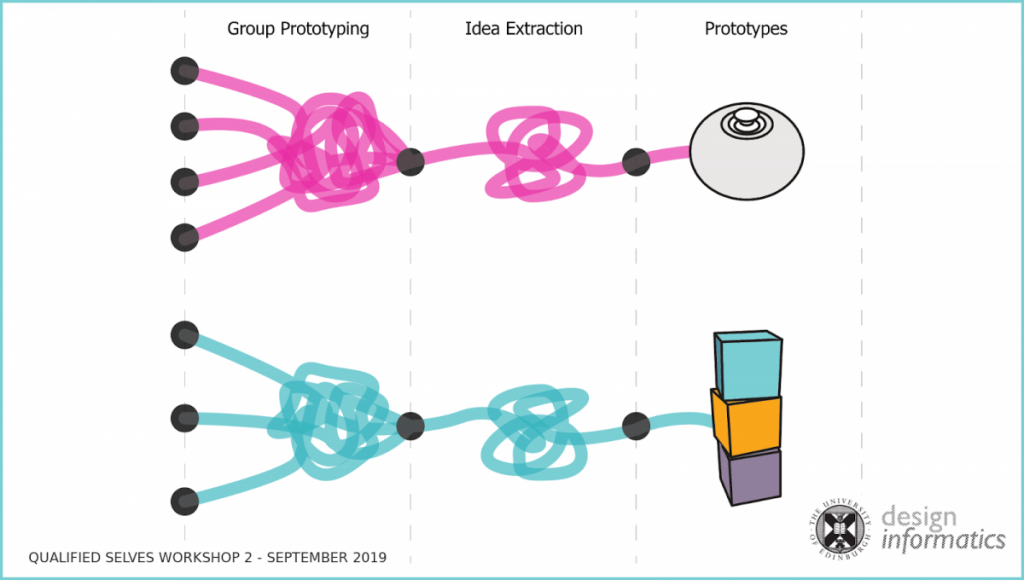
Findings contribute to a research paper Human-Computer Interaction (CHI).
The Transcultural Data Pact is a Qualified Selves research event that uses data objects to stretch people’s imagination about the collection and usage of their own data to investigate personal and collective data devices and practices that add real value.
Qualified Selves is a joint project between Lancaster and Edinburgh Universities. Improving how individuals make sense of data management (from social media to activity trackers to home IoT devices) in order to enhance personal decision making, increase productivity, and improve their quality of life. Its novel approach to co-design and co-creation has supported the development of new prototypes to help think about tracking data in different ways. https://sensemake.org/
Transcultural Data Pact is created by Ruth Catlow (Furtherfield/DECAL) with Dr Kruakae Pothong, Billy Dixon, Dr Evan Morgan and Prof. Chris Speed from Edinburgh University, in collaboration with Kate Genevieve.
Ruth Catlow is Director of DECAL. Furtherfield is London’s first (de)centre for digital arts. DECAL is a Furtherfield initiative which exists to mobilise research and development by leading artists, using blockchain and web 3.0 technologies for fairer, more dynamic and connected cultural ecologies and economies.
Curated by Sarah Cook together with the Director of Somerset House, Jonathan Reekie.
Economy has re-invented time. Development of industrialism and accompanying its advancements, for example, the invention of the railroad, forced standardisation of time. During 1700-1900 this invention increased methods of moving goods, new technologies and large scale investment in the UK’s countries infra-structure (communications network). The result was a complex transport system including roads, rail, canals and the London Underground.[1] Without socio-economic time discipline, it would have been impossible to progress into modernity. Similarly, capitalism and all its products which are well-known to us today, could not have functioned without the disruption of humans’ natural sleep cycle. The artists in the 24/7 exhibition at Somerset House explore the ways of responding, coping with and resisting the capitalist mechanisms of shrinking and controlling our sense of time.
The main focus in 24/7 are the “non-stop processes” of our contemporary culture, and it recognises sleep as pretty much the only time we can unplug from technology, even this time is becoming scarcer and scarcer. The different sections in the show are inspired by Jonathan Crary’s book 24/7: Late Capitalism and the Ends of Sleep. The show is in dialogue with the author’s observations of capitalism’s influence on our everyday lives, creating illusions of timelessness, disorientation and relentless pursuits of capturing, monetising and consuming.
In Marcus Coates’ Self Portrait as Time (2016), the artist’s finger follows the second hand on his wristwatch, creating the illusion of him actually moving it. The work evolves in the space and is a looped video, but also works as a clock, counting time as it passes and constantly reminding the visitors and staff about it. Admittedly, the artistic process at times felt like a trance, and Coates kept loosing the sense of boundaries between himself and the clock.
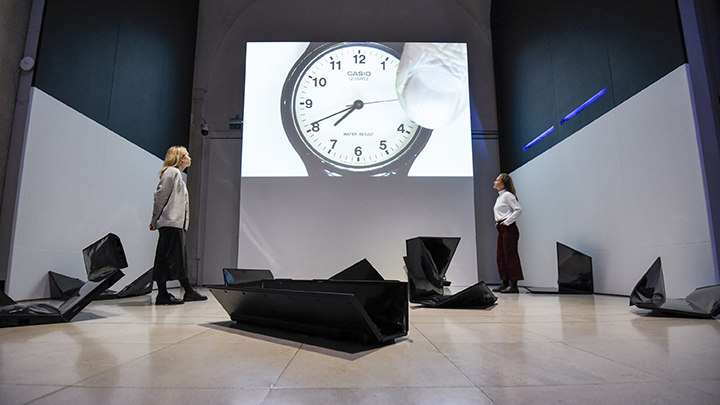
Benjamin Grosser’s Order of Magnitude (2019), a film containing excerpts of Mark Zuckerberg’s interviews, covering the earliest days of Facebook in 2004 up to Zuckerberg’s appearances before the US Congress in 2018, these recordings reveal what’s changed and what hasn’t changed about the way he speaks and what he says. The film shows him boasting the enormity of Facebook, where the edits present us with him repetitively announcing “more, more, more, growth, more than a billion, much bigger, another billion, more than a hundred billion, more efficient, growing, even more, growing by 50%, billion, more billions, many many more”.
Many have become disillusioned with Silicon Valley and its technology based corporations, and the systems and platforms, which they have co-created at the expense of our privacy. The problem is, we are the silent workforce that these companies feed on. By giving away raw data for analysis and material extraction, we fuel the machine of surveillance capitalism. Unsurprisingly, this is reflected by a significant portion of artworks in the exhibition, which are concerned with what the contemporary meaning of labour is now.
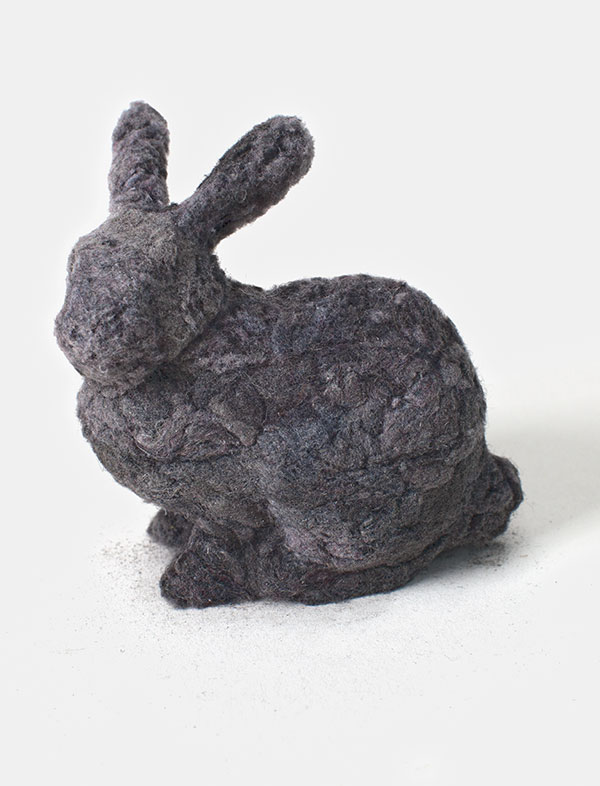
As we enter the age of acceleration and automation, much of our labour is done with the help of machines. As this happens more we will need to keep re-evaluating our position in the process. On the one hand, 24/7 seems to portray humans as slaves to the machines, while our lifestyles are twisted, over full, and packed with too much stuff. Esmeralda Kosmatopoulos presents us with her sculptures of various configurations of empty hands, the fingers arranged to show them presumably texting, holding a phone and sliding up the screen. (Fifteen Pairs of Mouths, 2016-19).
Then we have Tega Brain’s, Unfit Bits (2015), pointing to constant connectedness; relentlessly moving metronomes stimulating smartwatches for those whose insurance forces them to rely on the health and physical performance data, and then Jeremy Bentham’s famous 19th century drawings of the Panopticon.
Many of the artworks in the exhibition work to debunk the myth of immaterial labour. For instance, this is poetically illustrated by Alan Warbuton’s Dust Bunny (2015), a sculpture comprised of finely milled angora-like dust harvested from the inside of ten 3D animation workstations at visual effects studio Mainframe. The volume of dust here represents an estimated 35,000 hours, or 4 years, of constant rendering and processing.
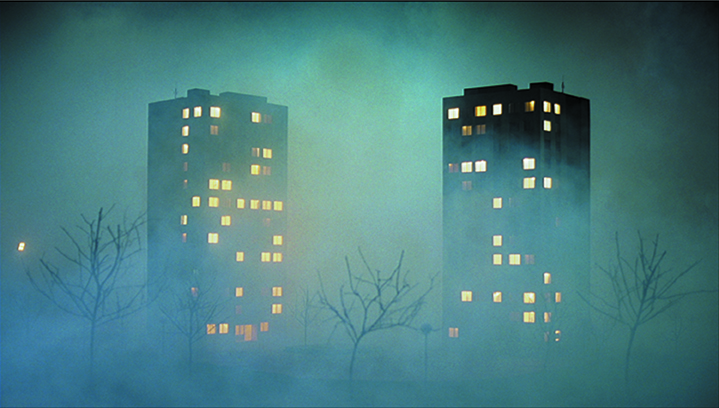
The distressing nature of social media is shown through the lens of architecture rationalising human relations in Pierre Huyghe’s The House Project (2001). The film shows computer-generated high-rise blocks with window lights blinking in the rhythm of the electronic soundtrack by Finnish techno duo Pan Sonic and French sound artist Cédric Pigot. As the track progresses, the beat becomes heavier, faster and the lights begin to run up and down the stairs, across all floors. The two apartment blocks become musical instruments with flashing diodes, generating an eerie and creepy soundtrack.
Among this horde of artworks, there are some which allow space for contemplation. Finnish artist Nastja Säde Rönkkö, one of the Somerset House Studios’ residents, spent 6 months living and working in London without using Internet. Her letters, souvenirs and received gifts are displayed in a glass cabinet, alongside the film documenting her experiences of moving around the city and reflections on the difficulties she had encountered when she refused to use and benefit from the web. In Catherine Richards’ Shroud Chrysalis I (2000), the visitors are invited to be wrapped in a copper blanket by the gallery attendants, and savor time off technology, as the blanket blocks out electromagnetic signals emitted by mobile devices.
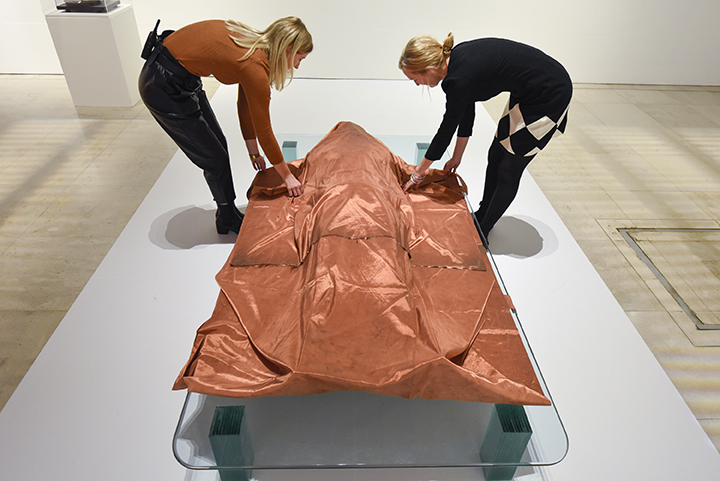
The show proposes a retreat and asks us to contemplate the world’s speed and our disconnectedness from a sense of time. At the same time, it overwhelms the space with an abundant amount of artworks, with over 50 beautiful and innovative artworks on display. And, while this diversity is one of the exhibition’s biggest strengths and should be applauded, it is also a weakness. It involved much shifting about and squeezing between displays, and tireless engagement. One’s experience of this ranged from disinterest to awe, as well as disorientation.
The exhibition’s theme is about time. It literally demands a fair chunk of time forcing the visitor to slow down and re-evaluate experiences and perceptions of what time means to us when its so deeply a part of the systems that are accelerating, alongside capitalist means. This big show offers us no way out of the contemporary trappings of capitalism and its intertwined, connections with time. But, it has opened up a space where we can consider it in a context where it involves the mediums and processes of, art, technology, and varied philosophical, political interjections, and observed outlooks. The exhibition presents us the visitor with an opportunity to reflect on the connected world through the experience of disconnectedness which has successfully been woven into the exhibition’s concept. The works shift and turn not with one message, but as oracles, or reminders that, there is a possibility of living differently, where we can create communities in alternative ways and highlight the value of questioning, while critically experimenting with our methods of communication. Time or capitalism, are not the main messages, but it’s more about what we do with them. It is an important and necessary exhibition that needs our immediate attention.
24/7:
A WAKE-UP CALL FOR OUR NON-STOP WORLD
is at Somerset House in London until 23 Feb 2020
somersethouse.org.uk/whats-on/247
Featured Image:
‘Slogans for the 21st Century’
Courtesy of Douglas Coupland
and Maria Francesca Moccia, EyeEm
via Getty Images
On the 20th of September, Tatiana Bazzichelli and Lieke Ploeger opened the 17th conference of the Disruption Network Lab with CITIZENS OF EVIDENCE to explore the investigative impact of grassroots communities and citizens engaged to expose injustice, corruption, and power asymmetries.
Citizen investigations use publicly available data and sources to autonomously verify facts. More and more often ordinary people and journalists work together to provide a counter-narrative to the deliberate disinformation spread by news outlets of political influence, corporations, and dark money think-tanks. However, journalists and citizens reporting on matters in the public interest are targeted because of the role they play in ensuring an informed society. The work of independent investigation is often delegitimised by public authorities and denigrated in a wave of generalisations against ‘the elites’ and media objectivity, actually designed to undermine independent information and stifle criticism. It appears to be a global process that aims at blurring progressively the boundary between what is fake and what is real, growing to such a level that traditional mainstream media and governments seem incapable of protecting society from a tide of disinformation.
An increasingly Orwellian campaign for the purpose discredit upon them has been built for years against citizens and activists opposing the project of a controversial high-speed rail line for freight trains between Italy and France, which is considered useless and harmful. The Disruption Network Lab conference opened with the keynote GHOSTS IN THE WOODS AND UNCANNY ENTITIES: On How to Cover the Italian «NO TAV» Movement by Wu Ming 1, who spent three years among the people of the Susa Valley opposing this mega-infrastructural project.

As the moderator, author, and filmmaker Alexandra Weltz-Rombach explained, Wu Ming is a pseudonym for a group of Italian authors formed in Bologna after the experience of the Luther Blissett project. For almost 20 years the literary collective has been writing essays, meta-historical novels, and creative narrative, using often the techniques of investigative journalism. Today it is widely appreciated for its capability to deconstruct and analyse complex aspects of social and political life, challenging long-existing paradigms and traditions and synthesizing the views of different minds, to build an alternative narration on facts, inspiring unconventional critical process. Wu Ming 1 explored the Susa Valley and the woods occupied by police and wire fences, experiencing the struggle of a community in its territories, to write a history-as-novel take on the most enduring and radical environmental protest in contemporary Italy, known as No-TAV (TAV stands for Treno Alta Velocità – High Speed Train). To do so, he walked, mapped the territory, and ‘evoked ghosts’. The history of a country can be described by the history of its borders and the Susa Valley is a borderland in the mountains. Probably where Hannibal walked with his army to cross the Alps, since the early 90s it has been projected another huge tunnel inside the mountains, in a long-standing tradition of railroad-tunnels built sacrificing lives and health.
To understand the No-TAV struggle we can go back in time. To when the TAV-railway was first projected, and contextually the opposition of local communities started. But also, back in time to all the conflicts that have been fought on these mountains, which are “full of ghosts” as the author said. Wu Ming 1 explained that in literature and popular tradition, a ghost appears when there is an unresolved story, a wasted life that ended badly. Borderlands are the places where the most of ghosts are to be found. In the Susa Valley, ghosts are suppressed memories of wars and of social conflicts that shaped the territory.
Wu Ming published several works on environmental and climatic issues and wrote a lot about mountains too. Almost 78% of Italian territory is covered by mountains or hills. Their iconic representation has been at time twisted by nationalism, militarism and machismo. The Alps were “sacred borders of the fatherland” – nature to conquer, a symbol of virility and power in fascist propaganda. Today those mountains are an obstacle to economic growth; a growth that might put at risk the whole Susa Valley. Thus, instead of tackling legitimate concerns, project Stakeholders have been seeking for 20 years to delegitimize those leveling the charges against the high-speed railway, despite the masses of evidence to support their claims, using intimidation and violence against them. But the no-TAV collectives’ claims have always been proven to be right, and the project has been declining in size over time. However, the fight within the Valley is still on and the TAV-project is far from being archived.

The panel on the first day, EXPOSING ABUSES: Citizens Recording Human Rights Violations from the US to The Gambia, introduced by Michael Hornsby of Transparency International, opened with a presentation by Melissa Segura, journalist of BuzzFeed News from the US. She documented allegations proving that the Chicago police officer Reynaldo Guevara had framed dozens of innocent people for murder. The reporter put a light on forgotten judiciary cases, giving voice to families and communities affected by injustices, hit by a profound brokenness that she experienced herself when her nephew was framed and arrested years before.
A group of black and Latino mothers, aunts, and sisters knew that their beloved were innocent, but no officials wanted to take up their cause. Segura met these women after they had been fighting for decades in search of justice. They began when the journalist was at her elementary school: “at the time they had already gathered in a team, collecting data and writing spreadsheets on Lotus” she recalled. They had no chance to be heard, no PR, no lobby, no support from media were available to them. Segura realized soon that the story she had to cover wasn´t just the conviction of a 19-year-old-boy sentenced in 1999 with 110 years of prison for a murder he did not commit. It was also about the community of women that were fighting for justice, it was about their lives.
She learnt soon that her sources were able to cover their own stories much better than how she could, showing her new paths to the truth. The journalist dedicated time to building a trusting relationship with them, giving full reassurance that their story would be fairly reported. After an intense three-year investigation, she succeeded in wearing down a key witness to testify, cracking the wall of impunity. This process, she said, “did not expose the harm of people, but tried to connect to it.”
Reynaldo Guevara has been beating up people, framing them, extorting false confessions and false witnesses for years. Since publishing Segura’s articles, seven innocent men have been freed, and dozens more convictions are under review.
In the context of the major movements that draw attention on issues such as injustice and police violence targeting specific communities and minorities in the US, policy and data analyst Samuel Sinyangwe decided to join the work of justice activist groups formed after the 2014 police shooting of Michael Brown in Ferguson, Missouri. He is now part of the Police Scorecard project, and of the Campaign Zero independent platform he co-founded, designed to facilitate and guarantee the collection of data on these violations. Sinyangwe explained that, as of today, the US government has implemented neither collections of data on police misconducts, violence and killings, nor public database of disciplined police officers. In his view, US law enforcement agencies have failed to provide even basic information about the lives they have taken, in a country where at least three people are killed by police every day and black people are 3 times more probable to end up victims of brutal use of force by the police.
The independent observatory built by Sinyangwe seems to be quite effective. It is described as the most comprehensive accounting of people killed by police since 2013 in the US. A report from the US Bureau of Justice Statistics estimated that approximately 1,200 people were killed by police between June 2015 and May 2016. The database identified 1.179 people killed by police over this same time period. These estimates suggest that it was able to capture 98% of the total number of police killings that occurred. Sinyangwe hopes these data will be used to provide greater transparency and accountability for police departments as part of the ongoing campaign to end police violence in black and Latino communities, leading to a change of policies.
With data able to map the situation in the US, it has also been possible to make comparisons and drew analyses. The Campaign Zero researches show that there is a whole false narrative about criminality rates, based on numbers that just mirror a system based on different federal policies regarding police forces, and that levels of violent crime in US cities do not determine rates of police violence.
According to data, cities with the same density of population have very different rates of violence, and very different rules regulating the activity of police agents. Starting from this, Sinyangwe and his team decided to look for different policy documents from different police department. These policies determine how and when a local policeman is authorized to use force. With a closer look, the Campaign Zero team could easily determine that there is no federal standard. Some documents live a grey area, others discourage the use of force, and particularly of deadly force, limiting it to the most dangerous scenarios after all lesser means of use of force have failed. Some seem to openly encourage it instead.

The group listed eight types of restrictions in the use of force to be found in these policies, consisting of escalators that aim at excluding, as far as possible, the use of violence. Comparisons show that a combination of these restrictions, when put in place, can produce a large reduction in police violence. Policies combining restrictions predicted indeed significantly lower rate of deathly force.
Data about unarmed people killed by police in major American cities show that black people are three times more likely to be killed by police than white people (2013-2018). Movements such as Black Lives Matter started also because of this. Another problem is that it is extremely difficult to hold US police members accountable.
Sinyangwe underlined how it is necessary to research the components that predict police violence, and that can help hold officers accountable, to be sure that they are enforced by police departments.
Police union contracts – for example – can be considered an obstacle on the way to accountability and transparency. It is extremely rare to have a policeman convicted for a crime in the US. It is a systematic fact and it cannot be reduced just to the individuals, who are acting using brutal and deathful force. It is a matter of lack of training, lack of policies enhancing non-violent solutions, but there is also legislation that protects policemen from legal consequences. It is not easy even to sue a US policeman, as they are shielded by qualified immunity and often by confidential police records, limiting how officers are investigated and disciplined. As of today, this makes impossible to identify and punish misbehaviours, abuses, and responsibilities in most cases. According to Mapping Police Violence, a research collaborative collecting comprehensive data on police killings to quantify the impact of US police violence in communities that Sinyangwe set up, 99% of cases in 2015 have not resulted in any officer involved being convicted for a crime.
The Campaign Zero platform is designed to be a tool able to enhance participation, foster accountability and transparency. It is an instrument to prevent killings and it calls for the adoption of a comprehensive package of urgent policy solutions – informed by data, research and human rights principles – that can change the way police serve communities.
The last panellist of the day was the participatory video facilitator from the UK, Gareth Benest, who presented the “Giving Voice to Victims of Grand Corruption in The Gambia” participatory video project. It is an initiative implemented on behalf of Transparency International in reaction to “The Great Gambia Heist” investigations by OCCRP (Organized Crime and Corruption Reporting Project) revealed in March 2019, which allowed those affected by grand corruption to share their stories and present their truths in carefully edited video messages, and to give voice to those Gambians who are deprived from access to basic health, education, agriculture, and portable drinking water.
In Gambia, a truth and reconciliation commission has begun to investigate rights abuses during the 22-year-long dictatorship of Yahya Jammeh ended in 2017. OCCRP has exposed for the first time how the corrupted dictator and his associates plundered nearly 1 billion US$ of timber resources and Gambia’s public funds. Thousands of documents dated between 2011 and 2016, including government correspondence, contracts, and legal documents, bank records, internal investigations able to define in detail the level of corruption and impunity of the Gambian system.
After the end of Jammeh’s rule, authorities have declared they will shed light on corruption, extrajudicial killings, torture, and other human rights violations. It is an important process of reconciliation, but still the voices of the marginalized and rural citizens are not heard. ‘Giving Voice to Victims of Grand Corruption in The Gambia’ was meant to facilitate a process with Gambian community members to express their perspectives on local problems and ideas, translating them into a film.
Benest explained how such a project is supposed to enable these communities to focus on the issues they are affected by and move towards changing their circumstances.
The participatory video is a technique that has been used to fight injustice in different contexts for many years. Benest recalled recent projects involving a community displaced by diamond-mining, young people excluded from poverty eradication strategies, widows made landless by customary leaders, and island residents threatened with forced evictions by land grabbers. In his work, the facilitator encourages equal participation and rotation of rules within the team. Participants control every aspect of the video making, from the process to the final result. Self-directed and self-organised videos become a communication tool that allows participant to build a dialogue for positive change.

The second day of the Disruption Network Lab conference opened with the keynote speech of Matthew Caruana Galizia, WHAT INDEPENDENT INVESTIGATORS DON’T USUALLY DISCLOSE, in which he addressed issues freelancers investigating high-level corruption face in silence and isolation, often with tragic consequences. The journalist, in conversation with Crina Boros, talked about the background of his mother, the Maltese reporter and blogger Daphne Caruana Galizia, who was killed on the 16th of October 2017, outlining the risks and the outcomes of her dangerous and brave work.
Her murder had been planned in detail for a long time. Killers were arrested, but the mandators haven’t been identified yet, and the criminal investigation is not moving forward. Daphne Galizia’s family is pushing the issue internationally and within Malta, knowing that without doing something this case would just disappear from news headlines without solution. Anti-corruption investigative journalists are arrested, threatened, and killed everywhere. People just vanish, and no justice is done.
For the 15 years before her death, Daphne Caruana Galizia had been appearing in 65 court cases filed against her. Her bank account was frozen; she was a victim of media campaigns against her; and she was sued by politicians, businessmen, and other journalists too. Her son recalled when he was nine that their dog was found slaughtered, then the front door of their house was burnt down. Later on, one of their dogs was shot, and another poisoned. Threats and violence continued until their whole house was set on fire. No investigation was ever effectively put in place to find out the perpetrators of these crimes, though the journalist and her family had always pressed charges against unknown.
It is hard to be confronted with the pain and memories of personal events on a stage in front of an audience, but the issue of justice is too urgent. Even if talking about her gets more and more difficult every time, Matthew is travelling the world to keep fighting and demand justice for his mother.
Matthew had spent the last years working with his mother. The International corruption revealed by the Panama Papers – on which they were investigating – was not cause of resignations and public assumption of responsibility in Malta. Involved politicians and news outlets attacked with all available means independent journalists covering the cases. The pressure on Daphne intensified in such a way, that she was sued 30 times just in the last year before her death. In those moments she kept repeating to his son Matthew that, no matter how hopeless the situation, there is an urgency to strive to make corruption and responsibilities publicly known. The Maltese blogger was not naive, she was well aware that there was the risk of getting killed, as it happened to Anna Stepanowna Politkowskaja and many colleagues all over the world. But she did not give in.
Reviewing his mother’s life, Matthew mentioned a further aspect to consider: Daphne had to use much of her time and money to defend herself inside trials against her, which were long and very expensive. She had passion and abilities. She was so talented that she could publish a magazine about food, architecture, and design – on which she spent just a couple of days a month – to earn money enough to carry on with her independent investigation work, and pay for her legal defence.
When there is a whole system against you, you need very good lawyers, you need expertise, you need money to pay for it. The Maltese blogger spent a whole career overcoming the obstacles of a corrupted system and she self-sustained economically, making sacrifices. Although all this, still, his son Matthew and her family are convinced that the solution must come through the judicial way, using available legal instruments, and making pressure on EU institutions at the highest levels. That is why Matthew Caruana Galizia asks everybody for commitment in a demand of radical change. Malta is part of the European Union, as he keeps on repeating.

Someone has been trying to silence Daphne for years before her murder. They must have gotten to the conclusion that the only way to shut her up was an assassination, for the purpose to cancel her stories with her, as her son Matthew sadly commented. To avoid this happening, several newspapers and investigative organisations joined the «Daphne Project» a global consortium of 18 international media including Reuters, The Guardian, and Le Monde, to continue the work of the Maltese journalist. They are led by the group Forbidden Stories, whose mission is to continue the work of silenced journalists. They stand together because they think that even if you kill a journalist like Caruana Galizia, her investigations cannot be buried with her. Thanks to the Daphne Project, and the courage and determination of Daphne Caruana Galizia’s family, her investigation lives on.
Matthew stressed the fact that it’s not about the future of one politician, or of a specific criminal group. It is about the future of Malta and the EU. Journalists who defend democracy are alone when they face the repercussions of what they do. It is necessary to make sure that when there are outcomes due to effective journalism, a society trained to react and self-organise can pick up the investigative work, defend independent investigation, and ask for political accountability within a public discussion. In Malta, nothing of this ever happened, and Daphne became more isolated.
Grassroot citizens organisations are fundamental to boost activism inside local communities and demand for justice. In cases like Daphne’s, no one is going to do it if not organised citizens, together with independent journalists and organisations. Many killed journalists had neither a family nor an organisation that could fight on for them. Maltese Police seem to have never developed professional skills to effectively work on this kind of criminal cases, and the few results from recent years were from the FBI in the USA. Criminals within a system that guarantees impunity can easily develop better skills.
Moreover, in Malta, investigations have a very poor rate of success and in Daphne’s case, we just know how she was murdered. But the political atmosphere, in which this murder matured, has been untouched for these last two years, and the journalist’s family is worried the official inquiry that just started in the country is neither independent nor impartial. Members of the Board of Inquiry, they claim, have conflicts of interests at different levels, either because they were part of previous investigations or because they have ties to subjects who may be investigated now.

In the last panel of the conference, as Bazzichelli explained, the discussion focused on the connection between grassroots investigations and data analysis, and how it is possible to make sensitive data accessible without restriction and open them to the public, facilitating the publication of large datasets.
M C McGrath and Brennan Novak, introduced by moderator Shannon Cunningham, presented a tool designed to enable the publishing of data in searchable archives and the sorting through large datasets. The group builds free software to collect and analyse open data from a variety of sources. They work with investigative journalists and human rights organisations to turn that into useful, actionable knowledge. Their Transparency Toolkit is accessible to activists and citizen journalists, as well as those who lack resources or technical skills. Until a few years ago only big media organisations with particularly good technical resources could set up such instrumentation. The two IT experts decided to increase the use and the impact of open information, considering participation as a key factor to reduce the difficulties caused by relying only on media outlets or single journalists to cover complex facts or analyse large datasets.
As M C McGrath and Novak explained, Transparency Toolkit uses open data “to watch the watchers” and to hold powerful individuals and groups accountable. At the moment, their primary focus is investigating surveillance and human rights abuses, like in the case of the Hacking Team leaks in July 2015.
Hacking Team is an Italian company specialising in surveillance software and in very effective Trojans able to slip into computers and smartphones, allowing a secret and total surveillance. Four years ago, 400 GB of their data was anonymously published online, showing how the IT company had been working for authoritarian governments with questionable human rights records, to ensure they can use such software to spy on activists, journalists, and political opponents, in countries like Morocco, Dubai, Ethiopia, Mexico and Sudan. Transparency Toolkit mirrored the full Hacking Team dataset to make it more available to journalists and security researchers investigating these issues. It released a searchable archive of 200GB of emails categorized by companies, countries, events, and other subjects discussed.
Other important projects from the Transparency Toolkit team are the Surveillance Industry Index (SII) developed together with Privacy International (a searchable archive featuring over 1500 brochures about surveillance technology, data on over 520 surveillance companies, and nearly 500 reported exports of surveillance technologies), the Snowden Document Search (the first comprehensive database of Snowden documents initiated which aims to preserve its historical impact), and ICWATCH – a platform born to collect and analyse resumes of people working in the intelligence community, contractors, the military, and intelligence. These resumes are useful for uncovering new surveillance programs, learning more about known codewords, identifying which companies help with which surveillance programs, examining trends in the intelligence community, and more. ICWATCH provides a collection of over 100,000 of these resumes from LinkedIn, Indeed, and other public sources, and now searchable with a search engine called LookingGlass.
The last part of this panel was than dedicated to the Dictator Alert project, a website that tracks the planes of authoritarian regimes all over the world. Available networks censor the information about planes of intelligence, military, authorities, and heads of state. This project, run by Emmanuel Freudenthal and François Pilet with support from OCCRP, began as an open-source computer program to identify planes belonging to dictators flying over Geneva. The program mined data from a network of antennas used by plane spotters and shared its alerts via Twitter. Today, Dictator Alert uses data from ADSB-Exchange, as well as several antennas installed by the team of researchers themselves. The details of each plane captured by the antennas are compared with a list of aircrafts registered or regularly used by authoritarian regimes. When a match is found, a message is published on the website.
Freudenthal presented the methodology of acquiring information behind Dictator Alert. Some people in the audience disagreed with the panellists, arguing that a reductive definition for ‘dictator’ might questionably influence the outcomes of the project, considering that some elected leaders from countries listed as democracies are also responsible for crimes, secrets, and human rights violations. The investigative journalist responded by explaining that Dictator Alert is orientated using the Democracy Index published by The Economist. The Index appeared first in 2006, categorising countries as full democracies, flawed democracies, hybrid regimes, and authoritarian regimes, based on 60 indicators grouped in different categories, measuring pluralism, civil liberties, and political culture.
The Disruption Network Lab organised the workshop Berlin’s Sky, An Afternoon Investigation on the day following the 17th Conference. Participants gathered in the former Berliner airport Tempelhofer Feld to conduct guided research using antennas and laptops to track the sky and spot anomalies above the city.

The conference closed with the investigation by Forensic Architecture – Horizontal Verification and the Socialised Production of Evidence. Team member Robert Trafford presented the organisation founded to investigate human rights violations using a range of techniques, flanking classical investigation methods including open-source investigation video analysis, spatial and architectural practice, and digital modelling. They work with and on behalf of communities who have been affected by state and military violence, producing evidence for legal forums, human rights organisations, investigative reporters and media, as well as for arts and cultural institutions.
In Trafford´s analyses, conflict, violence, and human rights violations have become heavily mediatised and because of the “open source revolution” and smartphones, facts are often documented and relayed to the world by fragments of video material. Media sometimes report about these facts in ways which seem to make them less clear, instead of allowing better understanding. Forensic Architecture is in part a set of technical and theoretical tools for unpacking those mediatised facts, to access the truth which often exists behind and between the fragments of files that are released or leaked, to prove human rights violations. It relies on the prevalence of open source video material and tries to put an order in the fake-news and post-truth communication, offering a new model for collectively and collaboratively constructing truths. Trafford pointed out how people today, who seem to be widely rejecting the idea of institutions that they might previously have trusted to assemble facts and information, are still able to accomplish this delicate task. Often truth seems to be created elsewhere, possibly behind a wall of closed sources. The Internet and the consequent open-source revolution exploded the stability of that classic system of information, and those institutions are no longer providing truths around which people are willing or able to orient themselves. For better or worse, the vertical has been supplanted by the horizontal, Trafford said.
As those institutions falter, there is a certain breed of political actors – largely from populist and far-right parties – that have been gaining mediatic and institutional power all over the world for the last five years, encouraging the public to believe that our societies are soaked in misinformation, and that there is no possibility of reaching out and acquiring reliable facts we can all agree on and orient ourselves with.
More and more often, online and offline, we read of individuals saying that we should not trust traditional news outlets or institutions that encourage us to believe that they can guarantee independent and free information. It is under this cover of equivocation and uncertainties that the human rights violations of the 21st century are being carried out and subsequently concealed.

Forensic Architecture’s challenge is to expose this misrepresentation of things, and to offer a kind of counter truth to official versions of relevant facts. Its researchers collect little grains, clues they find inside videos, pictures, and articles that try to organise in certain ways, reassembling them into an independent analysis. By using different perspectives into ongoing practice in which the development of facts and evidence is socialized, the project encourages open and horizontal verification.
The moderator of this last session of the conference, Laurie Treffers, mentioned the idea of counter forensics. By integrating and working across different forms of knowledge, and across different institutions and disciplines – which may at times appear like they have nothing in common or that they speak in entirely different registers – horizontal verification is about unifying those for reasons of mutual protection, mutual security, and mutual reinforcement.
Trafford gave examples of Forensic Architecture’s work, such as working closely with the Gaza-based Al Mezan Center for Human Rights, the Tel Aviv-based Gisha Legal Center for Freedom of Movement, and the Adalah Legal Center for Arab Minority Rights in Haifa, when they examined the environmental and legal implications of the Israeli practice of aerial spraying of herbicides along the Gaza border.
To this end, the investigation sought to define if and how airborne herbicides travel into Gaza; how far into its territories they entered; what concentration of herbicide and what damage to the farmland on the Gazan side of the border can be calculated. The analysis of several first-hand videos, collected in the field, revealed that aerial spraying by commercial crop-dusters flying on the Israeli side of the border generally mobilises the wind to carry the chemicals into the Gaza Strip at damaging concentrations. This is a constant primary effect.
The videos used for the investigations supported the testimonies of farmers that, prior to spraying, the Israeli military uses the smoke from a burning tire to confirm the westerly direction of the wind, thereby carrying the herbicides from Israel into Gaza.
Forensic Architecture modelled the Israeli flight paths and geo-located them, compared metadata and video material, and engaged fluid dynamics experts from the University of London to look at what the potential distribution of those chemicals would be from the heights that the plane was flying, in the wind conditions that could be calculated. The investigation proves that each spray leaves behind a unique destructive signature.
“Along with the regular bulldozing and flattening of residential and farmland, aerial herbicide spraying is one part of a slow process of ‘desertification’, that has transformed a once lush and agriculturally active border zone into parched ground, cleared of vegetation,” Trafford said.
Analyses of the evidence derived from vegetation on the ground, civilian testimony, and the environmental elements mobilized in the spraying event showed that the Israeli practice of aerial fumigation at times when the wind is blowing into Gaza causes damage to farmland hundreds of meters inside the fields.

Once again, the Disruption Network Lab created a forum for discussion, to define the role of citizens in making a change in the information sphere, highlighting local and international stories, tools, and tactics for social change built on courageous grassroots reporting and investigations. The Disruption Network Lab invited guests to challenge laws that effectively criminalise journalism and whistleblowing. The conference went beyond the usual dichotomy between journalists and activists, official media and independent media, and opened up a dialogue among different expertise to discuss and present opportunities of collaboration to report misinformation, corruption, abuse, power asymmetries, and injustice.
CITIZENS OF EVIDENCE presented experts working on anti-corruption, investigative journalism, data policy, political activism, open source intelligence, video storytelling, whistleblowing, and truth-telling, who shared community-based stories to increase awareness on sensitive subjects. Bottom-up approaches and methods that include the community in the development of solutions appear to be fundamental. Projects that capacitate collectives, minorities, and marginalized communities, to develop and exploit tools to systematic combat inequalities, injustices, and impunity are to be enhanced.
Moreover, on the 29th of October, the CPJ published the 2019 Global Impunity Index, putting a spotlight on countries where journalists are slain and their killers go free. During the 10-year index period, 318 journalists were murdered for their work worldwide and no perpetrators have been successfully prosecuted in 86% of those cases. Last year, CPJ recorded complete impunity in 85% of cases. Historically, this number has been closer to 90%. All participants at the conference expressed their concern about this situation.
It is important to doubt and require a double-check over relevant news, as governments and private corporations have proved too often, that they prefer secret and manipulation to transparency and accountability. It is also important to verify constantly if media outlets, or a single journalist, are actually independent. But this shall not be used to weaken independent information and undermine the principles of particular constitutional importance regarded as ‘higher law’ on which it is based. Journalists and citizen reporters are already alone in their work.

CITIZENS OF EVIDENCE was curated by Tatiana Bazzichelli, developed in cooperation with Transparency International. It was the third in Disruption Network Lab’s 2019 series ‘The Art of Exposing Injustice’. Videos of the conference are also available on YouTube. For details of speakers and topics, please visit the event page here: https://www.disruptionlab.org/citizens-of-evidence.
To follow the Disruption Network Lab, sign up for its newsletter with information on conferences, ongoing researches, and projects. You may also find the organisation on Twitter and Facebook.
The next Disruption Network Lab event ‘ACTIVATION – COLLECTIVE STRATEGIES TO EXPOSE INJUSTICE’ is planned for November 30th, in Kunstquartier Bethanien Berlin. More info here: https://www.disruptionlab.org/activation
Image Credit:
Elena Veronese for Disruption Network Lab
Featured Image:
Graphic courtesy of Disruption Network Lab
NeMe and curator Marc Garrett, Co-Founding and Co-Artistic Director of Furtherfield, have the pleasure to invite you to Children of Prometheus at NeMe Arts Centre, Limassol. The exhibition investigates the landscape of a rapidly transforming world and how some of these shifts inform and affect our immediate environment.
The complex nature of the ancient Greek myth of Prometheus has inspired philosophers, authors and artists throughout many centuries and will continue to do so because of the powerful contradictions which it embodies which reflects the ongoing dualities present in both the human mind and physical existence. Acknowledging that the Promethean spirit lives on in the ambitions of science and technology, which in many cases defies the limits imposed upon humanity by nature, the post-modern Prometheus belongs to an organised world focused on the technology of the internet. This rapidly expanding domain, with its presumed ethos of democracy belies the technologies of data mining, fake data, targeted personalised advertising, etc used by global conglomerates to engineer/manipulate people’s perception via media into a state of hyper-real urgency by dislocating the individual from physical realities.
Yet despite the plethora of work in the field, there has not been any sustained attempt to think through the larger philosophical, sociological, economical, political and cultural implications of new technologies. A crucial methodology for this exhibition is to view these themes through the eyes of the artists. Children of Prometheus generates a visual discussion around this persistent narrative that is still very enmeshed into our contemporary context.
This exhibition was originally produced in partnership with LABoral, in Gijon, and is an extension of the Monsters of the Machine: Frankenstein in the 21st Century, 18 Nov 2016 – 21 May 2017.
AOS (Art is Open Source) was born in Italy, in 2004 as an interdisciplinary research laboratory focused on merging artistic and scientific practices to gain better understandings about the mutation of human beings and their societies with the advent of ubiquitous technologies. AOS was created by Salvatore Iaconesi (engineer, hacker, artist, designer, TED Fellow, Eisenhower Fellow, Yale World Fellow, Prof. in Interaction Design at ISIA Design University in Florence), joined by Oriana Persico (social scientist, artist) and now includes more than 200 artists and researchers from across the world.
Alexia Achilleos is a Finnish-Cypriot artist with a background in fine art, archaeology and cultural studies. Her work is concerned with cultural, political and social issues which impact identity, specifically linked with cultural heritage & tourism, colonialism and national identity politics. She explores interactions, hybridisation and power struggles – especially how a cultural object’s function can change according to geography, history and politics, and how it can be suited to the needs and interests of the adopting culture.
Egor Chemokhonenko lives and works in Cyprus. He is a programmer and open source enthusiast, and keen to mix technologies with the arts. Egor has previously collaborated as a developer with fashion and arts projects such as Lumpen Agency and Cosmoscow Contemporary Art Fair. Machine self-portraits is his second programming for an artwork using artificial intelligence.
Anna Dumitriu is a British artist whose work fuses craft, sculpture and bioscience to explore our relationship to the microbial world, technology and biomedicine. She has an international exhibition profile, having exhibited at venues including The Picasso Museum in Barcelona, The Science Gallery in Dublin, The Museum of Contemporary Art (MOCA) Taipei, and The V & A Museum in London. She is artist in residence on the Modernising Medical Microbiology Project at the University of Oxford, a visiting research fellow: artist in residence in the Department of Computer Science at The University of Hertfordshire, and an honorary research fellow in the Wellcome Trust Brighton and Sussex Centre for Global Health at Brighton and Sussex Medical School.
Mary Flanagan is a writer and artist whose practice(s) extend into science, design, psychology, and futures studies. Her encompassing work in theory and criticism, with a wide range of essays and books on digital culture, is in constant dialogue with her use of digital and material platforms to create dynamic, constantly evolving systems that reflect cultural questions and trigger reflection. She is the author of the book Critical Play: Radical Game Design, the poetry collection Ghost Sentence, co-author of Values at Play in Digital Games and Similitudini. Simboli. Simulacri, and co-editor of the collections Reload: Rethinking Women in Cyberculture and Re:Skin. Her essays and articles have appeared in Salon, USA Today, The San Francisco Chronicle, and The Huffington Post.
Carla Gannis is an artist who lives and works in Brooklyn, New York. She received a BFA in painting from The University of North Carolina at Greensboro and an MFA in painting from Boston University. In the late 1990s she began incorporating net and digital technologies into her work. Gannis is the recipient of several awards, including a 2005 New York Foundation for the Arts (NYFA) Grant in Computer Arts, an Emerge 7 Fellowship from the Aljira Art Center, and a Chashama AREA Visual Arts Studio Award in New York, NY. She has exhibited in solo and group exhibitions both nationally and internationally. She is currently Assistant Chair of Digital Arts at Pratt Institute in Brooklyn.
Marinos Koutsomichalis is a media artist, scholar and creative technologist. He was born in Athens, GR (1981) and has since lived and worked in various cities around the world. His practice is hybrid, nomadic, and ethnographic, involving field-work, creative coding, critical theory, making, lecturing, live performance, workshopping, artist/research residencies, ‘Doing-It-With-Others’, and hands-on experimentation with materials and technologies of all sorts. His artistic corpus is prolific, yet persistently revolving around the same few themes: material inquiry/exploration; self-erasure; the quest for post-selfhood. He has hitherto publicly presented his work, pursued projects, led workshops, and held talks worldwide more than 250 times and in all sorts of milieux: from leading museums, acclaimed biennales, and concert halls, to churches, industrial sites, and underground venues. He has held teaching and research positions in various academic institutions, has published a book and numerous academic/scientific articles, and is currently a Lecturer in Multimedia Design for Arts at the Cyprus University of Technology (Limassol) where he co-directs the Media Arts and Design Research Lab.
Kypros Kyprianou is an artist based in Bristol. He investigates scientific, political and cultural constructs using materials drawn from official archives, reverse-engineered objects, scenarios from film and hearsay. His practice is often collaborative, culminating in performance, video, publications and site-specific intervention.
Gretta Louw was born in South Africa in 1981 but grew up in Australia. She received her BA in 2001 from the University of Western Australia and Honours in Psychology in 2002, subsequently living in Japan and New Zealand before moving to Germany in 2007. Her work has been exhibited widely, including in public institutions such as the Kunstmuseum Solothurn (CH), Münchner Stadtmuseum (DE), National Portrait Gallery (AUS), UNSW Galleries (AUS), LABoral (ESP), and Galeri Nasional Indonesia (IDN). She was awarded the Heinrich Vetter Preis by the City of Mannheim in 2014 and the Bahnwärter Stipendium by the City of Esslingen am Rhein in 2017, as well as studio scholarships in Munich and Mannheim. In 2017, Louw was an artist in residence at MozFest in London at the invitation of the Tate and the V&A museums in collaboration with the Mozilla Foundation. Louw has also curated thematic exhibitions at museums including the Villa Merkel (DE), Furtherfield Gallery (UK), and Paul W. Zuccaire Gallery (US) and contributed essays to numerous catalogues and publications.
Lynn Hershman Leeson is an artist and filmmaker whose work has been internationally acclaimed over the last five decades. Cited as one of the most influential media artists, Hershman Leeson is widely recognised for her innovative work investigating issues that are now acknowledged as key to the workings of society: the relationship between humans and technology, identity, surveillance, and the use of media as a tool of empowerment against censorship and political repression. Over the last fifty years she has made pioneering contributions to the fields of photography, video, film, performance, installation and interactive as well as net-based media art. ZKM | Center for Art and Media Karlsruhe, Germany, mounted the first comprehensive retrospective of her work titled Civic Radar. A substantial publication, which Holland Cotter named in The New York Times “one of the indispensable art books of 2016.” Lynn Hershman Leeson is a recipient of a Siggraph Lifetime Achievement Award, Prix Ars Electronica Golden Nica, and a John Simon Guggenheim Memorial Foundation Fellowship. In 2017 she received a USA Artist Fellowship, the San Francisco Film Society’s “Persistence of Vision” Award and the College Art Association’s Lifetime Achievement Award.
Joana Moll is a Barcelona / Berlin based artist and researcher. Her work critically explores the way post-capitalist narratives affect the alphabetization of machines, humans and ecosystems. Her main research topics include Internet materiality, surveillance, social profiling and interfaces. She has lectured, performed and exhibited her work in different museums, art centers, universities, festivals and publications around the world. Furthermore, she is the co-founder of the Critical Interface Politics Research Group at HANGAR [Barcelona] and co-founder of The Institute for the Advancement of Popular Automatisms. She is currently a visiting lecturer at Universität Potsdam and Escola Superior d’Art de Vic [Barcelona].
Cédric Parizot is a Researcher at the CNRS. He is an anthropologist of politics and currently works at the Institut d’Etudes et de Recherche sur le Monde Arabe et Musulman (IREMAM, Aix en Provence). His research focuses on mobility and borders in the Israeli – Palestinian space. He has recently published with Stephanie Latte Abdallah A l’ombre du mur: Israéliens et Palestiniens entre séparation et occupation, Arles, Actes sud, 2011. He coordinates a transdisciplinary research programme involving social scientists, scientists, artists and professionals in order to elaborate a multidisciplinary approach on the mutations of 21st century Borders in Europe and the Mediterranean at the Institute of Advanced Studies in Marseille, France.
Guido Segni, aka Clemente Pestelli, lives and works somewhere at the intersections between art, pop internet culture and data hallucination. With a background in Hacktivism, Net Art and Video Art, his work is characterized by minimal gestures on technology which combine conceptual approaches with a traditional hacker attitude in making things odd, useless and dysfunctional. Co-founder of Les Liens Invisibles, he exhibited in galleries, museums (MAXXI Rome, New School of New York, KUMU Art Museum of Talinn) and art & media-art international festivals (International Venice Biennale, Piemonte SHARE Festival, Transmediale). Currently he teaches at the Accademia di Belle Arti of Carrara, directs the imaginary REFRAMED lab and he is part of the editorial committee for the project Atypo.
Alan Sondheim is an independent writer/theorist/artist. He co-founded the Cybermind and Wrytingemail lists. He is editor of Being on Line and author of .echo, Disorders of the Real and The Wayward. He is also published widely online and his video/sound work is internationally exhibited. Sondheim is the developer of the concept of code work, wherein computer code itself becomes a medium for artistic expression. He explores notions of the ‘abject’ in the masculine and feminine online, and more recently has dealt with the machinic using the language of computer code to articulate novel forms of identity in cyberspace. His work crosses over between philosophical explorations and sound poetry and more recently he has returned to the language of music using the tonalities of a wide range of ethnic instruments. His current areas of exploration include: the aesthetics of virtual environments and installations; mapping techniques using motion capture and 3D laser scanners; Buddhist philosophy and its relation to avatars and online environments; and experimental choreography.
Featured Image:
Detail from ‘The Garden of Emoji Delights Triptych’ (2014) by Carla Gannis
This 3-year programme supports our Platforming Finsbury Park initiative. Between 2019-2021 we will produce exhibitions and events that combine citizen science and citizen journalism by crowdsourcing the imagination of local park users and community groups to create new visions and models of stewardship for public, urban green space. By connecting these with international communities of artists, techies and thinkers we are co-curating labs, workshops, exhibitions and Summer Fairs as a way to grow a new breed of shared culture.
#CitSciFi – crowdsourcing creative and technological visions of our communities and public spaces, together.
The Time Portals exhibition, held at Furtherfield Gallery (and across our online spaces), celebrates the 150th anniversary of the creation of Finsbury Park. As one of London’s first ‘People’s Parks’, designed to give everyone and anyone a space for free movement and thought, we regard it as the perfect location from which to create a mass investigation of radical pasts and futures, circling back to the start as we move forwards.
Each artwork in the exhibition therefore invites audience participation – either in its creation or in the development of a parallel ‘people’s’ work – turning every idea into a portal to countless more imaginings of the past and future of urban green spaces and beyond.
For this Olympic year we will consider the health and wellbeing of humans and machines.
For this year of predicted peak heat rises we will consider how machines can work with nature.
Editors present: Yiannis Colakides, Marc Garrett, Inte Gloerich
State Machines: Reflections and Actions at the Edge of Digital Citizenship, Finance, and Art
Today, we live in a world where every time we turn on our smartphones, we are inextricably tied by data, laws and flowing bytes to different countries. A world in which personal expressions are framed and mediated by digital platforms, and where new kinds of currencies, financial exchange and even labor bypass corporations and governments. Simultaneously, the same technologies increase governmental powers of surveillance, allow corporations to extract ever more complex working arrangements and do little to slow the construction of actual walls along actual borders. On the one hand, the agency of individuals and groups is starting to approach that of nation states; on the other, our mobility and hard-won rights are under threat. What tools do we need to understand this world, and how can art assist in envisioning and enacting other possible futures?
This publication investigates the new relationships between states, citizens and the stateless made possible by emerging technologies. It is the result of a two-year EU-funded collaboration between Aksioma (SI), Drugo More (HR), Furtherfield (UK), Institute of Network Cultures (NL), NeMe (CY), and a diverse range of artists, curators, theorists and audiences. State Machines insists on the need for new forms of expression and new artistic practices to address the most urgent questions of our time, and seeks to educate and empower the digital subjects of today to become active, engaged, and effective digital citizens of tomorrow.
James Bridle, Max Dovey, Marc Garrett, Valeria Graziano, Max Haiven, Lynn Hershman Leeson, Francis Hunger, Helen Kaplinsky, Marcell Mars, Tomislav Medak, Rhea Myers, Emily van der Nagel, Rachel O’Dwyer, Lídia Pereira, Rebecca L. Stein, Cassie Thornton, Paul Vanouse, Patricia de Vries, Krystian Woznicki.
Join editors Yiannis Colakides, Marc Garrett, Inte Gloerich, contributors Max Dovey and Helen Kaplinsky, and respondent Ruth Catlow on Tue 23 Apr from 18.00-20.30 for short presentations with plenty for time for discussion.
This event is hosted at Furtherfield Commons in Finsbury Park*
*Please note this is a separate building to our Gallery and is at the Finsbury Park station entrance to the Park.
Join us in Edinburgh at the first DAOWO ‘Blockchain & Art Knowledge Sharing Summit’ of 2019
DAOWO (Distributed Autonomous Organisations With Others) Summit UK facilitates cross-sector engagement with leading researchers and key artworld actors to discuss the current state of play and opportunities available for working with blockchain technologies in the arts. Whilst bitcoin continues to be the overarching manifestation of blockchain technology in the public eye, artists and designers have been using the technology to explore new representations of social and cultural economies, and to redesign the art world as we see it today.
This summit will focus on potential impacts, technical affordances and opportunities for developing new blockchain technologies for fairer, more dynamic and connected cultural ecologies and economies.
Programme
Although the term ‘blockchain’ has trickled downstream into the public domain, the principles behind the technology remain mysterious to many. Embodied within physical assemblages or social interventions that mine, hash and seal the evidence of human practices, creatives have provided important ‘coordinates’ in the form of artworks that help us to unpick the implications of the technology and the extent to which it re-configures power structures.
Hosted by Prof Chris Speed and Mark Daniels with panellists:
Pip Thornton – The Value of Words in an Age of Linguistic Capitalism
Bettina Nissen & Ailie Rutherford – Designing feminist cryptocurrency for Govanhill
Evan Morgan – GeoPact
Jonathan Rankin – OxChain, Pizza Block
Larissa Pschetz – Karma Kettles
Contributors include:
Ruth Catlow, Furtherfield and DECAL
Mark Daniels, New Media Scotland
Clive Gillman, Creative Scotland
Marianne Magnin, Arteïa
Prof Chris Speed, Design Informatics, University of Edinburgh
Ben Vickers, Serpentine Galleries
Through two UK summits, the DAOWO programme is forging a transnational network of arts and blockchain cooperation between cross-sector stakeholders, ensuring new ecologies for the arts can emerge and thrive.
DAOWO Summit UK is a DECAL initiative – co-produced by Furtherfield and Serpentine Galleries in collaboration with the Goethe-Institut London. This event is realised in partnership with the Department of Design Informatics at the University of Edinburgh and New Media Scotland.
OxChain is a major EPSRC research project which explores how Blockchain technologies can be used to reshape value in the context of international development and the work of Oxfam, involving the Universities of Edinburgh, Northumbria and Lancaster.
Our times are characterized by the accelerating collapse and redrawing of multiple borders: between nation states, personal identities, and the responsibilities we have for each other. Also between the old distinctions, work and pleasure.
Some leaders as part of the new world order, tell us through their political actions and their fashion accessories, that they “Just Don’t Care”. This “political art-form”1 of not caring permits an insidious spread of hatred online and on the ground. In recent times, the digital condition has lent it’s networks and platforms to this poisonous, rhetorical hyperbole, turning against immigrants, and others who do not fit into the framework of a western world, oligarch orientated vision. Mass extraction and manipulation of social data has facilitated the circulation of fake news and the production of fear, anxiety and uncertainty. Together these fuel the machine of structural violence adding to the already challenging conditions created by Austerity policies, growing debt and poverty.
In the face of these outlandish difficulties our digital tools and networks – taken up with a spirit of cultural comradeship. More inspiring narratives are emerging from across disciplines and backgrounds, to experiment with new solidarity-generating approaches that critique and build platforms, infrastructures and networks, offering new possibilities for reassessing and re-forming citizenship and rights.
The exhibition and labs for Playbour – Work, Pleasure, Survival, have created new contexts for collaboration. Artists (from the local area and internationally), game designers and architects, come together with researchers from psychology and neuroscience addressing the data driven gamification of life and everything.
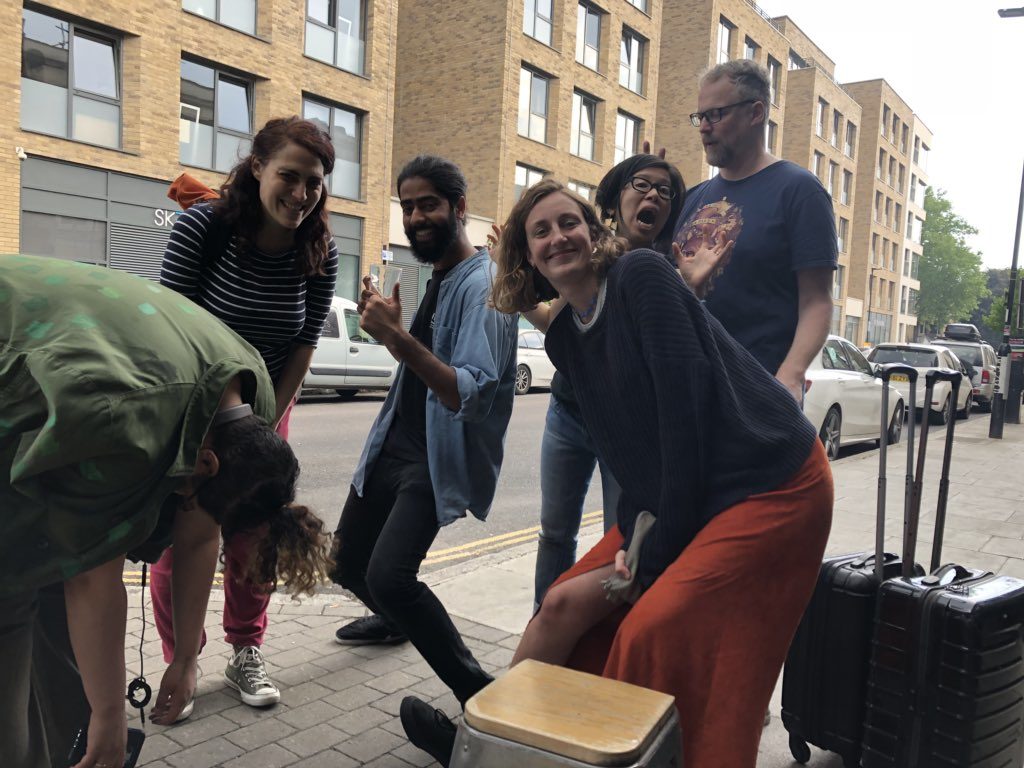
In her interview, the curator Dani Admiss discusses how they reassess the power relationships of the gallery, park users and the local authorities, asking who owns the cultural infrastructure and public amenities – and so create a polemic to open up questions of public value. The exhibition is open every weekend through 14 July to 19 August 2018.
The artists featured in Transnationalisms exhibition curated by James Bridle address the effect on our bodies, our environment, and our political practices of unstable borders.
“They register shifts in geography as disturbances in the blood and the electromagnetic spectrum. They draw new maps and propose new hybrid forms of expression and identity.”2

“Thiru Seelan, a Tamil refugee who arrived in the UK in 2010 following detention in Sri Lanka during which he was tortured for his political affiliations, dances on an East London rooftop. His movements are recorded by a heat sensitive camera more conventionally often used to monitor borders and crossing points, where bodies are identified through their thermal signature.”3
The show opens at Furtherfield from September 14th to October 26th 2018, touring as part of State Machines the EU cooperation which investigates the new relationships between states, citizens and the stateless made possible by emerging technologies.
We have another interview with artist and activist Cassie Thornton, where we discuss her current project Hologram, which examines health in the age of financialization, and works to reveal the connection between the body and capitalism. Her interview focuses on a series of experiments that actively counter the effects of indebtedness through somatic – or body – work including her focus on the way in which institutions produce or take away from the health of the artists and workers they “support”.
“In my work for the past decade, I have been developing practices that attempt to collectively discover what debt is and how it affects the imagination of all of us: the wealthy, the poor, the indebted, financial workers, babies, and anyone in-between.” Thornton
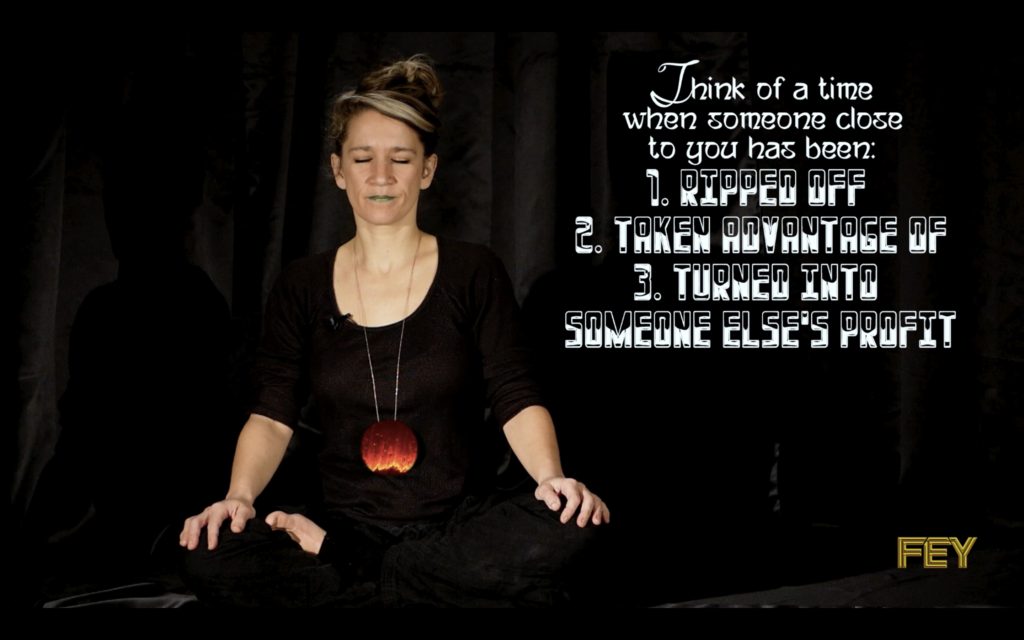
Finally I interview Tatiana Bazzichelli, artistic director and curator of the Disruption Network Lab, in Berlin, questions about art as Investigation of political misconducts and Wrongdoing. Since 2015, the Disruption Network Lab has cultivated a stage and a sanctuary for otherwise unheard and stigmatised voices to delve into and explore the urgent political realities of their existence at a time when the media establishment has no investment in truth telling for public interest.
“When the speakers are with us and open their minds to our topics, I feel that we are receiving a gift from them. I come from a tradition in which communities, networks and the sharing of experience were the most important values, the artwork by themselves.” Bazzichelli.
The programme creates a conceptual and practical space in which whistleblowers, human right advocates, artists, hackers, journalists, lawyers and activists are able to present their experience, their research and their actions – with the objective of strengthening human rights and freedom of speech, as well as exposing the misconduct and wrongdoing of the powerful.
To conclude, all one needs to say is…
“Whether in the variety of human, backgrounds and perspectives, biodiversity or diversity of technologies, coding languages, devices, or technological cultures. Diversity is Proof of Life.” Ruth Catlow, 2018.
DOWNLOAD PRESS RELEASE
DOWNLOAD GALLERY HANDOUT
SEE IMAGES FROM THE PRIVATE VIEW
In his first solo show in the UK, pioneering media artist Eduardo Kac puts poetry into space in entirely new ways and prompts us to ask “How do words work? What happens if we look at them upside down or inside out? What kind of poem could be made by an astronaut in outer space? What has poetry got to do with green bunnies?”
Kac explores how digital and other technologies provide poets with new possibilities of sound, light and movement. Even space flight offers the poet opportunities. Kac moves the poem off the page and into action. He explores the poetic possibilities of technologies ranging from digital videos and holograms to DNA manipulation and space flight, liberating poetry from the constraints of the printed page.
You can experience poems by Kac in the three rooms of Furtherfield Gallery as well as outside in the park. Follow the rabbit-shaped drawings on the paths in the park to see Poetry for Animals, Machines and Aliens in Furtherfield Gallery and installed in the field nearby.
Kac’s most famous work is GFP Bunny (2000), in which a rabbit called Alba was created in a laboratory with a gene causing her to glow fluorescent green under blue light. The artist made The Alba Flag (2001), on the outside of the Gallery next to the entrance, to celebrate Alba. Kac’s work with Alba prompted him to create a wordless language called lagoglyphs that give new expression to the bunny.
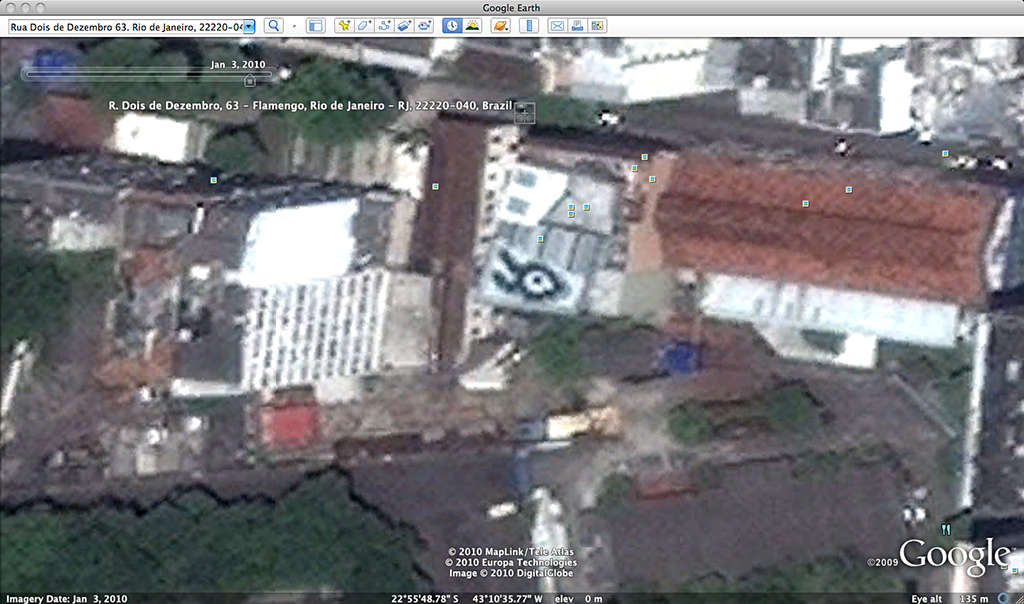
One of the highlights of the exhibition is Kac’s Lagoogleglyph, a work made for viewing from space. Covering a field in Finsbury Park it is optimised by Kac for viewing through satellite imagery and visible in Google Earth. The Lagoogleglyph is part of a series which forms a globally distributed artwork visible only from space. Earlier Lagoogleglyphs were installed at Oi Futuro, Rio de Janeiro, Brazil (in 2009) and Es Baluard Museum of Modern and Contemporary Art, Palma de Mallorca, Spain (in 2015).
Also featured in the exhibition:
In Adhuc (1991), holography alters our behaviour as readers. You cannot read the poem left to right. You must dance a little in front of it. As you do this, letters and words shift, drift away and colours change.
Inner Telescope (2017), performed by the French astronaut Thomas Pesquet in the International Space Station, is poetry for zero gravity. The form has neither top nor bottom, front or back, left or right. Sometimes it looks like the French word MOI (me). At other times, it looks like a human figure with the umbilical cord cut. It is the first poem to be made in outer space.
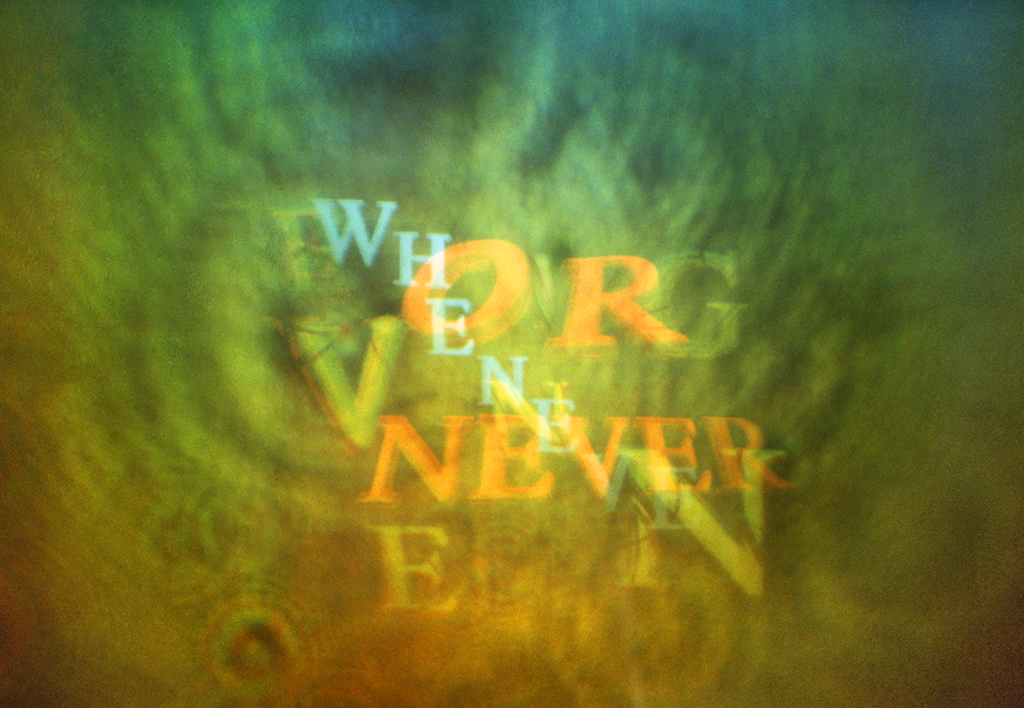
Let’s Fill this Park with Rabbits!
Free family Workshops
Sat 7 April, Sun 22 April & Mon 7 May, 11am – 4.30pm
Furtherfield Gallery
Families and groups of all ages are invited to join artist Michael Szpakowski to design their own giant rabbits and draw them on Finsbury Park by walking your own rabbit route using GPS software. Just turn up on the day to book a place for your group – workshop places will be offered on a first-come first-served basis on each day. Groups and families can also just turn up on each day to join in with the fun and walk some bunny routes in the park.
FREE
Arts and Humanities Research Council Digital Transformations Workshops
Inspired by and building on the Kac exhibition, these workshops will draw together themes and issues which have emerged from the AHRC thematic research programmes including Translating Cultures, Science in Culture, Care for the Future and Connected Communities.
More info
Digital Transformations and Community Engagement
18 April 2018, 10.30am – 4pm
Furtherfield Commons
How can we promote collaboration between communities and academic researchers? Do digital methods help create community engagement?
FREE | booking essential
Reconnecting Artistic Practice and Humanities Research
25 April 2018, 10.30am – 4pm
Furtherfield Commons
Can a renewed dialogue between humanities scholars and artistic practice provide innovative perspectives to confront current social and cultural challenges?
FREE | booking essential
Language and Diversity
8 May 2018, 10.30am – 4pm
Furtherfield Commons
Exploring the role of language and translation in promoting understanding and communication within, between, and across diverse cultures.
FREE | booking essential
Science in Culture
23 May 2018, 10.30am – 4pm
Furtherfield Commons
How can art engage with science and technology? And how can art explore the role of science in culture?
FREE | booking essential
Further Eduardo Kac exhibitions are being held in London during 2018 as part of the AHRC Digital Transformations theme. During June, the Horse Hospital, Colonnade, Bloomsbury, London WC1N 1JD, will host an exhibition called … and the Bunny Goes Pop!
This exhibition forms part of research undertaken by the Digital Transformations strategic theme of the Arts and Humanities Research Council. It has been curated by Professor Andrew Prescott of the University of Glasgow with assistance from Furtherfield team and Bronac Ferran, with advice and support from the artist.
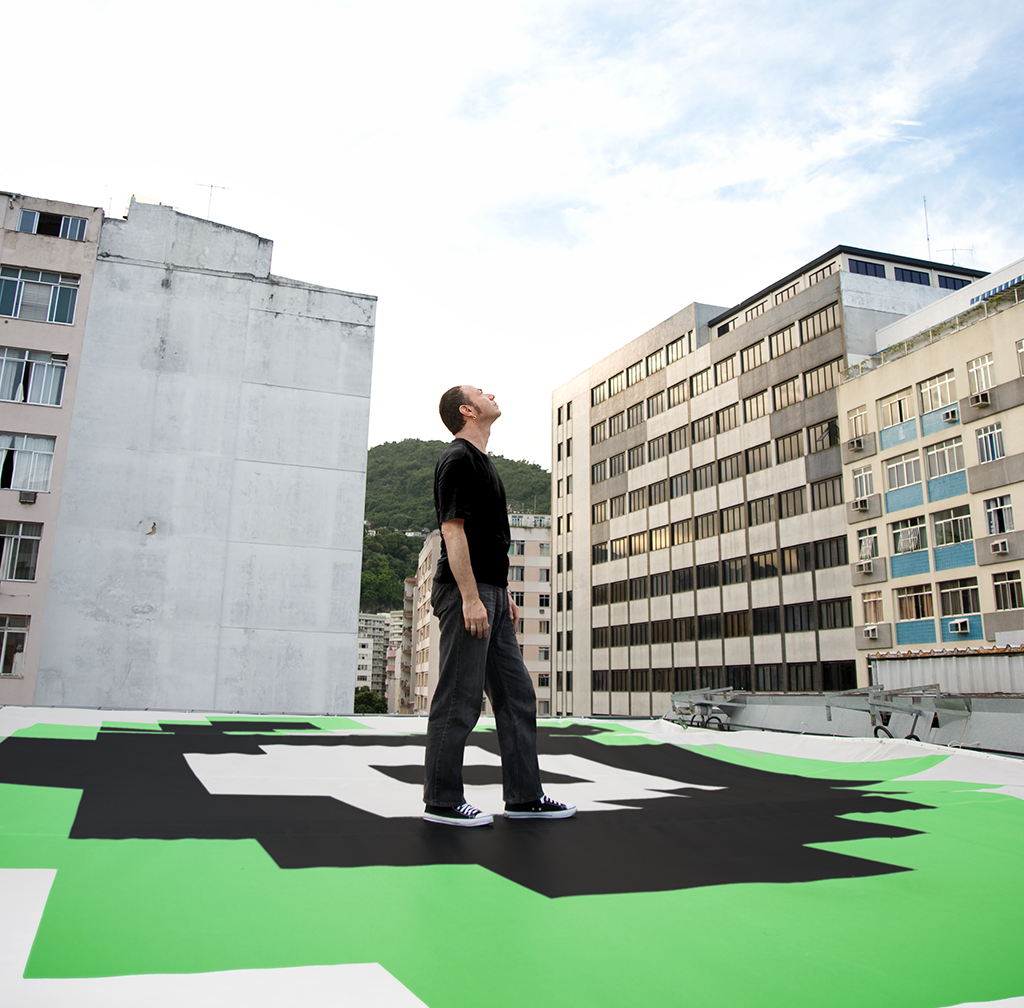
Eduardo Kac has been a pioneer in exploring the use of new technologies to create innovative poetic experiences. Experimenting with a range of technologies since the 1980s including fax, photocopiers, LED screens, the French videotext service Minitel, holography, conductive ink, and a variety of digital and network technologies. Kac’s distinctive body of work has been featured in exhibitions in New York, Paris, Rio de Janeiro, Madrid, Shanghai, Tokyo and many other venues. He has received the Golden Nica Award, the most prestigious award in the field of media arts and the highest prize awarded by Ars Electronica. This is his first solo exhibition in the United Kingdom.
Andrew Prescott, Professor of Digital Humanities at the University of Glasgow and Theme Leader Fellow for the ‘Digital Transformations’ strategic theme of the Arts and Humanities Research Council.
Furtherfield is an internationally renowned arts organisation specialising in labs, exhibitions and debate for increased, diverse participation with emerging technologies. At Furtherfield Gallery and Furtherfield Lab in London’s Finsbury Park, we engage more people with digital creativity, reaching across barriers through unique collaborations with international networks of artists, researchers and partners. Through art Furtherfield seeks new imaginative responses as digital culture changes the world and the way we live.
Furtherfield Gallery
McKenzie Pavilion
Finsbury Park, London, N4 2NQ
Visiting Information
The word speculation is defined as ‘the forming of a theory or conjecture without firm evidence’. The act of speculating was predominantly popularised with the rise of the stock market, however, recent environmental destruction and technological advancements have prompted a rich pool of speculation about the future of our planet, our species and our connection to other facets of life. Tomorrows: Urban Fictions for Possible Futures is such an exhibition, compromised of imaginative narratives speculating the future of our cities – how they will look, how they will function and the degree by which these cities will form new types of citizens directly operating within the network of that future city. In the context of the exhibition’s content, fiction is transformed into mighty medium, utilised to share the ideas of thirty-two individual and group projects. These projects envision and share their anticipation for the future as a means of addressing socio-economic, environmental and other issues we face today with a goal to reassess of our presence on the planet.
Tomorrows was curated by Daphne Dragona and Panos Dragonas, and organised by the Onassis Cultural Centre in Athens – a city experiencing continual fluctuations since the end of World War II. The location itself, Diplarios School (a place of former learning and listening), stresses the aspect of sharing and the telling of important narratives determining the shaping of the future. The exhibition begins with a didactic, yet absolutely accessible approach to understanding the notion of developing a future city. As a starting point, the exhibition borrows and advances the ideas of Doxiadis’ speculative plans of an Ecumenopolis from 1959-1974. More particularly, we must take into consideration the term ‘ekistics’ which was coined by Doxiadis in 1942 as derived from the ancient Greek noun οίκιστής, meaning a person who installs settlers in a place or creates a settlement.
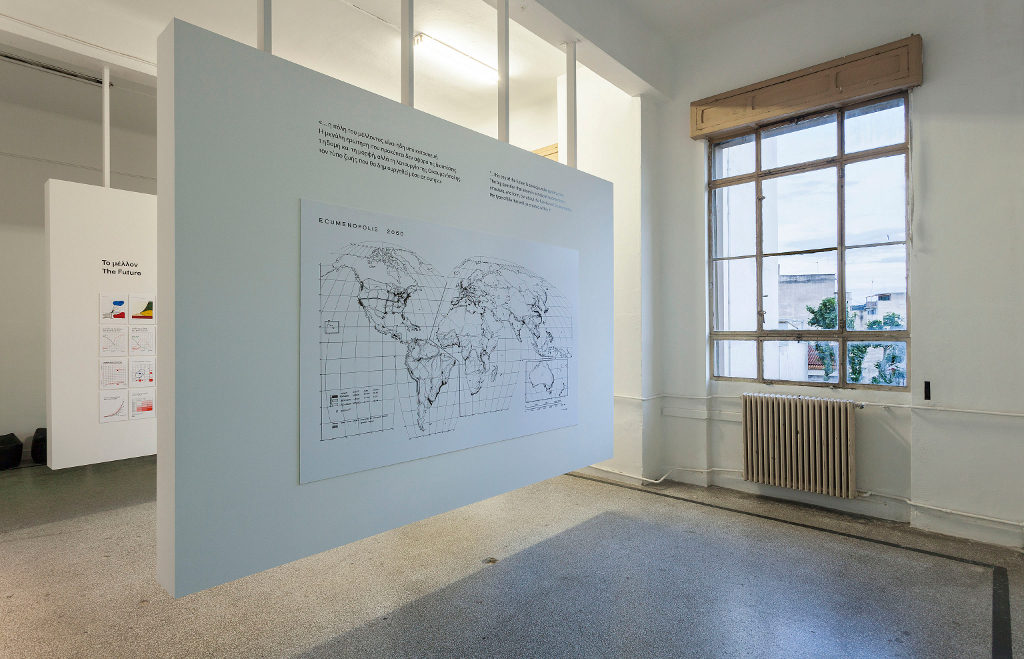
In order to create the cities of the future, we need to systematically develop a science of human settlements. This science, termed Ekistics, will take into consideration the principles man takes into account when building his settlements, as well as the evolution of human settlements through history in terms of size and quality. – Doxiadis
Doxiadis was a visionary and the decision to reinstate his work within the framework of the exhibition was incredibly rewarding for visiting audiences. He anticipated that cities were to become more than global in order to accommodate an ever changing human and non-human environment – as one huge network perhaps out of the control of human capacities. Ecumenopolis is installed on large hanging panels in the first room of Tomorrows and acts as a reference point to the five themes developed: Post-Natural Environments, Shells & Co-Habitats, Networks & Infrastructures, Algorithmic Society and Beyond Anthropos. These themes resonate to the acceleration of our urban development hybridising the natural with the artificial, future network infrastructures of our habitats becoming dependent on inhuman mediation, the possibility of an omnipresent and undemocratic structure within the city through the interdependence of economy, ecology and technology, possible forms of organisation to encourage modes of co-existence within the city, and technological singularity as challenging human sovereignty within our future cities. Doxiadis work gives way to the participants who are primarily artists, architects and designers, to explore these imminent futures of our present planet’s landscape.
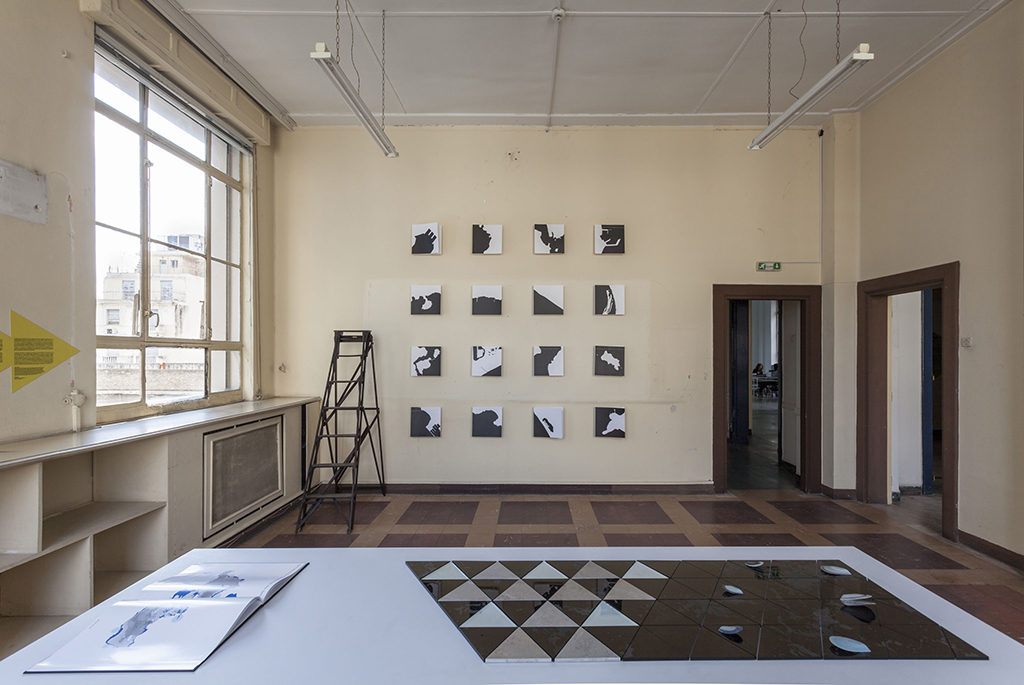
Coastal Domains is an on-going research project exploring the future landscaping of coastal territories in the Northeastern Mediterranea facilitated by Demetra Katsota along with 4th and 5th year students at the Department of Architecture, University of Patras. The installation Coastal Domains was made up of sixteen books, acting as case studies, secured on the wall and a ladder to reach them, encouraging brave visitors to climb and read them – a curatorial decision simultaneously inspiring participation and learning as it is explicitly reminiscent of old archival libraries. The 7th book in the series of sixteen engaged with the coast land of Kanoni and its Sea Lane on the island of Corfu, the research undertaken by Stella Andronikou and Iasonas Giannopoulos. As with each book in the series, the research was made up historically archived material, such as cartographical maps from different centuries and topographical material including the arrangement of roads and different fauna on the island thus unveiling issues of coastal development, the implications of an upsurge of tourism in the 1970s and possible environmental issues. Coastal Domains speculates and designs possible structures for the reinforcement of sustainability, devising various strategies that can protect the coasts of the Mediterranean Sea.
Tomorrows is particularly involved in engaging its locality of the Mediterranean, treating it as a microcosm for observing the implications of the future’s development. Silo(e)scapes by Zenovia Toloudi envisages a hybrid of a seed bank and museum for Mediterranea plant species as a tool inspiring a sharing economy. The installation of Silo(e)scapes required the audience to cradle themselves into the centre of the structure in order to experience the transparent silos-displays of the community LEGO labourers sharing their local seeds at the seedbanks. The audience suddenly find themselves in a possible future reality, all encompassing of agrarian sounds and 360 views of kaleidoscopic mirrors that trick perception of your depth of field. Almost theatrical, Silo(e)scapes is immersive and constructs a space where the audience is directly in conflict with the imminent shortage of supplies due to harmful environmental issues and increasing urban development. The audience becomes entirely physically encased in Silo(e)scapes, as a result inciting the plausibility of this future reality.
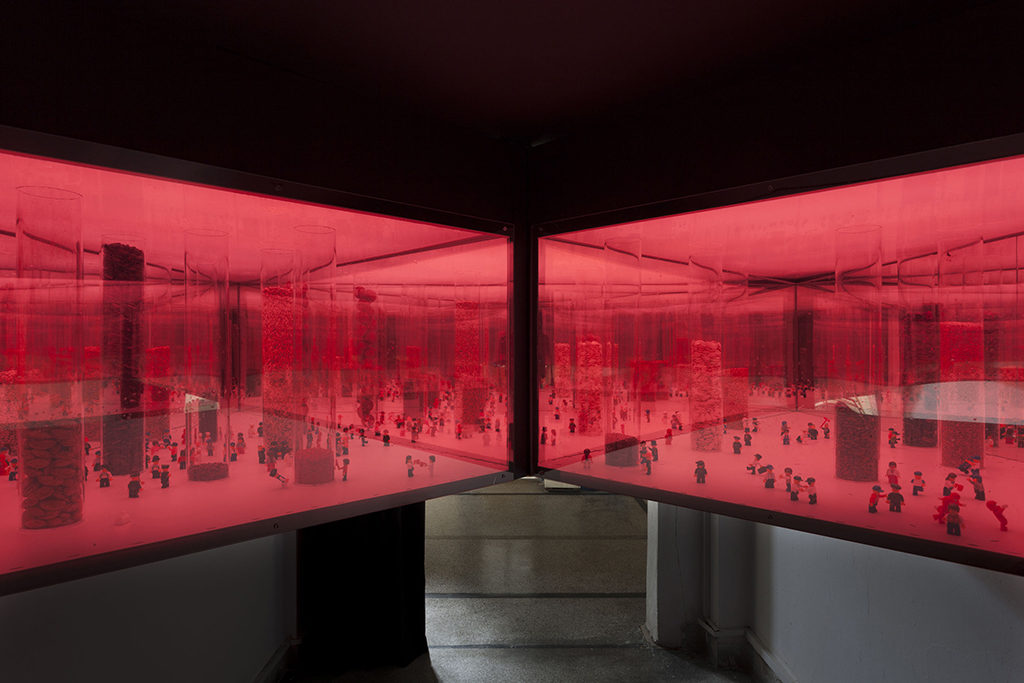
A Cave for an Unknown Traveler by Aristide Antonas introduces another form of habitable landscape for the possible future. The installation is structured like a ‘fake archaic cave’ that is buries inside it a structure as luxurious as a modern hotel room, invisible to the eye from the outside. The installed structure of the cave is complimented by a large sketchbook denoting the various features of the Cave for an Unknown Traveler. Antonas’ work brings to mind the concept of Plato’s Allegory of the Cave. The infrastructure and services within Antonas’ cave can be taken in context of the prisoner’s in Plato’s cave perceiving shadows as objects when in fact they are a mere representation of their physical form grasped by our mind. In this context, Antonas’ invisible cave begins to resemble an imagined safe haven for a traveling passer-by.
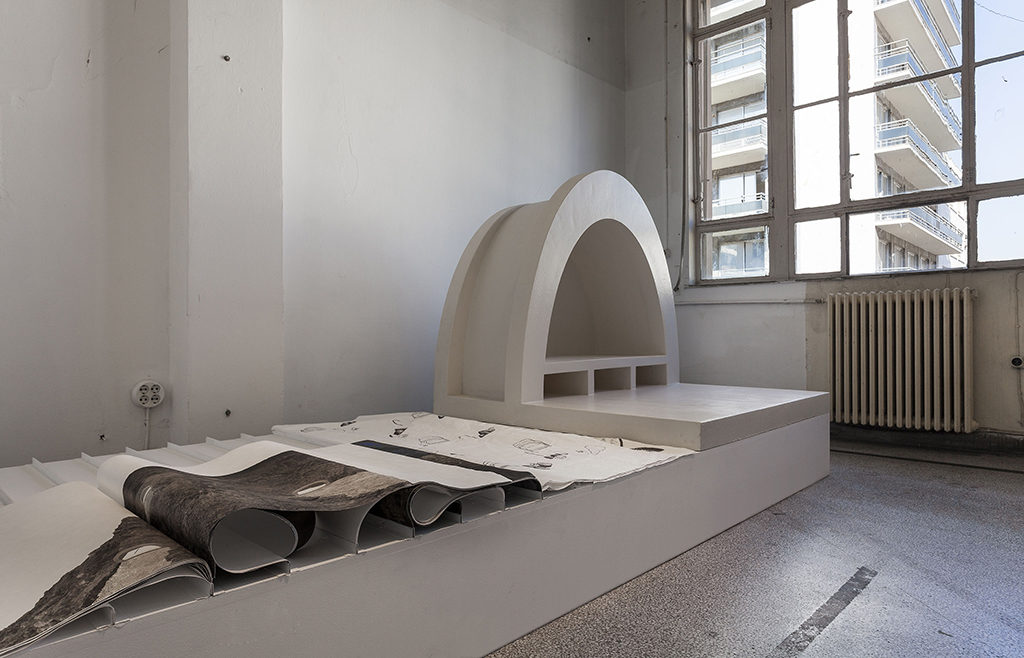
The highlight of Tomorrows is undoubtedly Liam Young’s commissioned work Tomorrow’s Storeys – a two-channel video installation isolated in a dark room with modular seating. The title of the work acts with a double meaning as in storeys of a building and the stories being told through them. The content, or stories, narrated in Tomorrow’s Storeys were first conceived in a workshop in mid-March as part of the programming to the run-up of the exhibition opening in mid-May. The workshop of visual artists, authors, photographers, directors and architects produced an abundance of local stories in the future city of Athens, particularly a future Athenian apartment block. In Tomorrows Storeys all apartments blocks have the ability to reorganise themselves automatically – modular entities like seating in the installation. The videos convey intricately detailed shots of the façade of these apartments as well as its contents recalling film shot by aerial drones and ads for IKEA products. The audience act as omnipresent eavesdroppers drifting from storey to storey into the conversations and local happenings in these apartment blocks. These apartment blocks of the future have found a way to reorganise themselves where Athenians are not given a minimum basic income but instead a minimum basic floor area – the occupants do not own an apartment but a specific volume of space which does not have a fixed location. Amongst these stories of shifting permanence and impermanence one stood out: that of an old grandmother dying and the family arguing about who takes over her volume of space as one character cries quite humorously “Can’t you wait until the funeral?!”. Tomorrows Storeys are part of a city where bots constantly reorganise your living in a form of urban computation according to best fit the needs of its citizens. In this way, a living space becomes a temporality, alluding the audience to question if their home is real if it always available for smooth transition to another space.
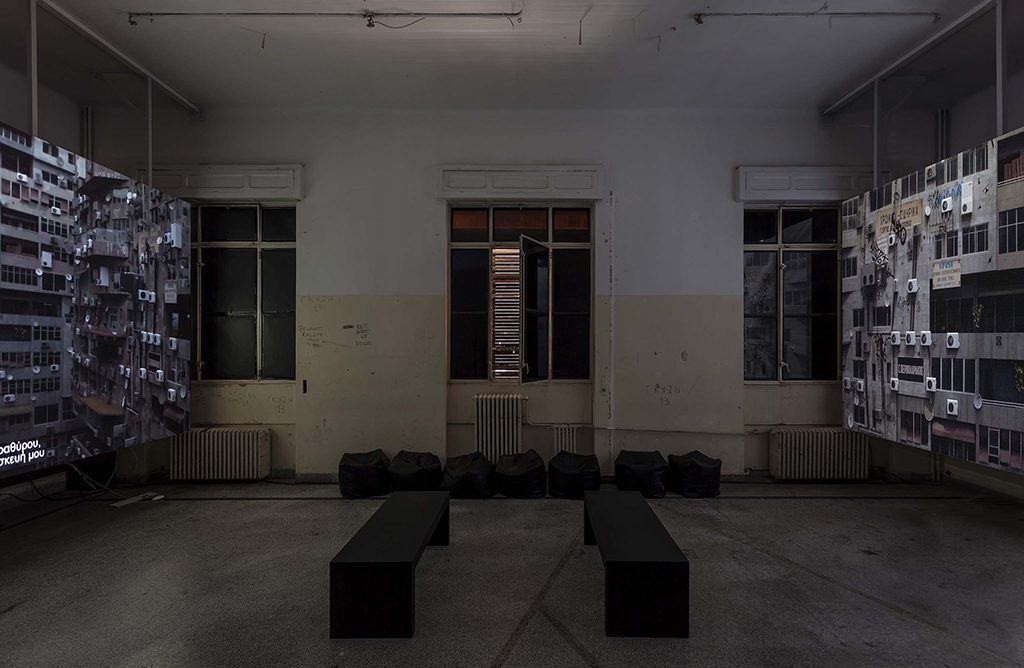
Within urban infrastructures are the human entities contained within them, as Young’s work emphasises, however some of these are becoming increasingly inhuman as the theme of ‘Beyond Anthropos’ suggests. The notion of inhuman or machinic entities being able to replicate human form and intelligence is common and highly popularised since the 1980s as films such as Bladerunner introduced global audiences to ‘replicas’. Today, AI is becoming so intelligent that it urges inventors such as SpaceX and Tesla CEO/founder Elon Musk to warn for correct precautions to be taken when engaging with AI, in fact comparing it to ‘summoning the demon’ and naming it ‘our biggest existential threat’ in the 2014 AeroAstro 1914-2014 Centennial Symposium by MIT. The work of !Mediengruppe Bitnik, coming only a couple of years after Musk’s interview, exemplify the relationship between human and machine. Ashley Madison Angels at Work in Athens is a research project initiated after the data of the Canadian online dating service was leaked in 2015. The leak revealed that Ashley Madison had created 75,000 female chatbots that catered to 32 million mostly male users, engaging them in costly internet intimacy. In Athens, there were 165 fembots for around 22,910 registered users. The installation was comprised of seven of these 165 fembots active in Athens, and were installed in a room dimmed by a fluorescent pink light with screens on tripods similar to average human height and alluding to a physical form. The fembots, programmed to be of different ages, utter pick-up lines they are allocated from a predetermined list to the 22,910 registered users who could not distinguish that they were talking to a machine and not a real person.
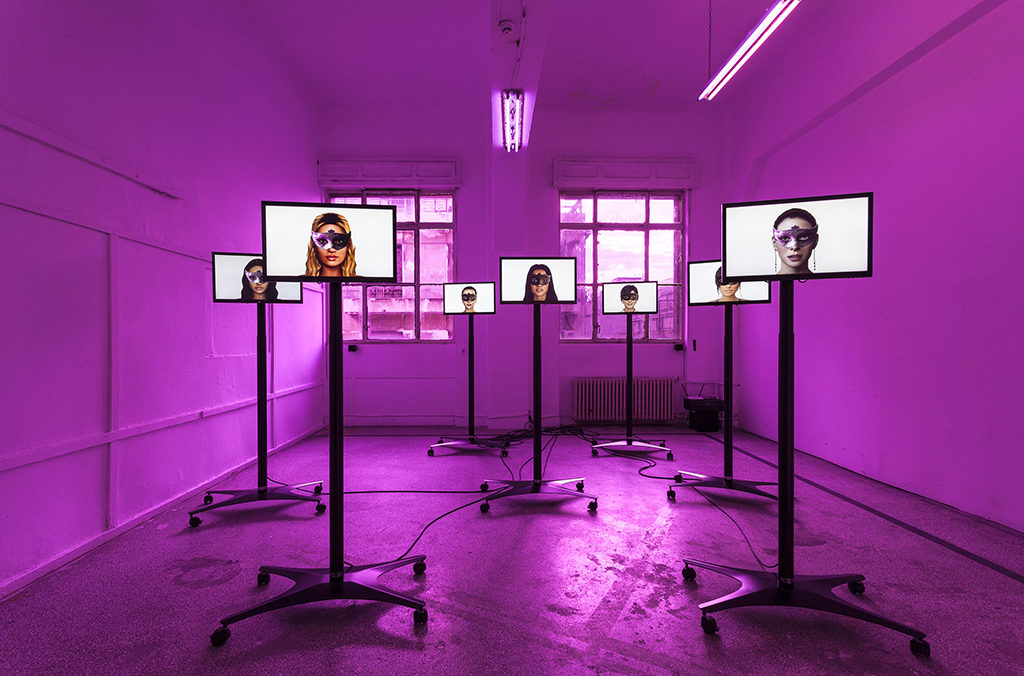
Tomorrows does not wish to present us a future as a prediction or as a form of critique of these technological, environmental and urban developments. Rather, it presents the future as an on-going participatory project, as a tool that can be utilised to examine who we are and where we are at in present tense, as well as where we could be potentially going. These urban fictions of our possible futures, are a speculative activity with the capability of making us more aware of the changes that have taken place whilst simultaneously illustrating the changes that are afoot. Tomorrows was a show that took place over six months ago, but its value to the discourse of the future will remain timeless for decades to come.
DOWNLOAD PRESS RELEASE
The blockchain is widely heralded as the new internet – another dimension in an ever-faster, ever-more powerful interlocking of ideas, actions and values. Principally the blockchain is a ledger distributed across a large array of machines that enables digital ownership and exchange without a central administering body. Within the arts it has profound implications as both a means of organising and distributing material, and as a new subject and medium for artistic exploration.
This landmark publication brings together a diverse array of artists and researchers engaged with the blockchain, unpacking, critiquing and marking the arrival of it on the cultural landscape for a broad readership across the arts and humanities.
Contributors: César Escudero Andaluz, Jaya Klara Brekke, Theodoros Chiotis, Ami Clarke, Simon Denny, The Design Informatics Research Centre (Edinburgh), Max Dovey, Mat Dryhurst, Primavera De Filippi, Peter Gomes, Elias Haase, Juhee Hahm, Max Hampshire, Kimberley ter Heerdt, Holly Herndon, Helen Kaplinsky, Paul Kolling, Elli Kuru , Nikki Loef, Bjørn Magnhildøen, Rhea Myers, Martín Nadal, Rachel O Dwyer, Edward Picot, Paul Seidler, Hito Steyerl, Surfatial, Lina Theodorou, Pablo Velasco, Ben Vickers, Mark Waugh, Cecilia Wee, and Martin Zeilinger.
Read a review of the book by Regine Debatty for We Make Money Not Art
Read a review of the book by Jess Houlgrave for Medium
Hi Shaina! Tell us about the genesis of CAMP? How are you part of it? Why are you called CAMP?
CAMP came together as a group in 2007, initially consisting of me, Shaina Anand (filmmaker and artist), Sanjay Bhangar (software programmer) and Ashok Sukumaran (architect and artist) in Mumbai, India. The intersection of our skills and different backgrounds created a vital spark in which to experiment with technology and ask deep questions about form and ways of making radical political work. We are called CAMP as we are not an artist’s collective (though we began as a collaboration with KHOJ which was an artist’s collective in Delhi, which you headed operations for) but we call ourselves a studio. In this process, we try to move beyond binaries of art vs non-art, commodity market vs free-culture and to build media for the future. Personally, it gives me the platform to eschew conservative approaches to documentary filmmaking with “the colonial male gaze.”
How did you decide to create new-media and be part of CAMP coming from a strong documentary tradition?
Oh, for that I would like to describe the response my younger self (1992-2004) had to making traditional documentaries. Travelling around India with my mentor, filming a documentary about life in villages for the anniversary of Indian independence, I described how they’d turn up in jeeps, find the subjects, and ask important questions for the nation. I became increasingly disillusioned by what I saw as the repeated orchestration of finding a subject, interviewing, zooming in, asking questions until the subject ends up crying. So, once while analyzing the relationship between filmmaker and subject I echoed the question hovering over so many discussions, “who speaks for the subject and from where?”
That’s when I decided that I had two choices, to either move into fiction which was perhaps less problematic, or to “stay with the trouble”, to let the problems drive the work into becoming something more in line with my politics. I also wanted to “trouble” the triangular relationship of author, subject and technology, so that it favored the subject more.
Very interesting! You mentioned Haraway’s “staying with the trouble”. Were you influenced by her work? Say more! I relate to that experience, having switched from working in Bollywood to doing social documentaries and now learning new-media art. So, what role do you think technology plays in fostering that relationship between the subject and the author and more importantly, how does it “favor” the subject?
Well, yeah. I feel influenced by her as a woman media-maker where I draw from her reflections on race, technology and gender. In CAMP’s work at various biennials, I have often felt that every part of the process of documentary-making had been deftly unpacked and put back together again to reflect vital contemporary political concerns within the actual structure of the work or even its distribution, not just its content. By that, I felt we succeeded in using technology to foster that relationship.
I find it fascinating that technology is not a toy or gimmick in your work but rather gives to access to places and people which traditional approaches to documentary wouldn’t. In this context, could you throw some light on the use of CCTVs in your work esp. at a time when they were increasingly being used as a tool for surveillance?
In our work Al jaar qabla al daar (The Neighbour before the house- 2009), we used CCTV cameras and set them up to film the houses where eight Palestinian families had been forcibly evicted and are linked to remote controls in new homes or refugee places where the families now live. We were then able to zoom and tilt the cameras to spy up washing or as they went about their business. The complexities of the power relations between the observer and observed are dazzlingly deft and agile, giving energy to the otherwise hopeless situation of displaced Palestinians in Jerusalem. We only hear their voices as they trace the lines of personal memory in their old neighborhoods or stalk the new inhabitants of their former homes with the remotely operated CCTV placed on nearby rooftops. We see soldiers training, Orthodox Jews going to prayer, a boy skateboarding, roofs, water tanks, a veranda built by their own families. Their bodies exert a ghostly presence on the very image we see onscreen as a small boy exhorts his mother to “zoom, zoom”– to spy on one of the new inhabitants leaving the house. But nonetheless through the active manipulation of this technology we had “captured” a settler.
Do you think technology facilitates a democratic or rather liberal exchange for the subject? Let’s say immersive technologies like virtual and augmented realities, which I’m interested in, blur the point of view of the author and the subject. What do you think?
The act of wrangling the technology to record the voices of the camera operators while simultaneously filming does create a power shift. For example, in our work, the Palestinian families may be physically invisible in the places they once lived, but their voices and ability to control how we see with even the crudest of cameras, exerts its own pressure. It acknowledges and celebrates the democratization of the camera and makes us question the veracity of all the other images we have seen about Palestine. We hear details about the neighborhoods, how the evictions happened through impossible laws or enforcements as the displaced families observe how the new families don’t clean the stairs or water the lemon tree.
Yes, I liked the use of the footage as a timeline for viewers to edit which led you to form Pad. Ma (Public Access Digital Media Archive) which I was a part of too, at some point. Interestingly, here at UCSC, I met and heard Bernard Stiegler who had long ago worked with annotating found-footage with his students thereby that puts CAMP in that discourse. Say something about that.
Well, for me, the most radical and exciting approaches to documentary were in the 60s in India. Since then, what has changed? Nothing here. CAMP’s work provides a sense of new possibilities as it steals back technology and puts it into that utopian discourse of Stiegler and others to shift our perspective closer to the subjects. By “troubling” the traditional methods of creation and dissemination it empowers both the viewer and the viewed with a fresh perspective.
Some of your work is about migrant population, home and displacement which strikes a chord with my interest in human-rights and immigration. Tell us about this work and its approach.
A privileged perspective into the worldview of another is contained in our work, From Gulf to Gulf invited by the Sharjah Biennial a few years ago.Yet again it is a document of a much richer process that began as an artwork/ community provocation/ friendship built over four years between CAMP and a group of sailors from the Gulf of Kutch in India. Initially CAMP produced radio programs culling material from sailors’ songs, conversations, phone calls etc. and later that evolved into a new-media piece that showed this totally different space in a radically fresh way. It is composed of footage of their journeys and extended selfie- films shot by the sailors on their long voyages, often accompanied by songs which they Bluetooth to each other.
Fascinating! Lastly, I’m keen to hear about what CAMP wants to do with technology next?
At any given time, CAMPwants to challenge the triangular relationship of author, subject and technology, thereby splintering the privileged gaze and our standard mode of perception. That’s our motivation behind whatever we have or will do.
Thank you Shaina for speaking as an artist from CAMP. It was great to talk to you and have worked with you all!
Compiler is an experimental platform organised by curator Alisa Blakeney, artist-curator Tanya Boyarkina, artist Oscar Cass-Darweish and choreographer Eleanor Chownsmith, all currently students of MA Digital Cultures, Goldsmiths. The platform is being built in order to “support collaborative, process-driven projects which connect artists and local communities in networks of knowledge-exchange”.
The organisers of Compiler describe it as a kind of ongoing prototype, a structure constantly negotiating the openness to maintain links to varied practices with the coherence of framing, containing, and describing some of the complicated products of digital-analogue interactions. Their focus is looking at what ‘digital culture’ means and having a productive conversation about it.
From 6-8 April, the first Compiler, Play Safe took place downstairs at OOTB in New Cross. The exhibition examined practices of surveillance inherent in “states, corporations, technological spaces and the idioms of digital art”. It questioned whether an increasing intensity of surveillance is linked to control, extraction and politics, or can be understood as a pleasurable phenomenon. People were invited to “Dance a website, see through the eyes of a computer, and have our cryptobartender mix you a cocktail to cure your NSA woes”. The work on show, made by students from MA Computational Arts and MA Digital Cultures (both Goldsmiths), included Eleanor Chownsmith’s software and performance which turned website HTML into dance routines, Michela Carmazzi’s photographic project documenting the reactions of Julian Assange and his supporters following the United Nations’ ruling about his case, and Saskia Freeke’s machine which repeatedly and intentionally failed to create a ticker-tape parade using sensors and fans.

An exhibition on the theme of surveillance creates a strange grey area for itself when shown in a building with nine screens of CCTV footage. Oscar Cass-Darweish’s project made a fairly direct link to the CCTV cameras which emphasised this greyness. The project produced a rendering of the exhibition space by using a function usually found in motion detection processes. This function calculates the difference in pixel colour values between frames at a set interval and averages them, creating a visual output of how machines calculate difference over time.
Another work which made links with the room upstairs was Fabio Natali’s Cryptobar, where following an interview with the ‘bartender’ about your data privacy needs you were recommended a cocktail of data-encryption software. Upstairs you could buy, and drink, a cocktail with the same name (the Cryptobar was part of the V&A Friday Late on Pocket Privacy on 28 April).
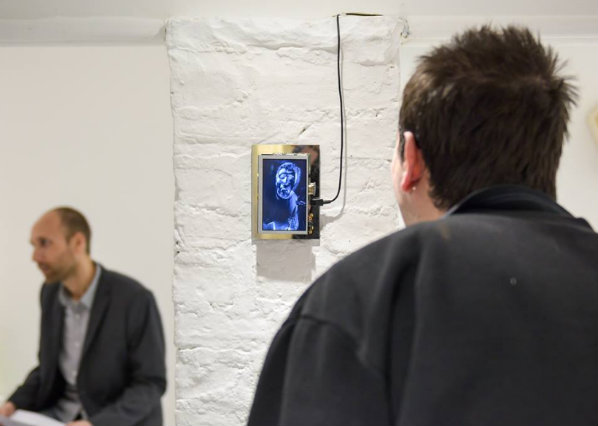
So far, Compiler has made a variety of spaces for conversation about digital culture through both its artworks and its organisation. Each artwork has a different ‘footprint’ of interactions, linking websites to rooms, success to failure, data privacy to financial transaction via consultation, and making interesting connections between CCTV and code, dance notation and HTML, activism and commerce.
An interesting way to read the Compiler platform is as a series of combinations of human-readable codes and machine-readable codes. The platform ‘compiles’ a different combination each time, and each time the output is different. Through this, the interaction of analogue and digital processes is demystified and muddled, in a distinct way. The platform is in its early days, but it seems likely that new connections and new grey areas will appear over the next few months, as Compiler has its second exhibition (again at OOTB) in May, takes part in the CCS conference at Goldsmiths in June and heads in other directions thereafter.
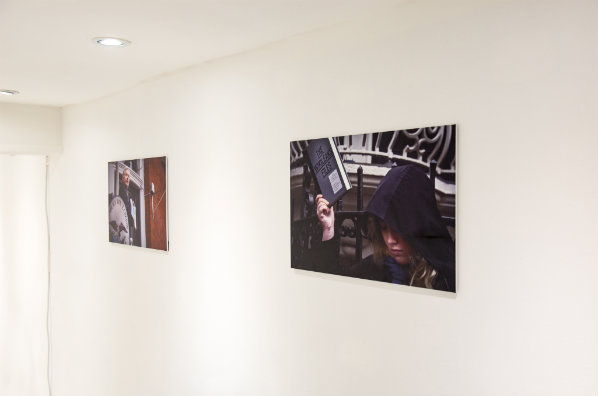
The exhibition offered plenty to play with, while posing complicated problems in relation to openness and experimentation. When I spoke to Eleanor, Tanya and Alisa about Compiler and its aim to engage local communities in networks of knowledge-exchange , we talked about how it’s an impossible and strange aspiration to have a ‘neutral’ venue. While a cocktail can be delicious and engaging, it’s also expensive. While a cafe is, arguably, a less exclusive space than a gallery, OOTB itself is a cafe which targets a specific audience. Drink prices, decor and a host of other factors mean OOTB, like all spaces, is politicised in a particular way. Their venue choices so far will influence, in subtle and overt ways, their future attempts to engage diverse local communities. The organisers of Compiler acknowledge this; their response is that rather than trying to make an artificial neutrality they are keen to move as the platform develops to new spaces and new and different contexts.
A change of context, message, communication style is not easy; nor does it fit with to an easily recognisable politics or aesthetics. Moving into and out of contexts is something to be done carefully and thoughtfully. It seems to me that the Compiler team will have their work cut out, but if they can direct that work in such a way that the platform is able to communicate in multiple ways at once, ‘networks of knowledge-exchange’ could develop between, and in response to, the markers set by the organisers. The question is, how will they develop?
DOWNLOAD PRESS RELEASE (.pdf)
For her exhibition at Furtherfield Gallery, Alison Ballard presents Offline Is The New Luxury a collection of works exploring our relationship with technology and the Internet. When daily encounters are increasingly mediated by online technology, how is this affecting our experience of live-ness, presence, and time?
With live streaming, instant replays and video chat technologies, concepts of time, space, and distance, are changing. We ‘hang out’ together online, we ‘live chat’ with computer algorithms, watch cat videos over and over again and share world political events as they happen, ‘in real time’. Contemporary Western culture has become now-centric. Social media offers more ways than ever to ‘go live’ meaning we no longer have to share our experiences with others in the past tense (a photograph we took on holiday or a video of the event we attended last week). Instead, we share our every moment instantaneously in a continuously unfolding now.
The Narrator Is Present is an audio work with narrative ambiguity and a sinister underbelly. How can we distinguish fictional narrative from truth among the multitude of disembodied voices on the Internet? Who is it that is speaking to us and what do they want? Existing simultaneously in Furtherfield Gallery and online, the work also explores the dualistic experiences of the virtual and the physical, and the ways in which these two spaces contribute to a single reality.
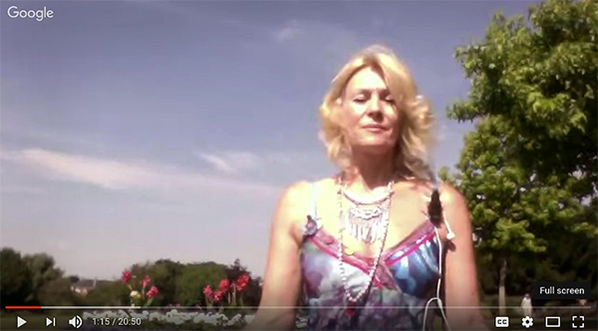
In Live Stream of Consciousness Ballard asks; can the Internet be good for our health? Spending time in parks can improve mental and physical wellbeing by relieving stress, reducing depression, improving memory and cognitive function, and boosting creativity. Can the same mental and physical health benefits of visiting a park be achieved via meditation, online? Ballard attempts to find out with this 20-minute seated meditation, originally broadcast as a live stream from Chalkwell Park, Southend-on-Sea, in 2016. By displaying this work inside Furtherfield Gallery, the artist invites us to reflect upon the physical and mental health benefits that Finsbury Park brings to our day-to-day lives.
Through these works and more, Ballard reflects upon the current state of hyper-reality; the context-collapse of the real and unreal, the distinction between what is simulated and what seems ‘real’, and invites us to reconsider our view of reality.
Online Live Stream of The Narrator Is Present
Available online during gallery opening times, from 6 April
http://bit.ly/2mExQ0v
The Narrator Is Present exists live; in the gallery, and online. Visit Furtherfield Gallery to be physically complicit in the work or watch online to be a distanced voyeur.
Online Exhibition Walkthrough with Ruth Catlow Co-Founder and Co-Director of Furtherfield
Available from 7 April 2017 on Alison Ballard’s YouTube Channel, in 2D video and Google Cardboard via the YouTube App.
http://bit.ly/2mExQ0v
Also available to view in the Gallery. Please ask a member of staff
Everyday Fiction / NetPark
Open Day 11:00 – 16:00, Saturday 15 April 2017
Metal, Chalkwell Hall, Chalkwell Park, Southend-on-Sea, Essex, SS0 8NB
A chance to experience Alison Ballard’s geo-locative audio work Everyday Fiction; a heart-breaking story of loss, grief, and mental illness that explores the ambiguity between reality and fiction that we encounter in everyday life. Site-Specific to Chalkwell Park, it forges a relationship between the audio, the location, and your presence within it. A moving experience with content that some listeners may find challenging.
Just one of the many app-based experiences on offer as part of NetPark; a collection of site-specific digital artworks commissioned by Metal. Find out more on the NetPark website: http://www.netpark.zone/artist-projects
If you have a smart phone, we recommend downloading the App before your visit and connecting to the free NetPark WiFi upon your arrival, to improve your GPS signal.
Download for Apple iOS: http://apple.co/2moPeWA
Download for Android: http://bit.ly/2mEFuI
Don’t have a smart phone? That’s OK, you can borrow an iPad from Metal on the day, free of charge.
Alison Ballard explores the ambiguity between fiction and reality, the real and unreal, and the known and the imagined, through temporal works of film, installation, audio, performance, and geo-locative technologies.
Derived from everyday experiences and observations, coupled with an interest in the dislocated relationship of image and sound, and phenomenology, she seeks to produce cross-disciplinary artworks that question our relationships with people, places, and objects, and the shifting meanings of time, presence, and liveness.
Alongside her practice, Alison is Associate Lecturer at Nottingham Trent University and a freelance producer in London and Nottingham. More information can be found on her website: http://alisonballard.com/
Furtherfield was founded in 1997 by artists Marc Garrett and Ruth Catlow. Since then Furtherfield has created online and physical spaces and places for people to come together to address critical questions of art and technology on their own terms.
Furtherfield Gallery
McKenzie Pavilion
Finsbury Park, London, N4 2NQ
Visiting Information
What is serendipity? Notoriously difficult to translate1, it is described as a trivial encounter, a pleasing coincidence, or a moment or encounter that was unplanned and occurred without intentionally looking for it. For Olma there appears to be much more at stake than a charming French accident. In the book ‘In Defence of Serendipity: For a Radical Politics of Innovation’ (2016), Olma gallops through the oppressive apparatus of the creative industries and the tireless illusion of innovation that captivates the hearts of young creatives and designers all over Europe, before finally resting on a call to arms for a radical politics of innovation that encompasses creativity, citizenship and social emancipation.
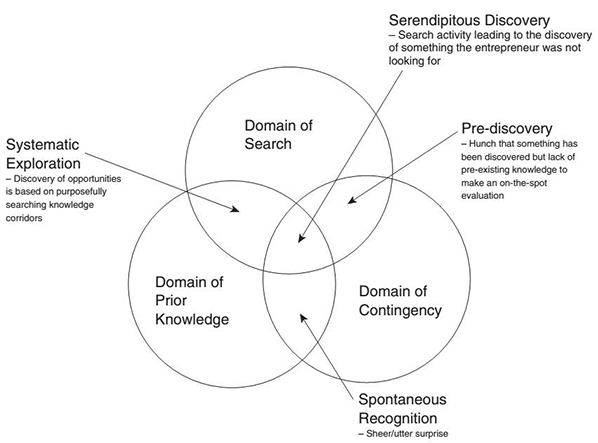
The notion of serendipity – with its playful innocent charm that promises the unexpected or unplanned potential from the incidental – represents much more than the romantic possibility of chance. As part of his research for the book Olma co-organised a conference on creativity with the Institute of Network Cultures in 20142, where social scientist Pek van Andel 3 provided an anecdotal sentence, which for Olma describes what is at stake in defending serendipity –
“The new and unknown cannot be extrapolated logically from the old and the known” (Andel, 2014).
There are many assumptions surrounding creativity and the production of knowledge, and this possibility to discover the new or the unknown with methods outside of the structures or logic enforced by institutional programs is quite a cunning place to situate a critique on cultural production. After all what is more valuable in contemporary culture than producing the new & the unknown?
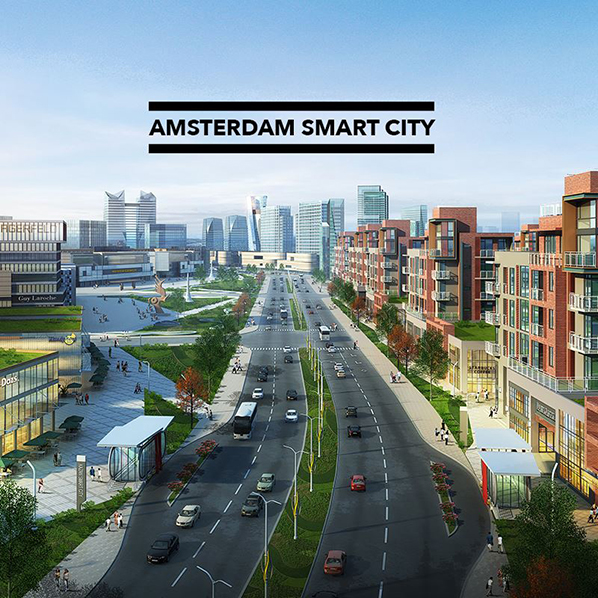
For Olma, the aims of culture programs for creatives and designers to create, build and imagine the ‘new’ are misguided, and form part of the many ‘false sleeves of innovation’ in which he seeks to re-instate a political vision for innovation. (Un)fortunately for Olma, he is sat right in the epicentre of this ‘slack innovation culture’, based in a small studio in East Amsterdam where the majority of the artist-run spaces have quickly become boutique hotels, co-work spaces and commercial creative labs. Amsterdam is perhaps only matched by Berlin in its ability to brand a certain lifestyle – a concoction of social innovation and tech entrepreneurism – connected through flexible work spaces, fab labs and start-up hubs that all contributed to the city becoming the official European city of Innovation in 20164.As an artist who moved to the Netherlands to participate in the wide variety of workshops, conferences and collaborative enterprises offered by the wide range of labs, media organisations and institutions in Amsterdam I found Olma’s critique on the lack of political agenda from Dutch cultural organisations thoroughly devastating. For Olma, much of this type of creative activism is an empty political gesture, a speculation and an ideological indulgence for a lost millennial generation attempting to engineer a game-changing prototype or white paper that could make the world a better place (if it ever became anything more than a 5 minute Prezi). To borrow the term coined by Evgeny Morozov, the creative sector has long been adapting the approach of ‘Technological Solutionism’ – programming or designing a technical solution to a social problem – and this is ultimately leading to what Olma describes as ‘Changeless change’. Olma sees this as a dominant, restrictive logic that has pervaded not just the creative economy but other sectors of education, healthcare and state services for years. He insists that defending the possibility of spontaneity, chance and coincidence in the face of regulated, market-driven creative programs is the way to make innovation innovative again.
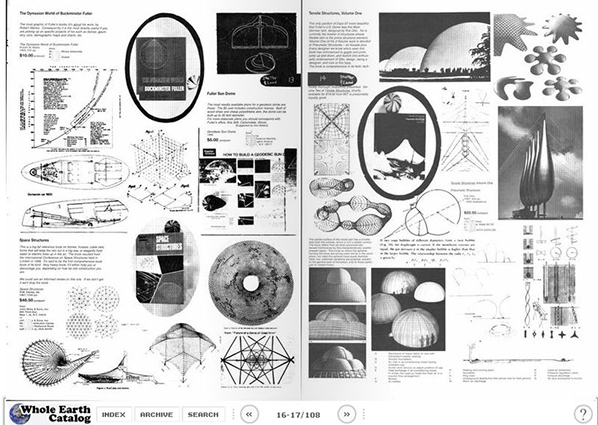
“The paradox is that while relying on informal and idiosyncratic forms of interpersonal exchange, cybernetics spawned a techno-social ontology, reducing human beings to increasingly calculable, controllable and predictable factors within systems” (pg 160, 2016)
Olma occasionally describes conditions in the past century where serendipity was openly facilitated and creative innovation demonstrated radical political values. Universities – such as the well cited Black Mountain college (whose students included John Cage & Buckminster Fuller) – and co-working spaces originally provided much potential for chance encounters at little or no cost, and even the invention of cybernetics involved a degree of spontaneity. The hippy counter-culture movement and the communalists of the late 1960s were making a radical attempt to form an alternative social transformation and organise flexible communes and temporary networks. If you go back to this starting point it is easier to grasp how the premise of Silicon Valley originated from a radical politics of innovation. Buckminster Fuller, Stuart Brand and even Steve Jobs were designing and building alternative visions of the world which are now perpetually carried in the pockets of over 160 million people. These were creatives, designers, hackers and hippies who built their own vision of reality and successfully sold it to the western world. It is little wonder then that even after half a century creatives still believe in the emancipatory potential for technological design to engineer large-scale social change. This attitude resides in young creatives like a hangover, with many believing the most important part of any project is the ability to harness the power of the network and ‘scale up’ or utilize the latest technologies (e.g. IoT blockchain, A.I) in order to ‘build a better world’.
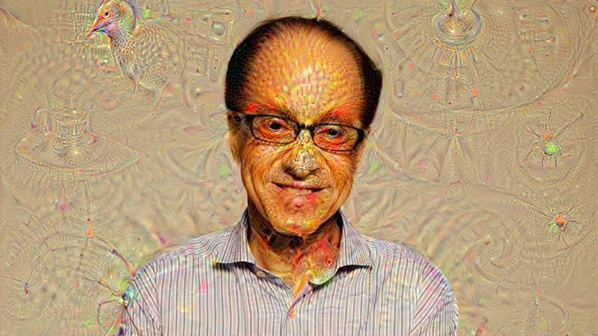
The global dominance that Silicon Valley has managed to groom over the creative economy has left very little room for creatives, designers and technologists to imagine future(s) other than the ones packaged and sold by the CEOs of the four major tech companies (GAFA5). Olma dives into the disillusion perpetuated by figures like Ray Kurzweil and Elon Musk and offers some insight into how the idea of the singularity is proliferated as an artificial salvation from a crisis that – arguably – they are responsible for. What is so powerful about these myths is the way they are presented as an inevitability, a natural outcome of what is known as ‘Moore’s law’ (the theory that computing power grows exponentially). Aside from the fact that, as Olma highlights, this theory (it’s not a law) is beginning to look more and more unlikely due to increasing demand and finite resources, 6 the mythical fantasy is also a fantastic narrative that – regardless of plausibility – enchants the masses, enticing them towards the promise of a techno-spiritual enlightenment. The singularity, similar to The Enlightenment, is an alternative way to defy the gods and transcend both space and time (whether that is flying to Mars with Elon Musk or staying alive forever by eating nothing but berries with Ray Kurzweil 7). It also reintroduces the notion of a collective consciousness and mobilises the technologists, hackers and creative programmers towards a transcendent , spiritual (post-human) awakening. What distresses me is how often artists and designers (including myself!) are encouraged either through directed funding programs or just through their own curiosity to unwittingly contribute free or intellectual labour to improve, train and develop the latest technology. This is very familiar in the development and production of Artificial intelligence. When Google releases the source code for A.I products such as DeepMind’s neural network 8, they are doing so predominantly to crowd-source the development of the software and improve the ‘machine learning’ process of the application. This way, the countless enthusiasts creating their own ‘neural nets’ or simply sharing more ‘slug dog puppies’ 9 incidentally form an army of free researchers, crowd-sourcing the big data and enabling companies to train and deploy more powerful machine learning systems. The sweeping tide towards Artificial Intelligence and eventual leap towards the singularity – whilst being very good for sensationalising and selling further tech products – lures over the collective creative imagination of many artists and creative technologists and consequently makes it increasingly challenging to design an mobilise an alternative vision that does not just further the one sided Singularity story. In the final chapters of the book, Olma quotes Julian Assange who famously said “there are only two types of belief systems that are capable of transforming change on a global scale, that of silicon valley libertarianism and that of radical Islam”(pg 211, 2016). The way in which Olma maps out how Californian hippy counter-culture advanced into techno-libertarianism to the prospect of a technological enlightenment, highlights how ‘a belief system [can] turn populations into docile followers of the dominant logic of power’ (pg 119, 2016) The conclusive effect of Olma’s analysis is that there is a generation of young people who assume that transformative social change can be engineered through programming, code and technical design, and not through politics. Furthermore, the promise of a collective consciousness in the form of the singularity propagates the belief that this particular strain of Randian individualism will eventually give way to something egalitarian, collective and enlightening.
“Today, a radical politics of innovation must be directed toward the recapture of the state by an ideology that is a polemic for the reinvention of a public sphere whose accidental sagacity will generate potential futures we don’t even dare dream about” (pg 217, 2016)
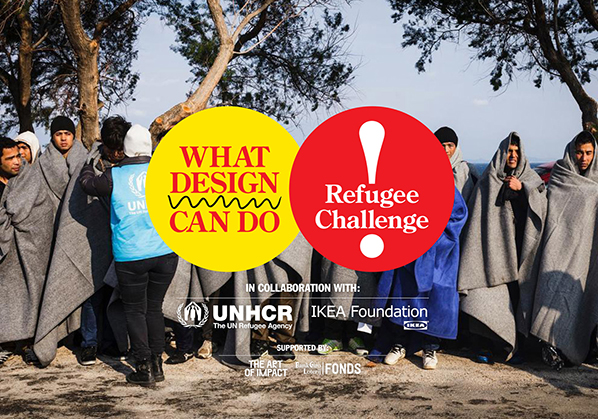
While admitting that the odds of reclaiming a practice of innovation that is genuinely alternative, transformative and political are slim, Olma offers us some potential new directions to consider. After relentlessly exposing the libertarian attitude that has permeated through technological innovation into creative culture, Olma considers how to collectively care for the imaginary ‘we’. Rather than champion a Luddite perspective in relation to digital technology, Olma asks us to re-consider the effect tech culture has had on creative practices up to this point. He asks us to distance ourselves from creative programs that provide ‘simulations of serendipity’, which are in-fact co-ordinated idealogical parameters that only produce vague, washy attempts to ‘make the world a better place’. Olma asks us to call their bluff and put an end to intellectual entrepreneurialism and champion creative engagements that are political to their core. No more tinkering prototypes or speculative designs that show no political agenda than simply ‘making the world a better place’– a reactionary counter culture is needed. Fixing this creative depression is key to articulating and mobilising a collective response to neo-liberal politics and free market economics. Olma goes on to state that “Creativity and citizenship should be two sides of the same coin”. If artists and designers are able to direct their own autonomous practices that are not based on imitating the same technological solution-ism we have been subject to till now, then a vehicle for alternative political programs through creative expression is possible. However, my concern is that the current creative and start-up infested world might be so deeply ingrained that it becomes difficult, if not impossible, to try and distinguish between what Olma describes as ‘false innovation’ and identify what qualifies as ‘good innovation’. Making such a distinction is based on political subjectivity, which will always fall short on a old framework of left and right ideological values. Take for example a typical Dutch design competition called What Design Can Do, which last year asked designers to respond to what they call the ‘refugee challenge’ 10. 3D printed modular homes, food trucks, democratic voting apps and interactive maps provided business, charities and NGOs with a huge selection of ideas and concepts to help contribute towards improving the humanitarian crisis. Now, even without fully evaluating the impact of each project I would still find it difficult to dismiss all the endeavours as nothing more than what Olma describes as ‘change-gymnastics’ (pg77,2016). I think what Olma is requesting in his writing is for a more audible and self-reflective practice of innovation so that “the social contexts of the technologies used [are] part and parcel of its practice” (pg 68, 2016). In this sense, perhaps a greater critical evaluation is required when determining the value of social innovation. When considering Olma’s analysis in the context of 2017, forming a radical politics in the face of neo-liberal or neo-fascist regimes should hopefully galvanize and mobilise a unified resistance, however one has to be aware of the fused social corporate structure in which these common forms of resistance will eventually manifest. Brands are quickly tapping into and attempting to integrate alongside social activism 11 and an agency I was recently introduced to titled Doyougetme.world? specialises in connecting brands with ‘radical’ activism12. Although these initiatives may appear to be the latest attempts from corporations to engage with young consumers I believe they highlight the hybrid culture in which this radical politics of innovation will need to emerge. What if a mass mobilisation was initiated or deployed by a brand or corporation, as imagined in this uncanny piece of short fiction that was published this month by Andrea Phillips entitled ‘The Revolution, as bought to you by Nike’ 13. In this story, Nike launch a pitch perfect campaign in order to start a social revolution and the strategies of brand engagement become the tools with which to manifest large scale disruption to globalized power and corruption. The plausibility of such an attempt is very credible at a time when both citizens and companies are converging to protest against president Donald Trump and his decisive actions seem to divide citizens and open up new markets of political consumers. Considering these manoeuvres, one should be prepared for a radical politics of innovation to be a multifaceted, multi-political project, and not rely on a traditional political framework to evaluate creativity, innovation and citizenship. It is an important time to ask how creativity, social innovation and tech culture can support social mobility and radical politics, when what feels like an uncontrollable rise of neo-fascism, rather than dismiss existing creative practises of innovation it is an opportunity to consider how creativity can once again become the vehicle to take us out of ‘changeless change’ and into a radical politics of innovation.
Max Dovey
‘In Defence of Serendipity : For a Radical Politics of Innovation’ by Sebastian Olma is out now from Repeater Books http://repeaterbooks.com/books/in-defence-of-serendipity-sebastian-olma/
Max Dovey is a researcher, artist and critic based in Netherlands.
Www.maxdovey.com
In the introduction of Civic Radar, editor Peter Weibel sets out the motivation, layout and journey of the book. This first comprehensive monograph of Lynn Hershman Leeson’s artistic career, spanning across five decades. It must have been a dizzying publication to work on, when compiling her pioneering work in the fields of photography, video, film, performance, installation, and interactive and net-based media art. It is noteworthy that Hershman Leeson collaborated in its production. One feels her personal involvement in the book – its richness, care and detail, shows in its nearly 400 pages, and approximately 500 illustrations. It also features supporting texts by other writers, curators, theorists, and artists, such as: Andreas Beitin, Pamela Lee, Peggy Phelan, Ruby Rich, Jeffrey Schnapp, Kyle Stephan, Kristine Stiles, Tilda Swinton, Peter Weibel and interview by Hou Hanru and Laura Poitras with the artist.
“I try to live in the present, because most people live in the past. If you live in the present, most people think you live in the future, because they don’t know what happens in their own time.” Lynn Hershman Leeson.
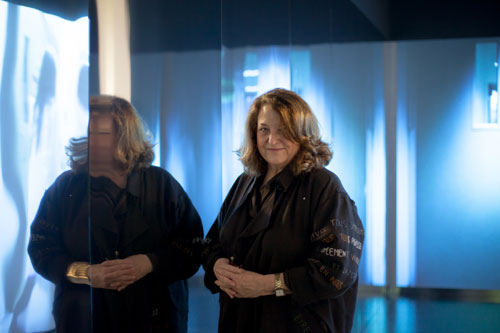
Lynn Hershman Leeson has pioneered uses of new technologies, recognized as key to the workings of our society today. She tackles the big questions surrounding: identity in a time of mass, overpowering consumerism; privacy in an era of surveillance; the interfacing of humans and machines; the relationship between real and virtual worlds; and new bio-ethics surrounding practices such as growing parts of the human body from DNA samples. We can think of Hershman Leeson as a direct artistic descendant of Mary Shelley. Consider Shelley’s celebrated publication, Frankenstein: Prometheus Unbound, published in 1818, and its challenges towards macho revolutionaries of ‘reason’, and her critique of the misuses of science and technology by the patriarch. We can see strong parallels between both women. They are feminists, who have managed to find ways around (and to work with) traditional forms of dominant, patriarchal frameworks, so to express personal, creative and cultural identities, on their own terms.
“Lynn Hershman Leeson’s mission statement seems to be that the body is a programmable software embedded in a changeable hardware. Therefore, she shows us so many hybrids and mutants, aliens and agents, actors and avatars, in real life and second life. From Dolls to clones, she demonstrates the paradox plurality of identities especially in the age of total observation.” [1] (Weibel 2016)
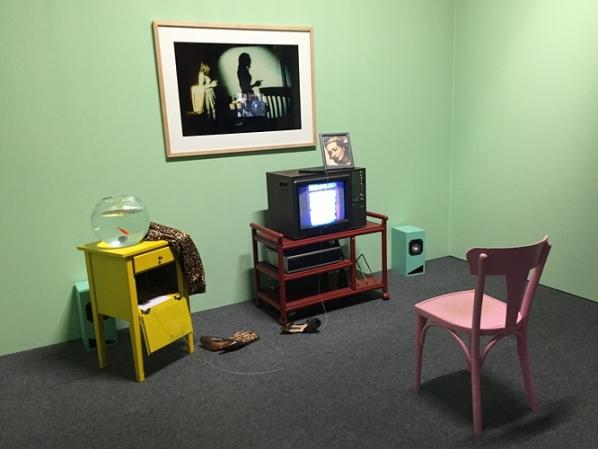
Hershman Leeson’s artistic process however does not keep its distance from the processes of science and technology. She leaps into the depths of our fears and unreservedly engulfs herself, and her imagination in their material influences and modifications. Like Donna Haraway, Hershman Leeson takes cyborgs, misfits, biology, mutation and transformation as her inspiration, contexts and materials. And also like Haraway, she playfully and critically owns concerns around science and technology, along with the ethical issues that may arise out of their continuously shifting, influences on society; and, thus not owned by or weighed down by them. Every work put forward by Hershman Leeson, is an experiment. Her interests and knowledge inspired by science and technology reflects her constant state of contemporariness. Her work directly correlates to breaking down systems of perceived values.
“Hershman Leeson confronted conventional gender roles and exposed the normative construction of gender identity. Some of her videos have included cross-dressers and transgender men and women, as in Double Cross Click Click (1995), and her assumed male pseudonyms at a time when the art world was dominated by men who mostly ignored women.” [2] (Beitin 2016)
Hershman Leeson’s art moves fluidly between different formats, contexts and disciplines. This of course is not easy to brand. The art market survives by promoting art that fits into particular roles and products that are easy to promote, predict and consume. The irony here is that the art world promotes the idea of itself as a site of novelty and insights, but in reality represents a deeply conservative culture. Some artists, Hershman Leeson is one of them, transcend the contemporary artworld norm and build alternative universes, contexts and identities, where the art is so investigatory and esoteric, traditional conventions are challenged.
When I interviewed Hershman Leeson last year for Furtherfield she talked about how she’d like to “eradicate censorship, and make more transparent the capitalistic underpinnings that are polluting access, value and visibility”. In the 70’s, she was the first artist working on a prison art project in San Quentin, and many of her early public art works “geared toward social change.” [3]
Civic Radar shows us that her work is not reduced to a singular, reflection of her own creative self. There is a wider story and it includes the voices of many others as part of the narrative of her life and her work, as well as reclaiming a history in a male dominated society.
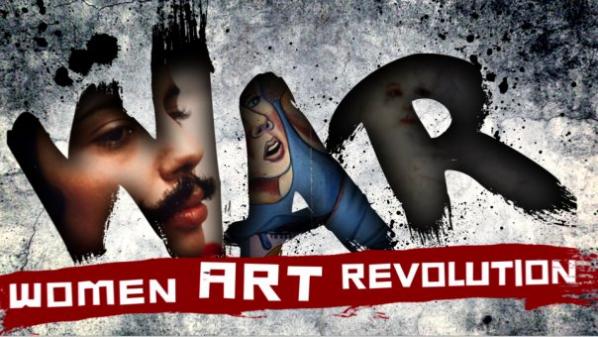
We see reaffirmed a varied and dynamic history where she has been involved in strengthening the role of women in society, as part of an extension of her art process. One excellent example of this rich history is that over a period of 40 years she interviewed an extensive array of women artists, historians, activists, and critics who integrated personal and political content into their work. Then, some of that gathered material was made into a film project !Women Art Revolution, in 2010.
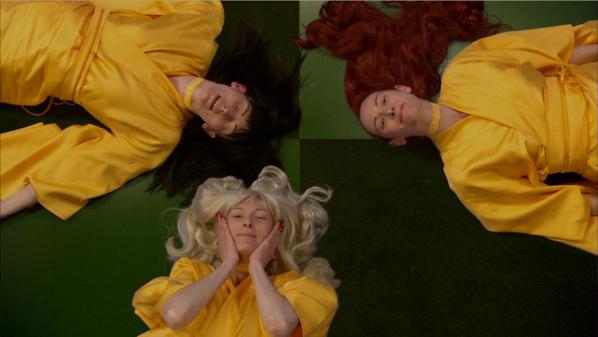
Lynn Hershman Leeson has not only achieved pioneering work as an artist, but also as filmmaker. She has collaborated with actor and Oscar winner Tilda Swinton in several feature films that have gone on to receive numerous awards at international film festivals on account of their outstanding quality and innovative themes. »Teknolust« is an absurd, amusing and scientifically highly topical science-fiction drama on the subjects of cyber-identities, biogenetics, gender constructions and sexual self-determination in the age of the Internet. The plot turns on the scientist Rosetta Stone (Tilda Swinton), who illegally produces three clones of herself. The artificial entities can only be distinguished by the color of their clothing and live in an enclosed cyberspace. Because they are dependent for survival on the male Y chromosome, Ruby, the femme fatale among the clones, goes in regular pursuit of men. Sexual contact with Ruby leads to impotence in her lovers as well as to an allergic reaction triggered by a computer virus which is transferable to human beings. The FBI becomes aware of the clone family’s machinations following the increased incidents of infection among men, and begins to investigate. Note*
Her work has crossed into many different fields and formats. Which includes: installations, videos, films, sculptures, robots, avatars, contracts, computer programs, photography, paintings, drawings, collages, browser based art, artificial intelligence, bio-matter, network communication systems and devices. Synthia Stock Ticker and Dollie Clones are just two examples that demonstrate how ahead she has been with her ideas and her integration of digital technologies into art. Synthia Stock Ticker, is a networked-based media artwork made in 2000. It refers to the stock ticker invented by Thomas Edison and is unusually prescient in its portrayal of the emotional life of global markets. Inside a glass casing sits a small monitor screen, showing a video of a woman character named Synthia. “When the market is up, the character dances and shops at Christian Dior: when the market is down, she chain smokes, has nightmares, and shops at Goodwill.” [4]

Again The Dollie Clones 1995-96 predate a contemporary artistic obsession with creeping surveillance. Two telerobotic dolls, Tillie the Telerobotic Doll and CyberRoberta, whose eyes have been replaced with cameras. Each doll has a website that allows users to view the images taken by the webcams and click on an “eyecon” to telerobotically turn the doll’s head 180 degrees to survey the gallery.
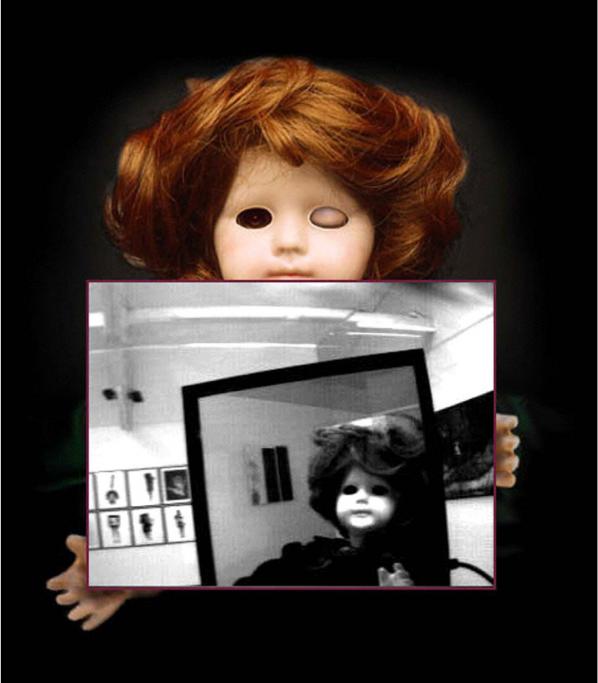
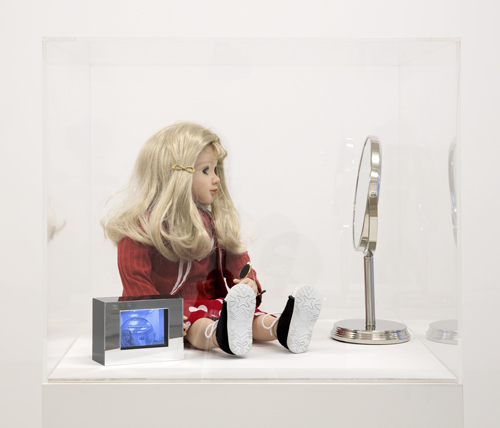
Hershman Leeson’s most prominent performance work was as another woman, Roberta Breitmore. This elaborate alter ego existed between 1973 and 1978. The Breitmore character was well developed, possessing different behaviors and attitudes to Hershman Leeson’s own personal identity. Roberta Breitmore had her own handwriting, clothing, wig, makeup, driver’s license, apartment, psychologist, bank account, credit cards, acquaintances, life story, and adventures. Hershman Leeson took the audacious leap and sporadically became Roberta Breitmore for 5 years. Other women also lived as Roberta Breitmore and sometimes simultaneously. [5]
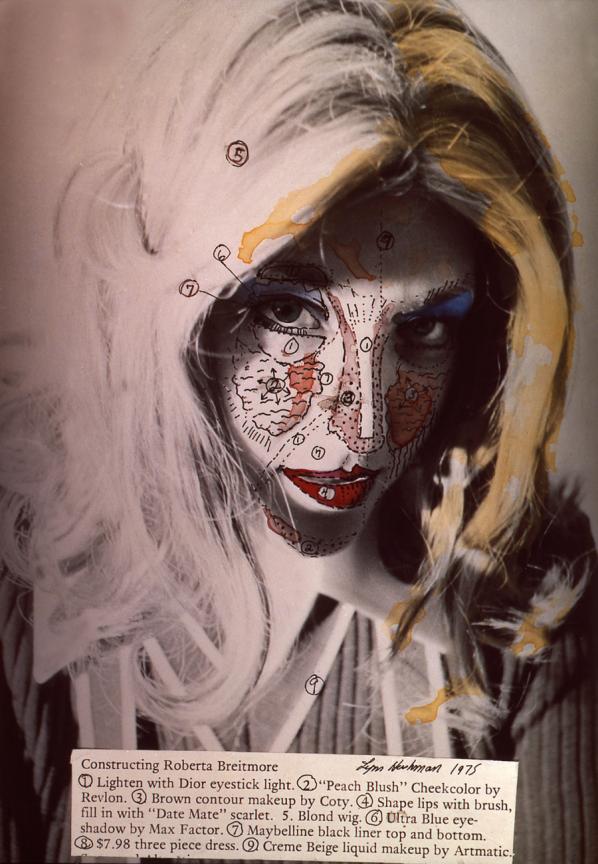
“Hershman Leeson hired three additional performers, all women, to play Roberta. They wore costumes identical to the ones Hershman Leeson herself wore, and they treated Roberta essentially as a professional (albeit part-time) gig. They undertook some of Roberta Breitmore’s correspondence and went on some of her dates (which were documented in photos and audio recordings). Eventually, Hershman Leeson stopped enacting Breitmore, reducing the instantiations of Roberta Breitmore from 4 to 3.” [6] (LaFarge 2007)
The spirit of Hershman Leeson’s radical art persona can be seen in younger, contemporary artists today. For instance, Heath Bunting’s Identity Kits, part of his larger The Status Project consist of various items, personal business cards, library cards, a national railcard, T-Mobile top-up card, national lottery card and much more. “They take a few months to compile each of them because they are actual items that everybody uses in their everyday lives, involving evidence of identity. There is also a charge for the package of 500.00 GBP, which is cheap for a new identity.” [7] (Garrett 2014) Then we have Karen Blissett, an Internet artist who suddenly decided to go multiple by opening up all of her email, Twitter, Facebook and Google accounts to many different women around the world. “A torrent of provocative, poetic, and often contradictory voices issued proclamations, made auto portraits, and shared psalm-like meditations on her existential transformation; distributed across online platforms and social spaces, in text, image and video.” [8] (Catlow 2014)
Towards the end of Civic Radar a collection of pages show us various images of the exhibition by the same name at the ZKM Museum of Contemporary Art, in Germany 2014. When viewing the images of her work in the large gallery spaces you realize the scale of it all, and how substantial her work is.
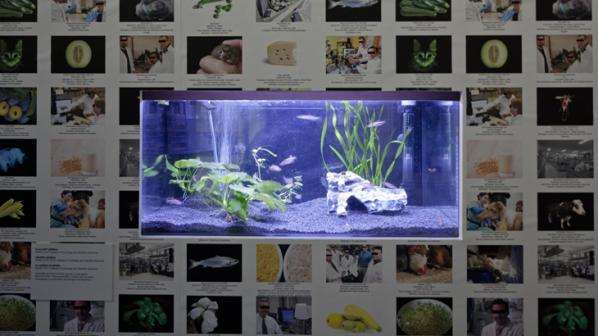
Moving on after the images of the works in ZKM, there is a selection of Hershman Leeson’s texts written, from 1984 and 2014. These writings, take us through different stages of her career, revealing ideas and intentions behind much of her work and also some of the work included in the publication. In the last paragraph of the last text in a short essay, titled The Terror of Immortality she writes about the contexts that have given rise to her most recent work. “As organic printing and DNA manipulation reshapes the identities of newly manipulated organisms, so too the culture of absorbed surveillance has dynamically shifted. In the next 100 years, the materials used to create DNA will become increasingly distributed and hybridized. The implications of this research include not only the creation of a sustainable planet of hybrid life forms that can survive a sixth extinction and incorporate into to its existence a morally responsible future.” (Leeson 2016)
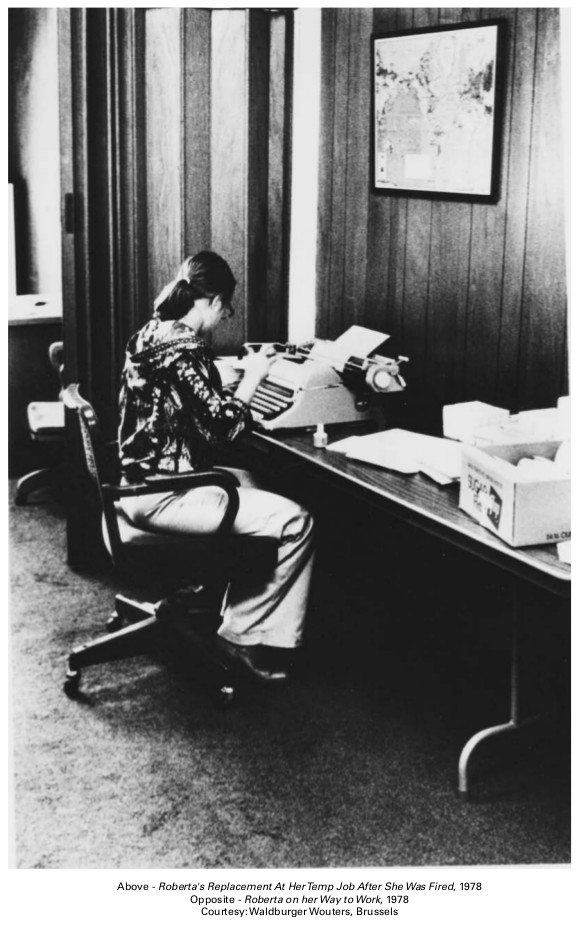
This book is a profound read, offering an insight to this generous and profound artists’ fantastical journey in an era marked by accelerating change. And what’s so amazing is that the content, the narratives, and the histories, are real. It is an Aladdin’s Cave of rich, exceptional artworks, flowing with brilliant ideas. Hershman Leeson has had her finger right on the pulse of what’s relevant in the world for a long time, and transmuted the knowledge she unearths in her examination of identity, feminism, science, technology and more into her own artistic language.
Her work is way ahead of most contemporary artists showing now. This book should be read everywhere. Not just because it features great art, but also because features a woman with a great mind. I am not a fan of the words genius or masterpiece; I find them tiresome terms reflecting a form of male domination over women and the non-privileged classes. Yet, after spending time with Civic Radar, I cannot help myself thinking that I have just witnessed something equivalent without the negative baggage attached.
*Text from ZKM – Teknolust. With Lynn Hershman Leeson at the cinema.
http://zkm.de/en/event/2015/03/teknolust-with-lynn-hershman-leeson-at-the-cinema
In 2015, ZKM in cooperation with the Deichtorhallen Hamburg / Sammlung Falckenberg exhibited the first comprehensive retrospective of Leeson’s work, including her most recent productions of art. Last year Modern Art Oxford hosted a major solo exhibition of her work Origins of a Species, Part 2 and she also has work in The Electronic Superhighway, at Whitechapel Gallery, in London.
As part of transmediale’s opening night in Berlin, audiences were sat in front of three large screens and taken on a journey through the abstract infrastructures of the imminent ‘smart city’. Liam Young, a self-proclaimed speculative architect, narrated the voyage whilst beside him, Aneek Thapar designed live sonic soundscapes complementing the performance. For Young, the smart city is a space where contemporary anxieties are not only unearthed but increasingly multiplied. The smart city manufactures users out of citizens, crafting an expanse whereby the hegemonic grip of super-production evolves into a threateningly subversive entity. According to Young, speculative architecture is one of the methods of combating the city’s supremacy – moulding the networks within a smart city to facilitate our human needs within a physical realm. It is a means of becoming active agents in amending the future.

Speculative architecture as a term is relatively new, however the concept’s origins date back to the 1970s Italian leftist avant-garde. Back then it was called ‘Radical Architecture’, a term initiated by SUPERSTUDIO’s conceptual speculation regarding the structures of architecture. SUPERSTUDIO’s methods were transcendental as they favoured the superiority of mental construction over the estranged act of building. The founders of the group, Adolfo Natalini and Cristiano Toraldo di Francia, acknowledged modernist architecture as reductive to man’s ability of living a free life since its core foundations were built on putative methods of indoctrinating society into a pointless culture of consumption. The development of The Continuous Monument was a declaration to end all monuments since the structure itself was designed to cover the expanse of the world. Its function was to form ‘a single continuous environment of the world that would remain unchanged by technology, culture and other forms of imperialism’ as stated by SUPERSTUDIO itself. A function sufficiently egalitarian, and in some respects utopic, The Continuous Monument, much like Tatlin’s Third International in the 1920s, was never intended to be built, but instead to uncover the notion of total possibility and arbitrariness. Likewise, Young’s performative smart city does not purpose itself around applicable techniques of construction – it creates scenarios of possibility exploring the autonomous infrastructures that lie between the premeditated present and the predicted future. Hello City! intends to transpire the idea that computation, networks and the anomalies that surround them are no longer a finite set of instructions, but instead constitute an original approach to exploring and facilitating speculative thought through imagined urban fictions.

Liam Young’s real-time cinematic narration cruises us like a ‘driverless vessel’ through the smart city beyond the physical spectrum. The smart city becomes an omnipresent regulator of our existence, as it feeds on the data we wilfully relinquish. Our digital footprint re-routes the city, traversing us into what Young calls ‘human machines of the algorithm’. His narrative positions human beings as ‘machines of post-human production’ within what he names a ‘DELTA City’. As an envisioned dystopia which creates perversions between the past, present and future, Hello City! is reminiscent of Kurt Vonnegut’s post-modern narrative in Cat’s Cradle. San Lorenzo, the setting for Vonnegut’s book, is on the brink of an apocalypse – the people’s only conjectural saviour would be their deluded but devoted faith to ‘Bokononism’, a superficial religion created to make life bearable for the island’s ill-fated inhabitants. Moreover, the substance ‘Ice-9’, a technological advancement, is exploited far from its original purpose of military use, leading to looming disaster. Both Bokononism and the existence of Ice-9 resonate Young’s narrative as they explore the submissive loss of free will and the consequences of allowing the future to be dictated by uncontainable entities. In Hello City! the metropolis becomes despotic and even more complex as it is designed by algorithms feeding on information instead of the endurances and sensitivities of the human body.
Like software constructed by networks, the future landscape will be a convoluted labyrinth for physical beings. Motion within the city will be ordained by a form of digital dérive structured by self-regulated and sovereign systems. Young’s video navigates us through blueprint structures simulating the connections within networks thus proclaiming the voyage as unbridled by our own corporal bodies. The body is no longer dominant. He introduces us to Lena, the world’s first facial recognition image, originally a cover from a 1972 Playboy magazine. Furthermore, he makes references to Internet sensation Hatsune Miku as a ‘digital ghost in the smart city’ whilst the three screens project and repeat the phrase ‘to keep everybody smiling’ ten times. We may speculate that for Young, the smart city has the potential to function like Alpha 60, a sentient computer system in Godard’s film Alphaville, controlling emotions, desires and actions of the inhabitants in the ‘Outlands’. As Young dictates ‘the City, looks down on the Earth’ – it becomes a geological tool and engages the speculative architect to remain relevant within the ever-changing landscape of that space.
In a preceding interview, Young refers to the speculative architect as a ‘curator’, ‘editor’ and ‘urban strategist’ attempting to decentralise power structures from conventional and conformist architectural thought. In 2014, Young’s think tank ‘Tomorrow’s Thoughts Today’ envisaged and undertook a project titled New City. New City is a series of photorealistic animated shorts featuring the cities of tomorrow; one is The City in the Sea, another is Keeping Up Appearances and the last is Edgelands. Too often, these works are projected and interpreted with the foreseeable frowning of rising consumerism concurrent with the dissolute development of technological super structures. Without a doubt, the supposition that technology is alienating us from our identities as citizens of a city is undeniable and exhaustively linked to the creation of super consumers and social media. Nonetheless, New Cities is more than just about that – comparable to the architectural intrusions of SUPERSTUDIO, the narrative of Cat’s Cradle and Alphaville,New City underlines the impending subsequent loss of human liberty with the advent emergence of the smart city whilst Hello City! injects the audience in within it.
Young’s notion of the smart city is consolidated within a Post-Anthropocene existence. Without any dispute, our world will inevitably divulge a post-anthropocene reality, but until that critical moment arrives, acts of speculation, such as speculative architecture, only exist within the hypothesis of potentiality. In fact, throughout Hello City! speculation cannot be positioned as either a positive or negative entity – it appears to lie within a neutral area of hybridity and experimentation. The narrative of Hello City! is purely speculative and thus exceedingly experimental. Like much of SUPERSTUDIO’s existence, antithetical notions of egalitarianism and cynicism run throughout Hello City! triggering perpetual seclusion of the audience’s contemplations. Conflicting positions reveal an ambivalence resulting to escalated concerns towards the act of execution. Speculative architecture itself is a purely narrative process designed on a fictitious future that is not formulated and so the eternal battle between theory and practice will always occur. Uncertainties raise an issue of pragmatism and whether speculation, evidently in architecture, is commendable. Seeing as speculation for the future is, in its most basic form, an act of research, it is regarded as the most pragmatic practise when taking into consideration any future endeavours. As the performance draws to an end, Young declares that ‘In the future everything will be smart, connected and made all better’ and then indicates towards the contradicting existence of Detroit subcultures that the future map will be unable to locate. A message loaded with properties that are paradoxical and thus ambiguous in their intent, Hello City! occupies itself with inner contradictions that only create the possibility for plural futures, a functional commons for the infrastructure of tomorrow.
In 2016 Ruth Catlow and Ben Vickers led the symposium, Blockchain’s Potential in the Arts, hosted by the Austrian Cultural Forum. This symposium sought to bring together individuals from across the arts nationally to highlight and discuss the potential future impact of blockchain and encourage early engagement.
The award-winning DAOWO series was subsequently devised by Catlow and Vickers in collaboration with the Goethe-Institut London, and the State Machines programme. It is intended as a form of active engagement in these rapidly unfolding technical and socio-economic developments. Its title is inspired by a paper written by artist, hacker and writer Rhea Myers called DAOWO – Decentralised Autonomous Organisation With Others.
What does blockchain mean for the arts?
‘What seems to emerge is a potential for blockchain to devolve mechanisms and processes for funding artists, as well as allowing various players in the arts ecosystem – artists, collectors, viewers, curators, and others – to define how they want to interact, with the possibility that sharing and artwork almost merge, or at least become as two sides of the same coin.”
U. Kanad Chakrabarti
Focused on establishing greater cooperation between the arts and blockchain industry, leading researchers and key artworld actors discuss the current state of play. DAOWO Discussions focus on potential cultural and social impacts, technical affordances and opportunities for developing new blockchain technologies for fairer, more dynamic and connected cultural ecologies and economies.
This series brings together artists, musicians, technologists, engineers, and theorists to join forces in the interrogation and production of new blockchain technologies. Our focus will be to understand how blockchains might be used to enable a critical, sustainable and empowered culture, that transcends the emerging hazards and limitations of pure market speculation of cryptoeconomics.
As the DAOWO series unfolds each lab works across a spectrum of themes and domains of expertise, breaking down silos and assumptions about what these technologies might mean.
The aim is to birth a new set of experimental initiatives which can reinvent the future of the arts as we know it.
1-6pm Thur 28 Feb – Inspace, Edinburgh, in partnership with Department of Design Informatics at the University of Edinburgh, New Media Scotland.
Edinburgh Programme Summary
For more DAOWO activities see our Events page.
Featured image: mi.mu/Adrian Lausch – mimugloves
A new series of quarterly events facilitating better communication and collaboration between creative technologists and arts/media professionals*
Artful Spark is not a sales pitch or a soapbox, but a way for people who might not know about projection mapping or haptic controllers to see technologies demo’d and discuss their potential for new ways of telling stories and making experiences.
Our speakers will demonstrate technologies- from how to turn them on to talking about their capabilities for creative content. They’ll also talk about their own projects and be frank about the hurdles they’ve encountered along the way.
For our inaugural event we’re focusing on Wearable Tech
Rachel Freire is a clothing designer and leather specialist working across multiple disciplines of fashion, film and stage. She is textile developer for the Mi Mu Gloves: http://mimugloves.com/
Zoe Philpott, Creator of Ada.Ada.Ada, a new show about Ada Lovelace which combines interactive theatre, science lecture, and wearable technology: http://adatheshow.com/
Tine Bech, professional artist and researcher (PhD), uses technology to create large scale public artworks, interactive spaces, and participatory games that engage people into play and participation: http://www.tinebech.com/
Tincuta Heinzel is an artist, designer and curator interested in the relationship between arts and technosciences. Currently she is a research fellow at Nottingham Trent University in the frame of “An Internet of Soft Things” project. http://aninternetofsoftthings.com/
Email sam@stellarnetwork.com if you’d like to be put on our mailing list.
* Including those working in theatre, film, publishing, museums, galleries and games.
Featured image: External Transformations: Roberta’s Construction Chart, No. 1,from the series Roberta Breitmore, 1974–78
Choose Your Muse is a new series of interviews where Marc Garrett asks emerging and established artists, curators, techies, hacktivists, activists and theorists; practising across the fields of art, technology and social change, how and what has inspired them, personally, artistically and culturally.
Lynn Hershman Leeson artist and filmmaker, who over the last three decades, has been internationally acclaimed for her pioneering use of new technologies and her investigations of issues that are now recognized as key to the working of our society: identity in a time of consumerism, privacy in a era of surveillance, interfacing of humans and machines, and the relationship between real and virtual worlds. Her work was featured in “A Bigger Splash: Painting After Performance” at the Tate Modern London in 2012 and a retrospective and catalogue are being planned for 2015 at the Zentrum fur Kunst Und Medientechnologie, Germany. Modern Art Oxford is hosting a major solo exhibition of her work Origins of a Species, Part 2, and it’s open until 9 August 2015.
Lynn Hershman Leeson released the ground-breaking documentary !Women Art Revolution in 2011. It has been screened at major museums internationally and named by the Museum of Modern Art as one of the three best documentaries of the year.
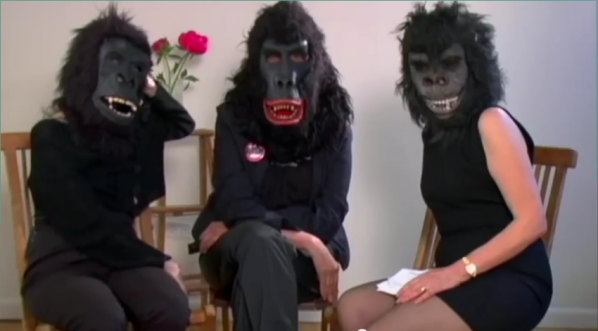
The image above is from !Women Art Revolution, which introduces the Guerilla Girls who draw attention to injustice and under-representation across artistic platforms and institutions. Several members discuss their origin story and modus operandi, including “the penis countdown. !Women Art Revolution won the first prize in 2012 at the festival in Montreal on Films on Art.
She also wrote, directed, produced and edited the feature films Strange Culture, Conceiving Ada, and Teknolust. All featured Tilda Swinton and were showcased at the Sundance Film Festival, Toronto International Film Festival and Berlin International Film Festival before being distributed internationally. After her retrospective, at CIVIC RADAR in December 2014, a bumper catalogue consiosting of 450 pages will be published in Oct 2015. Featuring writing by Peter Weibel, Laura Poitras, Tilda Swinton, Kristine Stiles, B Ruby Rich, Hou Hanru, Andreas Beitin, Peggy Phelan, Pamela Lee, Jeffrey Schnapp, kyle Stephan and Ingeborg Reichle. Civic Radar is now at Diechterhallen Falkenberg till November 19, 2015.
Marc Garrett: Could you tell us who has inspired you the most in your work and why?
Lynn Hershman Leeson: What has inspired me are people who work with courage to do original work that has a political and authentic ethic. These include, to name a few only, it seems a bit strange because naming them isolates these artists from the context of their contributions. But I have been inspired by Lee Miller, Mayakovsky, Tinguely, early Automata and so many more like Thomas Edison, Jules Etienne Marrey, even Cezanne. Early on I educated myself by copying works to get a sense of how particular artists formulated their language – the way Rembrandt used light, Leonardo’s draftsmanship and parallels he found between technology and science, Gauguin’s color reversals, Brecht, Breton and Duchamp’s ironic and iconic archetypal identities, Tadeauz Kantor, and Grotowsky’s extension of the frame.
Also younger artists (nearly everyone is) like Rafael Lezano Hemmer, particularly the work he is doing now in using facial recognition to locate kidnapped victims, Amy Siegal’s Providence, Janet Biggs, Annika Yi, Nonny de la Pena, Tania Bruguera, Ricardo Dominguez, and many many more.
![Lee Miller photographed women in fire masks in wartime London in 1944. [Source: Telegraph/Lee Miller Archives]](http://www.furtherfield.org/wp-content/uploads/2015/07/lee_miller_fire_masks_1944.jpg)
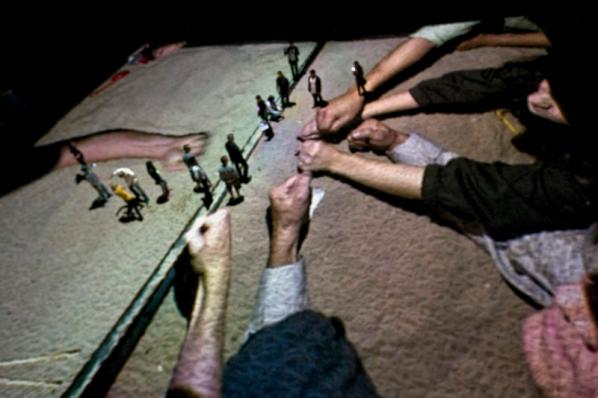
MG: How have they influenced your own practice and could you share with us some examples?
LHL: I think these examples added to my conceptual dimensional and historical overview which has been reflected in my practice. There are direct links also, like how the breathing machines and suicide machines relate to Tinguely, or how Roberta relates to Duchamp and Breton. But these are obvious and on the surface. The deeper perspectives embed themselves into the structure and architecture of the work. Political references like Civil Rights and The Feminist Movement are part of the core of the time I lived through and the resulting collage that is my work.
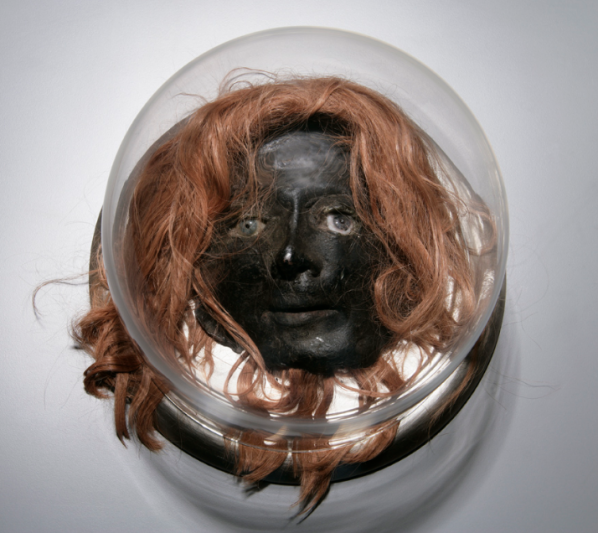
MG: How different is your work from your influences and what do you think the reasons for this are?
LHL: I think we all work in the time frame we are born into, and if we are lucky use the materials or invent the technologies to give presence and voice to the political gestures of that era. We cannot produce work from another era other than what we inhabit and really have to be in tune with the global framing of the tools and language invented during our life time.
MG: Is there something you’d like to change in the art world, or in fields of art, technology and social change; if so, what would it be? How would that happen?
LHL: Of course I would open up the process and systemic repressions, which would hopefully result in eradicating censorship, and the making more transparent the capitalistic underpinnings that are polluting access, value and visibility. In the 70’s, I did the first prison art project in San Quentin, and many early public art works geared toward social change, and it just required fortitude and clarity that resulted in breaking down systems of perceived values.
MG: Describe a real-life situation that inspired you and then describe a current idea or art work that has inspired you?
LHL: Well, hearing about Steve Kurtz’s predicament and the unfairness of it caused me to make the film Strange Culture. I personally experienced exclusion and rejection – as did many women, and that inspired !Women Art Revolution. I think work comes out of awareness of the situations of one’s time.
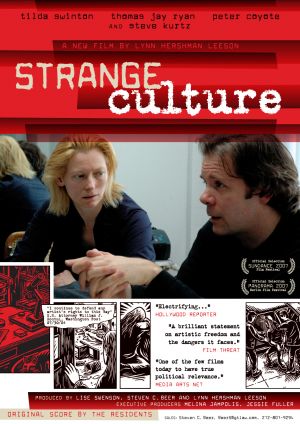
Steve Kurtz’s nightmare began on May 11, 2004, when he awoke to find his wife Hope dead of a heart attack. Police responding to his distressed 911 call became suspicious of scientific paraphernalia in his house (materials for an art project on genetically modified food) and contacted the FBI. Soon his world was turned upside down. Only hours after his wife’s tragic death he was suddenly a murder suspect, an accused bioterrorist, and a pariah to all but his closest friends.
The film is told through a unique blend of interviews, documentary footage, and reconstructed scenes starring Tilda Swinton, Thomas Jay Ryan, and Peter Coyote, Hershman’s critically-acclaimed film is a sophisticated, look at how the traumatic events of 9/11 altered American society and undermined its long-held values. [1]
MG: What’s the best piece of advice you can give to anyone thinking of starting up in the fields of art, technology and social change?
LHL: Stay true to your vision, forge ahead no matter what the obstacles are and keep your sense of humor.
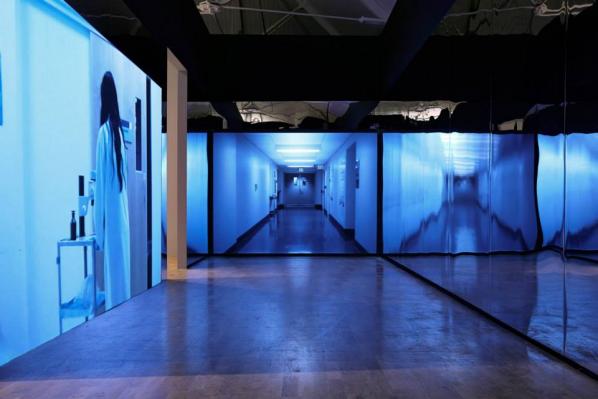
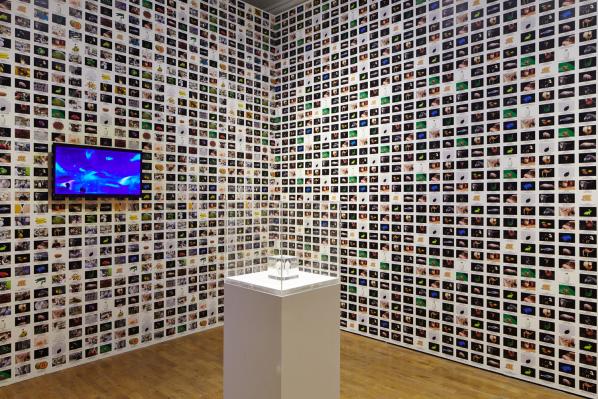
“Ms. Hershman Leeson continues to use art as an advance warning system in new work, developed with scientists, that focuses on, and participates in, the phenomenon of genetic manipulation. The show’s most recent piece is an installation of wallpaper made from images of hybrid animals, plants, and human limbs created through DNA manipulation, regenerative medicine and 3-D bio-printing. It looks great in the gallery, and like much of this artist’s work, it takes both ethics and aesthetics in ungraspable directions.”[2]
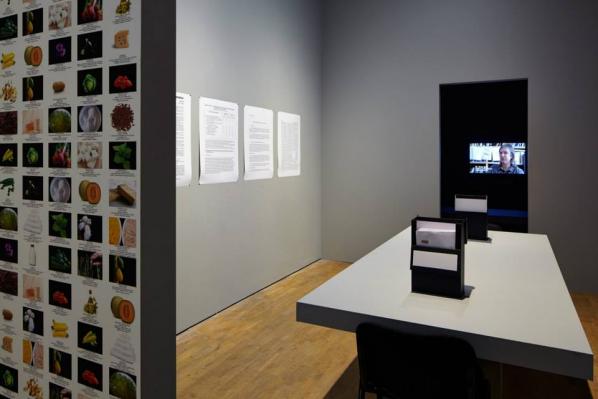
MG: Finally, could you recommend any reading materials or exhibitions past or present that you think would be great for the readers to view, and if so why?
LHL: The Art and Technology show in MdM at Salzburg, my exhibition and catalogue for The Burden of Guilt. The Electronic Super Highway and catalogue coming up at Whitechapel next year. Recommendations for catalogues: !War Graphic Novel, Marshal McLuhan, Rebecca Solnet’s River of Shadows, Edweard Muybridge and the Technological Wild, Kristine Stiles: States of Mind, Peter Weibel: The Global Contemporary and the Rise of the New Art World, and so many others. I also think for instance that James Watson’s Double Helix is beautifully written. So many possibilities for educating one’s self exist.
With Virginia Barratt, Francesca da Rimini, Cory Doctorow, Shu Lea Cheang, Jennifer Lyn Morone™ Inc, Andrew McKenzie, Angela Oguntala, Dr. Richard Stallman, Stelarc, Jacob Wamberg, Lu Yang
Inspired by the Phillip K Dick short story “The Electric Ant” this year’s CLICK seminar curated with Furtherfield explores how identity and perceptions of reality have changed in a world where humans, society and technology have merged in unexpected ways. Who are we, what’s real, where can we expect to go from here, and how can we get there together?
From future shock to FOMO (fear of missing out), accelerating technological change has disrupted our perception of ourselves and the world around us. Pervasive computing, genetic engineering, artificial intelligence, drones and robotics, neural interfaces and implants, 3D printing, nanotechnology, big data and ever more technologies are redrawing the boundaries of what it means to be human and what it means to be you.
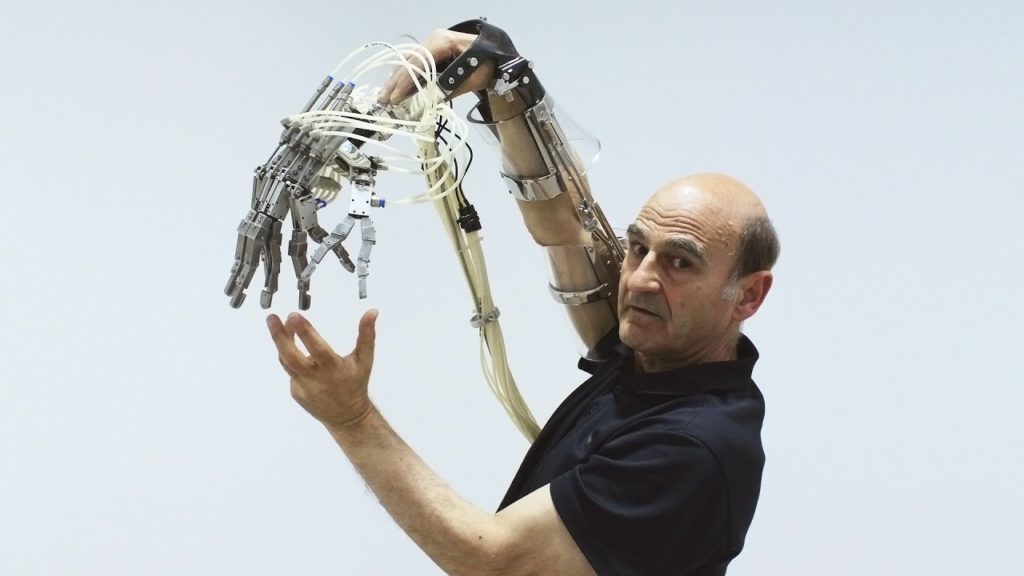
At the same time the design and unintended consequences of technology are creating new mass behaviours. And the productive forces of social media, peer production, hacker culture and maker culture are creating new possibilities for creation and expression. All of this changes how we relate to one another within society as part of the public.
This years CLICK festival, co-curated by Furtherfield sets out to explore questions related to identity and perceptions of reality in a world where humans and technology have merged in unexpected ways.
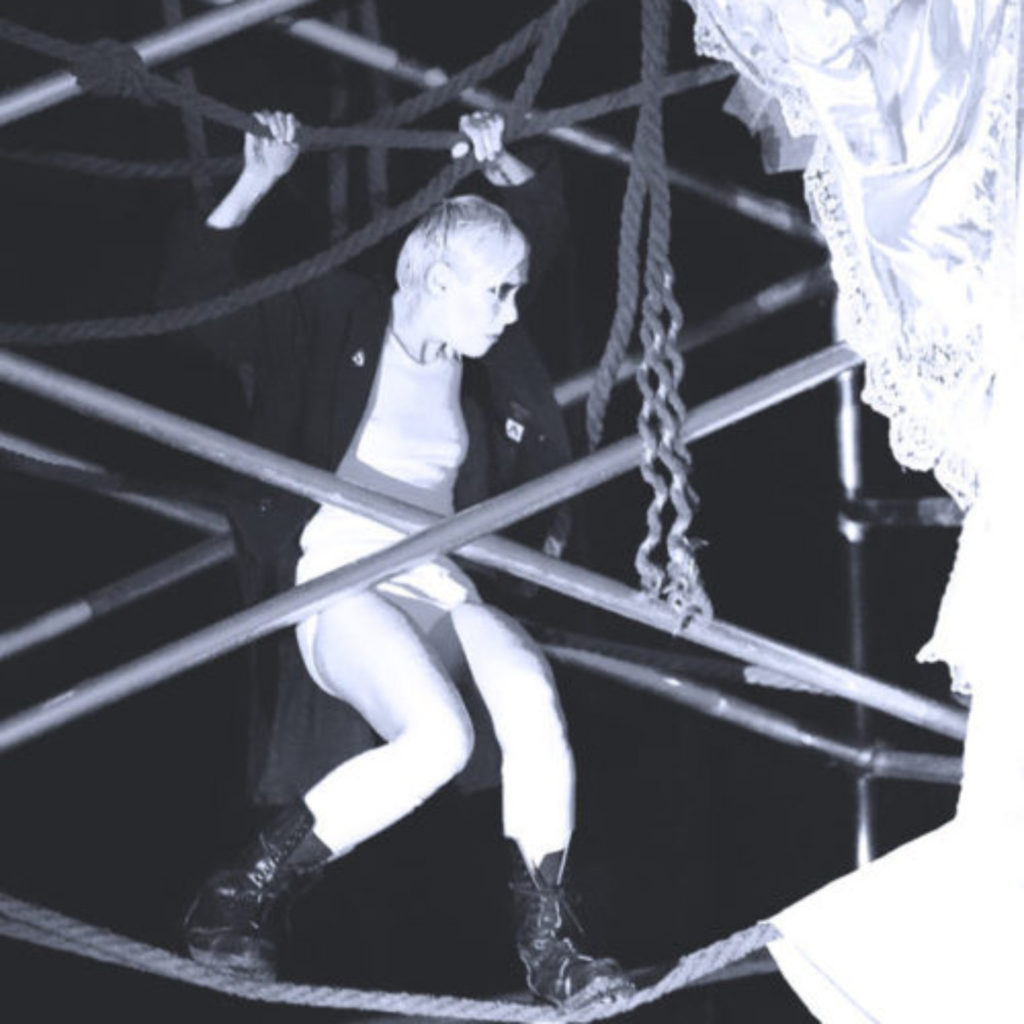
Virginia Barratt. VNS Matrix founder, cyberfeminist, Virginia Barratt is a PhD candidate at the University of Western Sydney in experimental poetics. Her doctoral topic is panic, engaging tensions between ontological meltdown/psychic deterritorialisation and ontological security. Panic is remediated from its pathological narrative and reimagined as a space of urgency/agency from which to act. Her work of performative text, SLICE, is forthcoming from Stein and Wilde.
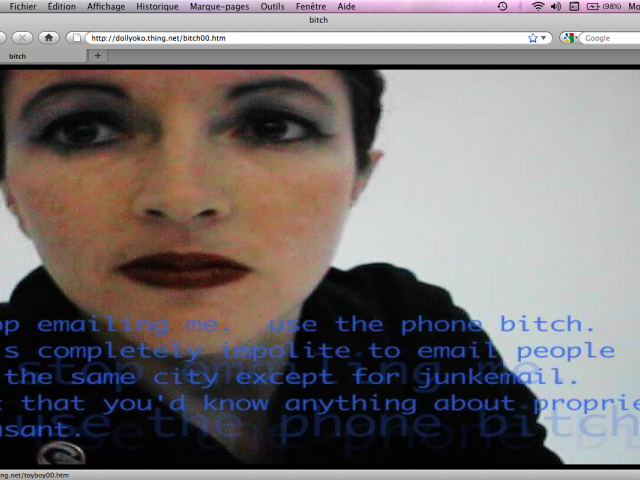
Francesca da Rimini explores the poetic and political possibilities of internet-enabled communication, collaborative experimentation and (tel)embodied experiences through projects such as her award-winning dollspace. As cyberfeminist VNS Matrix member she inserted slimy interfaces into Big Daddy Mainframe’s databanks, perturbing the (gendered) techno status quo. Her doctoral thesis at the University of Technology Sydney investigated cultural activism projects seeding radical imaginations in Jamaica, Hong Kong and the UK. A co-authored book, Disorder and the Disinformation Society: The Social Dynamics of Information, Networks and Software, will be out in May 2015.
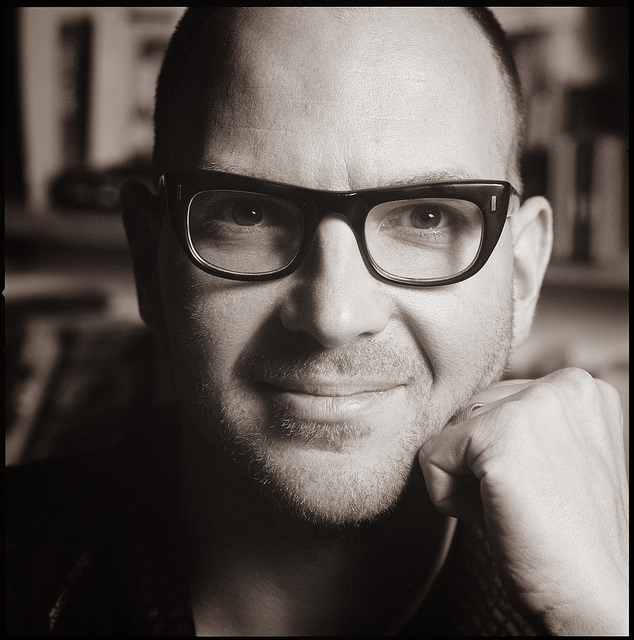
Cory Doctorow is assigned the label Internet philosopher, who writes, blogs and debates about online rights. Doctorow is convinced that copyright is an out-dated idea that damages the Internet and criminalizes peoples’ online actions improperly. According to Doctorow the current regulations of copyrights are obsolete by the unstoppable copy machine we call the Internet, which continues to produce samples of available online material such as pictures, music and text. Cory Doctorow is also an award-winning science fiction author and co-editor at boingboing.net.
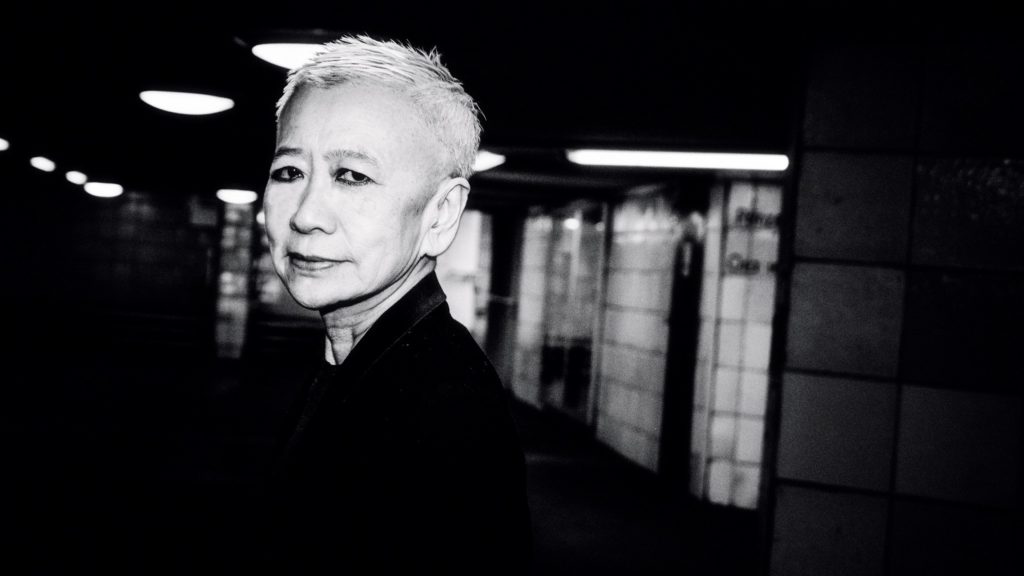
Shu Lea Cheang is known for her pioneering work in the field of media art and she is a true multidisciplinary and activist artist whose work spans from film to net art and performance (online, and in galleries) and video installation. Beginning the 1981 she was involved in the media activist’ collective ‘Paper Tiger TV’. Among her important multimedia works is the ‘Brandon Project’ (1998-99). Guggenheim Museum’s first official engagement with the then-emerging medium of internet art and one of the first works of this medium commissioned by a major institution. Following the production of the cyber porn film ‘I.K.U.’ (2000)(first porn film to be shown at the Sundance Festival) she focused on questions of copyrights and economy in media culture. Shu Lea Cheang holds a BA in history from the National Taiwan University, and a MA in film studies from New York University.
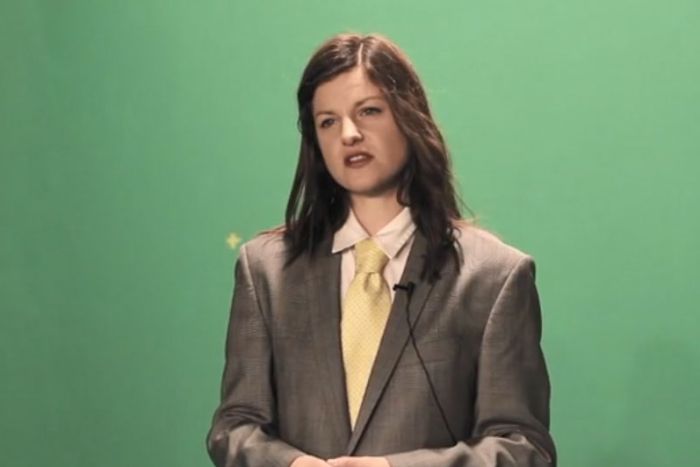
Jennifer Lyn Morone™ Inc (US). In a world before the Internet – information, transmission and dissemination was a controlled and regulated endeavour. The advent of the information superhighway, which is currently littered with social media sites run by billion dollar corporations, has blurred the lines of community ownership of one’s personal information and the individual. By incorporating herself she effectively wrestled the control of her digital self, back from corporations and took an active role in the sale of her information. Morone has been motivated by an underlying fascination with the relationship between technology, human beings, and the socio-economic political implications the melding of the two produce. That social concern, spurned Jennifer to create Jennifer Lyn Morone™ Inc.
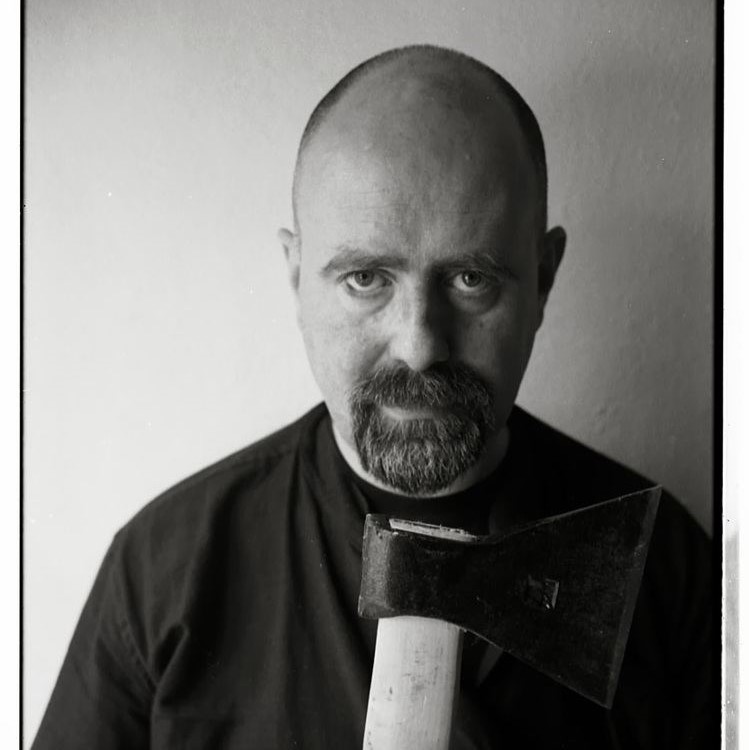
Andrew McKenzie (UK). The British Andrew McKenzie is the core of The Hafler Trio. His professional career began more than 3 decades ago and through the years he has worked with different professions such as audio designer, psychotherapist, hypnotherapist and workshop leader in Creative Thinking. McKenzie is also co-founder of Simply Superior where he teach creative processes that challenge the way you think in order to make you realize what you know, and are aware of not knowing. McKenzie’s projects and present goals all involve applying everything learned by experience over the last 48 years for the benefit of other. Andrew McKenzie defines himself as a mood engineer, specializing in changing people’s lives.
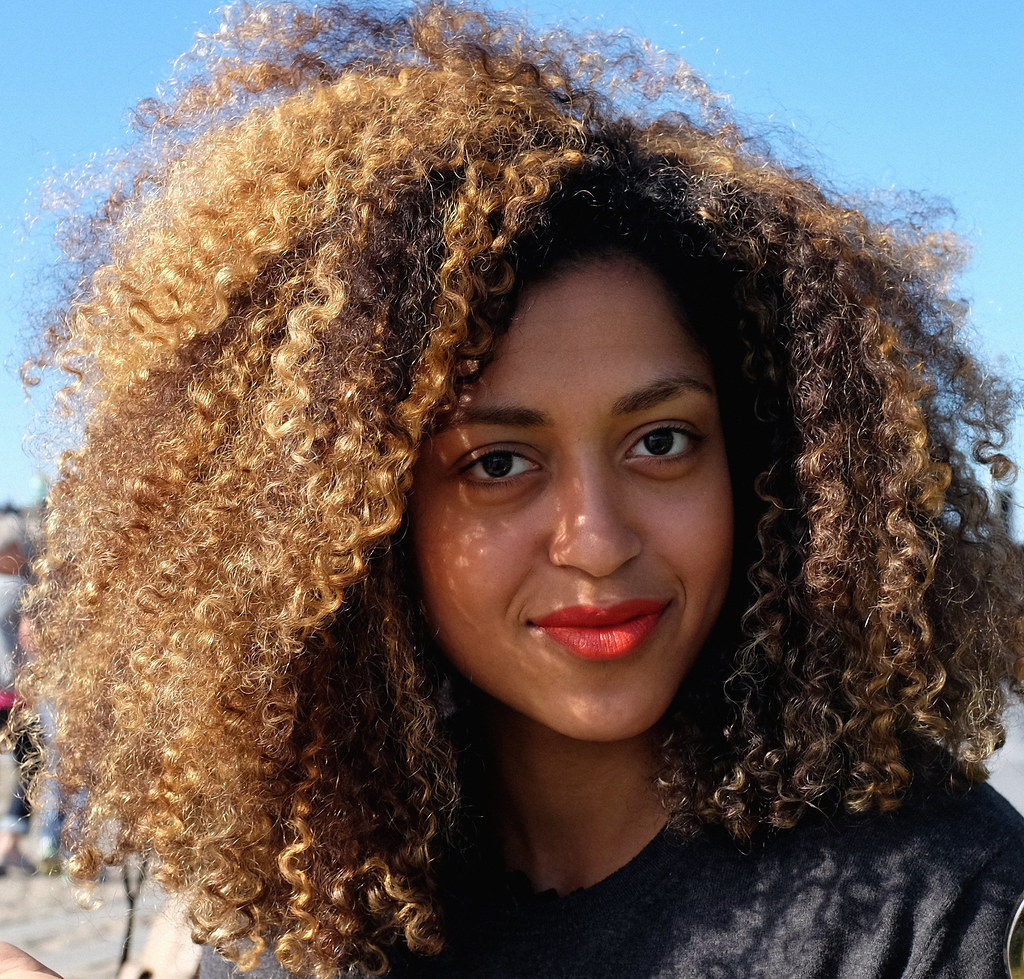
Angela Oguntala (US/DK) is a designer whose work sits at the intersection of technology, design, and futures studies. Currently, she heads up an innovation lab for Danish designer Eskild Hansen, envisioning and developing future focused products and scenarios. In 2014, she was chosen by a panel consisting of the United Nations ICT agency, Ars Electronica, and Hakuhodo (Japan) as one of the Future Innovators for the Future Innovators Summit at Ars Electronica – called on to give talks, exhibit her work, and collaborate on the theme ‘what it takes to change the future’.
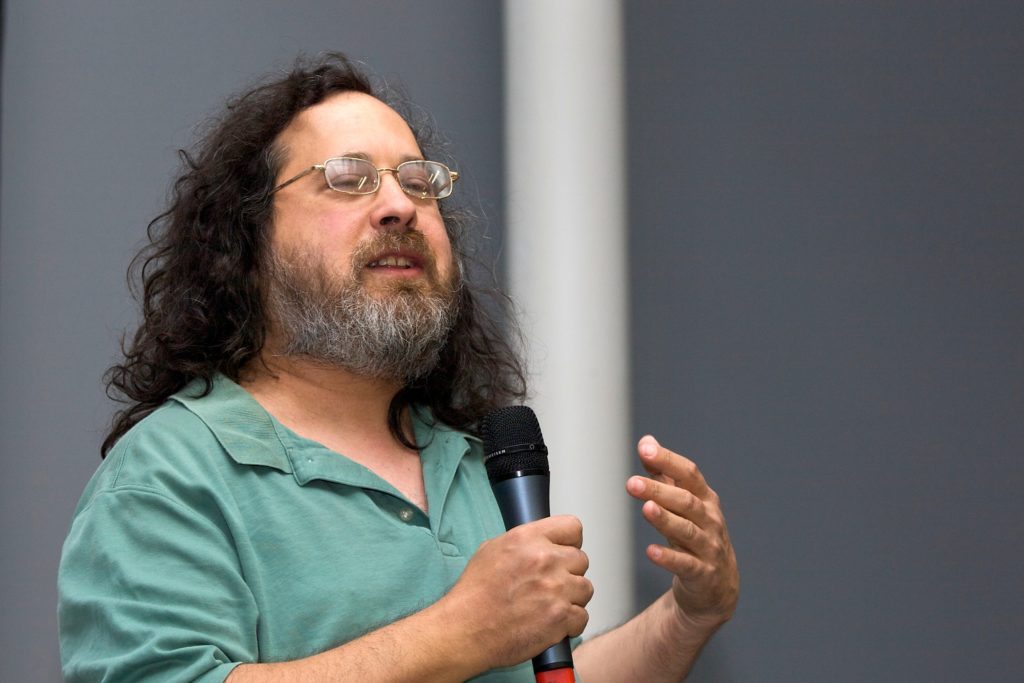
Dr. Richard Stallman launched the free software movement in 1983 and started the development of the GNU operating system (see www.gnu.org) in 1984. GNU is free software: everyone has the freedom to copy it and redistribute it, with or without changes. The GNU/Linux system, basically the GNU operating system with Linux added, is used on tens of millions of computers today. Stallman has received the ACM Grace Hopper Award, a MacArthur Foundation fellowship, the Electronic Frontier Foundation’s Pioneer Award, and the Takeda Award for Social/Economic Betterment, as well a several doctorates honoris causa, and has been inducted into the Internet Hall of Fame in 2013.
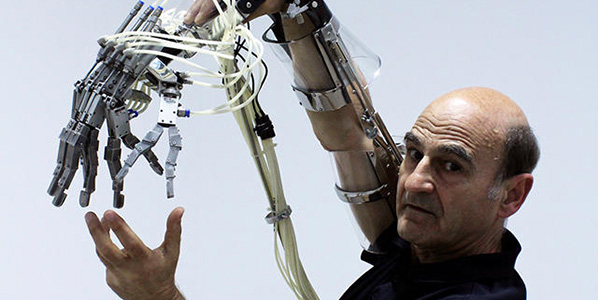
Stelarc (AU). An extra ear. A third arm. Six legs. A walking head. The Australian performance artist Stelarc is questioning and challenging whether or not it is possible to optimize the abilities of the human body. Stelarc has since the 1960s not hesitated to include advanced technology in his projects. After having examined several test on his own body, he announce a manifest claiming that the human body is out-dated and no longer meets the information society we live in. Stelarc uses his artwork to convey how the human body hypothetically will appear in the nearest future, if the technology is considered an extra dimension to the evolution.
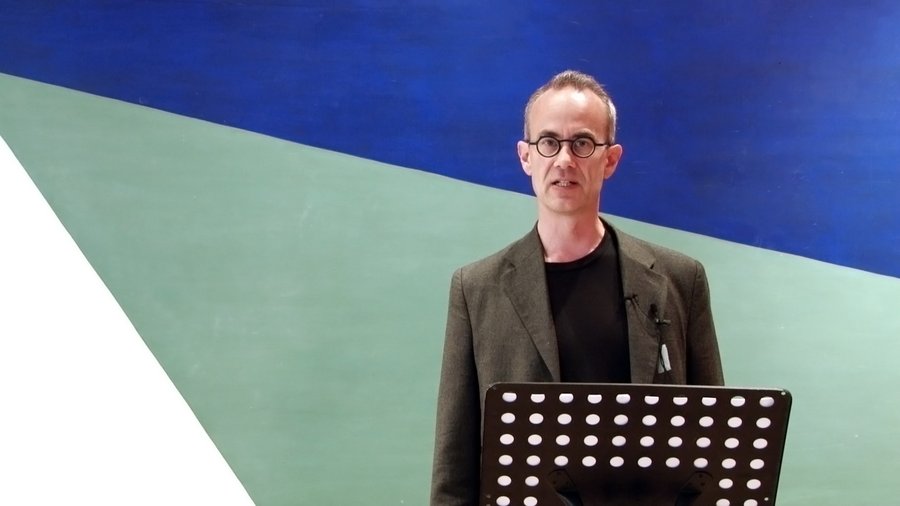
Jacob Wamberg, Professor of Art History at Aarhus University. Principal Investigator for Posthuman Aesthetics. In the posthuman field, he has co-edited The Posthuman Condition: Ethics, Aesthetics and Politics of Biotechnological Challenges (2010) with Mads Rosendahl Thomsen et al., and is now working on tracing the early contours of the posthuman paradigm (ca. 1900-1930), focusing on Dada, Futurism and Functionalism.
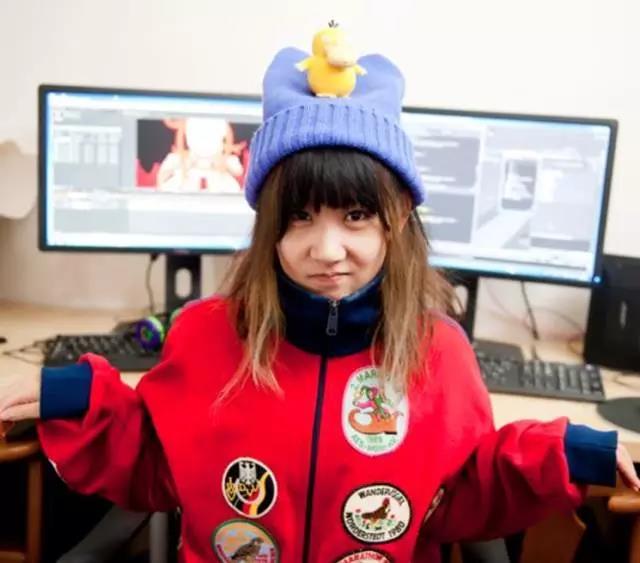
Shanghai based artist Lu Yang utilize a range of mediums known from pop culture such as Japanese manga and anime, online gaming, and sci-fi. She mixes these with discourses of neuroscience, biology, and religion, when she asks what it means to be human in the 21st century. Her depictions of the body, death, disease, neurological constructs, sexuality/asexuality, gender is unsentimental, confrontational and in their morbid humor not for the squeamish. Lu Yang is one of the most influential Chinese contemporary artists rising at the moment. She is a graduate from the China Academy of Art New Media. Her work has the last couple of years been internationally shown at museums and galleries and she has in 2014 been residency at AACC in New York and Symbiotica in Australia.
Please visit the CLICK website to purchase your ticket.
Ticket: 350 DKK. / Student: 250 DKK.
My Voice Means is a workshop that gives participants an opportunity to listen mindfully to the sound of their own voice, to discover the many layers of its meaning, and to discover how this process can be expanded by means of technology.
In a three hour session you will:
Cost: £20
To book a place visit http://tinyurl.com/mnwbj6h or contact info@contemplatech.net
Delivered by Contemplatech, a creative collaboration by Ron Herrema and Ximena Alarcón
Featured image: Jane and Louise Wilson – ‘False Positive, False Negative’ (2012 Screen print on mirrored acrylic)
The Negligent Eye the Bluecoat Liverpool Sat, 08 Mar 2014 – Sun, 15 Jun 2014 http://www.thebluecoat.org.uk/events/view/exhibitions/1971
Featuring artists: Cory Arcangel, Christiane Baumgartner, Thomas Bewick, Jyll Bradley, Maurice Carlin, Helen Chadwick, Susan Collins, Conroy/Sanderson, Nicky Coutts, Elizabeth Gossling, Beatrice Haines, Juneau Projects, Laura Maloney, Bob Matthews, London Fieldworks (with the participation of Gustav Metzger), Marilène Oliver, Flora Parrott, South Atlantic Souvenirs, Imogen Stidworthy, Jo Stockham, Wolfgang Tillmans, Alessa Tinne, Michael Wegerer, Rachel Whiteread, Jane and Louise Wilson.
The Negligent Eye revolves around the way a digitally-native generation of artists – particularly printmakers – are questioning their relation to the digital, using the notion of ‘scanning’ as a kind of mid-state of the creative process of the human-digital hybrid. The show is co-curated curated by the Bluecoat’s Sara-Jayne Parsons and head of printmaking at the RCA, Jo Stockham, and features several works by her graduates, and other artists from around the RCA, such as Bob Matthews and Christiane Baumgartner. “The relationship between the material and virtual worlds is a question, a set of contradictions we are all inside and how technical images exert their influence on our everyday experience is of ever increasing importance.” Jo Stockham.

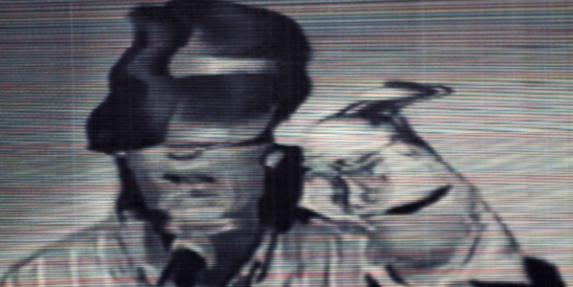
In her article Too Much World: Is the Internet Dead? Hito Steyerl asks what happened to the internet, after it died – that is, in an era of the “post-internet” after it stopped becoming a possibility, even in the midst, because of, and symptomized by, its permeation of everything. Steyerl is a major force in understanding our relationship to digital images, and her use of ‘death’ occurred to me often during viewings of this show and surrounding events, particularly as it could be applied to the post-digital.
So in a sense, I experienced the show as an autopsy of the digital image. From the tragic, simian face looking out from the first ever digital image, taken by Russell Kirsch of his son in 1950, exhibited at two points in the exhibition like an insistent memory. To Marilène Oliver’s figures from her 2003 Family Portrait series where bodies have been evoked as series of horizontal cross-section prints layered on acetate, so that they appear as though stored, but only partially in this world; the exhibition continually references, exemplifies and unpacks the death of its medium.
The post-digital is a paradoxical term – at once assuming the reliance of all contemporary culture in digitality, but also looking past it; affirming the death of a form, while embodying its afterlife. This is what Elizabeth Gossling’s images of a dead comedian says to me, when it is scanned from a computer screen and printed back on to archival paper, with his image waving from behind an ether of static, living in the solid pulp. The best works in this show, Gossling’s included, speak very eloquently about the post-digital, and how artists are motivated into hybrid forms of production, always acknowledging and working in a context of the saturation of the digital.

The notion of saturation, and its implications of the dissolution and liquidity, itself saturates the show: the first work, Maurice Carlin’s monumental print, scrolling down from the ceiling of the vide space is in one sense a spectral ancestor of Monet’s waterlilies, but with gashes and pustules of CMYK colour oozing up from behind the serine blue and greens of the pond, and white pixel-like rectangles plugging up the gaps; London Fieldworks’ 3D image of data collected from Gustav Metzger’s brain while he thought of nothing, is presented on a screen with a trickling sound – perhaps of information leaking inexorably back in?

Marilène Oliver’s glitch-sculpture of body parts fused in the heart of the 3D scan/print machine hang in the chute of the gallery corridor, their surfaces mid-ripple as though submerged; Jo Stockham’s etherized black and white shot of an element of the London skyline, seen perhaps through a teary bus window, but now writhing with red in its afterlife as a veined and depthless skin.

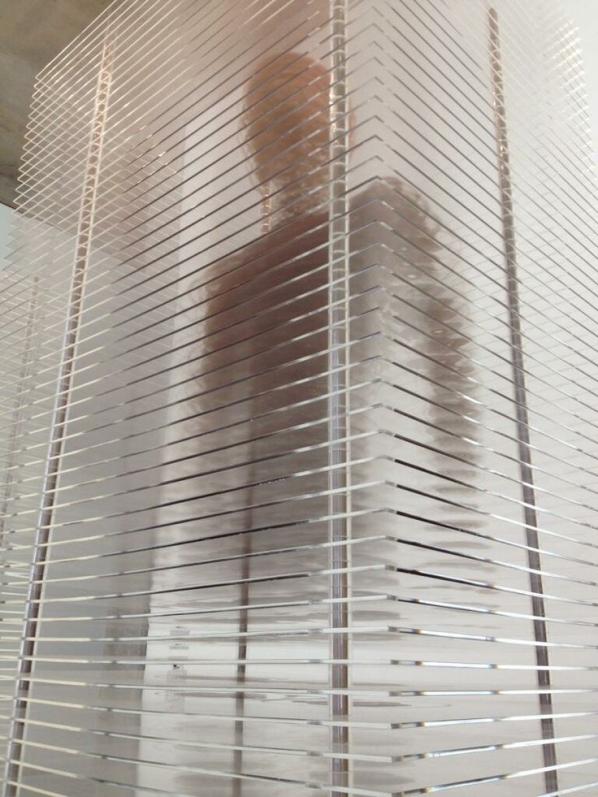
Using damage and error to expose the affectivity of a medium, particularly in the context of the digital is the central mode of Glitch Art. I have already used the term glitch to describe the aesthetic of Marilène Oliver’s sculptures, and the traces of digital-to-digital scan in Gosling’s work and the rich material pixilation of Christine Baumgarner’s inscription of CCTV camera stills into largescale wood prints, also contain these signatures.
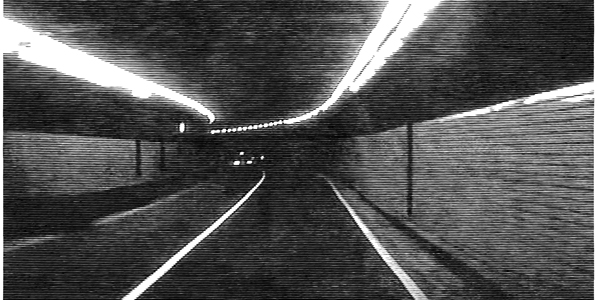
If there is a criticism to be leveled at these admirable and, frankly gorgeous, works. It is in their distance from what Rosa Menkman refers to as the moment(um) of the glitch. In the medium of print-making, the material fact of the object dominates, and with this show, no-matter the stated and playful interest in the ‘between-state’ of scanning, there remains the focus on material production – and therefore an irrefutable commodification.
Prints on archival paper and tempered steel, casts in plaster and large-scale hardwearing plastics, each speak of an appropriation of the tactical and fluid glitch, and its migration into commodifiable form. Maurice Carlin’s large-scale printwork could adorn a restaurant wall, just as Monet’s waterlilies functioned during his era, and Oliver’s sculptures also speak and modernise the language of sculpture as produced for private collections through the ages.
There are works also which say nothing of the ‘post-digital’, such as Imogen Stidworthy’s Sacha, a deeply thoughtful study of a wire-tap transcription ‘artist’ Sacha van Loo. Stidworthy’s enigmatic works are often hard to pin down thematically, and here it feels like the loft-type space of Gallery 3 has been used as an outer limit to the reach of the show. And then there are other works that say nothing at all and lessen the show’s conceptual rigor. I see Jeaneu Project’s peice, and think ‘smudge lawn’. I see a Cory Archangel print and a Rachel Whitereed miniture and their names flash through my consciousness like a Google Glass press release.
Truly though, this is a really refreshingly vibrant and precient show at the Bluecoat, and a great partner to the Mark Lecky exhibition featured at the venue last year in its pressing contemporaneity. The exhibition has also been a fulcrum for a really interesting series of events which have dealt with image production – including a day of talks and presentations, i-Scan, artist talks from contributing artists such as Imogen Stidworthy, and independently curated events such as the second in Deep Hedonia’s excellent Space/Sound series, where artists such as Madeline Hall, Jon Baraclough, Simon Jones and Andy Hunt explored the multiple angles from which digital scanning can be exploited as a performance and av medium. As with the Mark Lecky show, there is something about the context of the Bluecoat, as Liverpool’s most paradoxical space, which delivers an archival retrospective out of the most up-to-date material, and this tension is what pulls appart the body of works before us.
The Rubik’s Cube is not just a forgotten toy from the 80’s. The fact is that it’s even more popular than ever before. You can play with this great puzzle here.
Eva Kekou met Tobias Rosenberger at the international e-MobiLArt workshop which took place in Athens, Vienna and Rovaniemi, in turn these led to a number of exhibitions and successful collaborations between artists and theorists. She now invites him to discuss his work, issues of surveillance and how a young European artist views the situation in China and what he expects from his interaction with the Chinese art scene.
Tobias Rosenberger (b. 1980) is a German media artist who works at the crossroads of media art, visual arts, and performance. He has produced art works in Yemen, Spain, Mexico, India, and Ukraine etc. Since 2011 he has been based in China, where he teaches at the College of New Media Art, Shanghai Institute of Visual Art.
“Nowadays, anyone who wants to combat lies and ignorance and to write the truth must overcome at least five difficulties. He must have the courage to write the truth when it is suppressed everywhere; the wisdom to recognize it, although it is concealed everywhere; the skill to use it as a weapon; the judgment to choose those in whose hands it will be effective; and the cunning to spread the truth among such people.” (Bertolt Brecht)
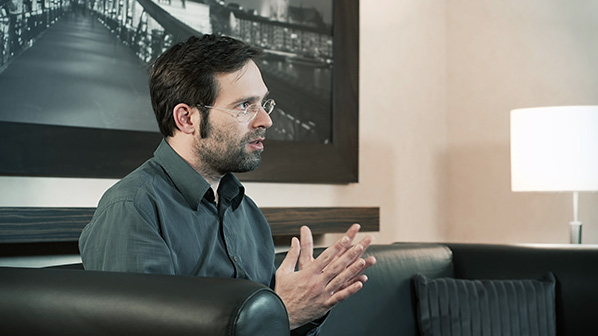
Eva Kekou: I would like to start this interview with this quote which seems to be significant for your work and in particular the recent one – the secret race film and discussion at Goethe Institut Washington. As you well state in your event invite: “It was pure coincidence that for a few days in the summer of 2013, two unrelated events simultaneously dominated the major headlines in the German press: the monitoring and spying scandal of 2013, triggered by Edward Snowden’s leaks of National Security Agency top-secret classified documents, and the official acknowledgement of the prevalence of doping in competitive sports, best symbolized by Lance Armstrong’s televised confession.” What is the significance of surveillance in a globalized social and political context and where is the place of art within it? There are obvious reasons you decided to launch this in Washington through Goethe but I would like you to comment on this.
Tobias Rosenberger: Surveillance and espionage are as old as civilization. Power was always constructed, maintained, and expanded through monitoring, categorising, repressing, and excluding people. We all know that the digital apparatus opens a new world of possibilities to organize, quantify and control life and society in a before unknown scale, speed and efficiency. While I agree that we need early warning models to anticipate and fight cruelty and injustice whenever possible, I don’t believe that we can draw a sharp border between an evil surveillance that fuels unfair and inhuman systems and a necessary one that pretends to save dignity and a lawful order. The challenges of our time can no longer be met by elitism and secretiveness, but require the joint efforts from the middle of society. An independent art that rejects the simple desire for (self-)confirmation does not only open a non-biased discursive space for critical reflection, but it also has the potential to demask and break the mechanisms of power, as long as it takes its audience seriously. But to be able to do so, art also has to find its audience.
EK: It occurs to me that place and space play a very important role in your work and inspiration. How do these relate with each other with pieces of your work in a globalized and mobile network underlined by politics?
TR: I have a very pragmatic approach to what I am trying to do: Not following a specific agenda and always staying as curious and open as possible. This requires both a certain naivety and an observing attitude. I never start an artistic process with a specific idea or question, but i get attracted by places and spaces that i try to discover without too much of my personal baggage. But since space and place are never abstract but segmented by politics both on macro and micro layers, the resulting works often deal with political questions.
EK: How did you become interested in China and what do you find fascinating or difficult working there? Is it interesting for you as a European?
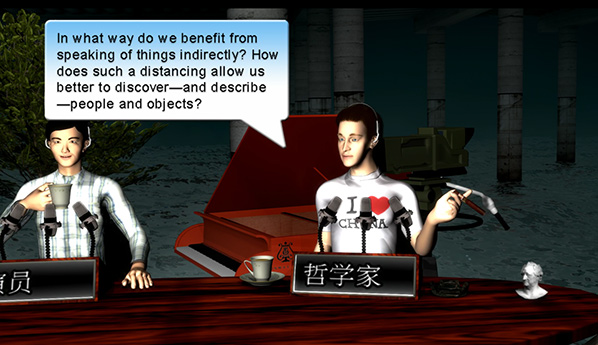
TR: I have a very special relationship to China. With my Chinese wife I decided three years ago to move there and to found a family. I was always fascinated by China as a cultural space, with a tradition of art and philosophy at least as long as in Europe. I also really like the food and the people there. As a foreigner I experience it as very fruitful to see things from a specific distance, both if I try to understand the culture, but also especially if I look back from there to where I come from. It is very interesting to observe the relation between art and politics, how the government here really appreciates art and how it is also afraid of it.

How artists, critics and curators fight for free space, a career, or both. In Shanghai you have both the global economy and the local life at your house-door. The country faces a lot of problems, and very often one can get the impression that things are not happening at all just because there is a small possibility that something unexpected could happen. So many people behave very pro-actively in a way that they won’t run into any problems themselves. But this maxim “to have everything running smooth” you certainly don’t only encounter in China.
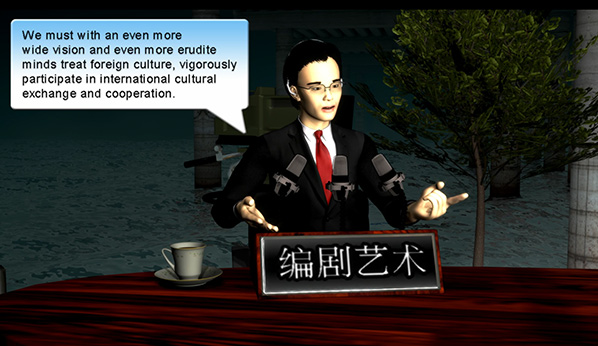
EK: Referring to some of your recent works (installation and performance): Choose any you like… How do you reach out to audiences and what is the main aim in your own work?
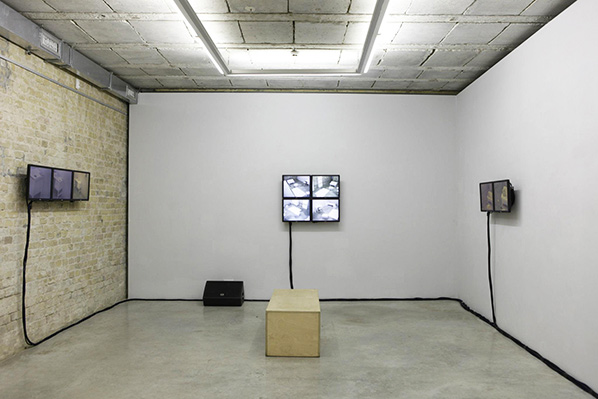
TR: “The First Twenty Years” is an installation that was shown in two different versions at the end of 2012 in Kiev and Dnipropetrovsk. I developed the basic idea for that work in 2011, when I was invited to spend some time in a small Ukrainian village near Kiev at a private artist residency programme. During that time the nation celebrated the 20th anniversary of its independence. There was a strange, partly paralyzed mood. But I also witnessed very controversial discussions with artists, curators and critics, and a new generation that seemed not anymore willing to accept living in a nation that was more and more perceived as a prison. So when I was approached during that time to do a work based on my experiences in the Ukraine, I decided to base it on Xavier de Maistres “Journey around my room” and Schuberts Music, which was inspired by a poem by Christian Friedrich Daniel Schubart.
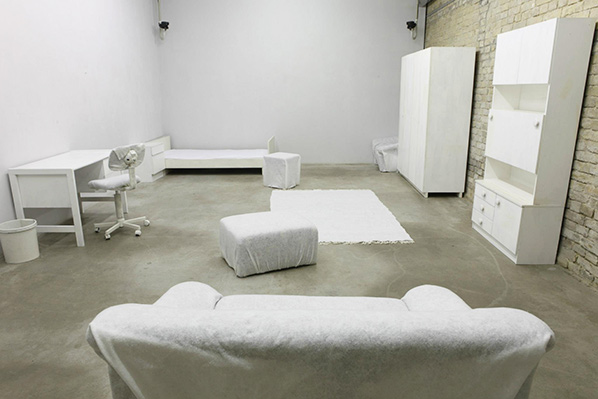
I didn’t intent to comment directly on the situation there, but rather was trying to understand for myself what was happening. For me, art is not about expression but about the creation of a space where everybody is invited to take a bit of distance so to be able discover something from different perspectives and to think in his/her own way.
Surveillance Cameras dancing to Schubert, on Vimeo
EK: Can you give us a bit more information about a project that you have described alsewhere in the following way: “Right now working on a light sculpture for permanent setup in a former WWII Top secret military site, where some crazy NS-Germany scientist wanted to invent an x-ray wonder-weapon to shoot planes and soldiers, this involves an always transforming multichannel-sound installation, motorized miniatures (arduino-controlled), 2 projectors and led-objects. I will make an extra independent video of this work, filmed with multiple moving surveillance cams.”?
TR: I was approached by a cultural initiative that runs today a small history museum in a former research bunker, which was secretly constructed in 1942 / 1943 underneath a camouflage building. I came across a letter in which a certain Professor, Dr. Ernst Schiebold, proposed “An additional weapon to fight and eliminate the crews of hostile airplanes and ground troops in the defensive via x-ray and electron radiation”.
A weird ten pages male war fantasy about a new kind of tubular x-ray canon, written in a crude mixture of physical pseudo-science, soft patriotic enthusiasm and German pedantism. Schiebold really got his bunker built to start with his research. Everything was kept top secret, but stopped 18 months later without results. I decided to bring Schiebold’s proposal back into the space which only existed because of it: As a pure proposal, enhanced and communicated with new media technology.
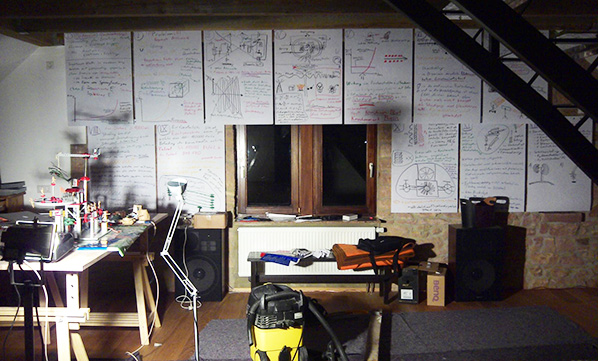
A lot of the tools that we are using as new media artists exist mainly through military development. So my intention was also to give something back. The audience will listen to single sentences that are randomly taken out of Schiebold’s letter and re-arranged into a constantly transforming synthetic sound atmosphere, which is synchronized with light beams crossing a motorized miniature military model. The toy miniatures cast shadows of moving soldiers and airplanes onto the walls. LED lights are flashing out of a tubular manhole, which was originally constructed to be used with a Betatron. All the technology that I use is quite low-budget and geeky. Last week I started to install the parts on site, and I have to admit that it is also a very weird experience for me to spend nights working alone in a former military research bunker, climbing down in a manhole and setting up the mockup of a “super-weapon” people researched in the darkest years of German history. Sure I will also try to document it properly.
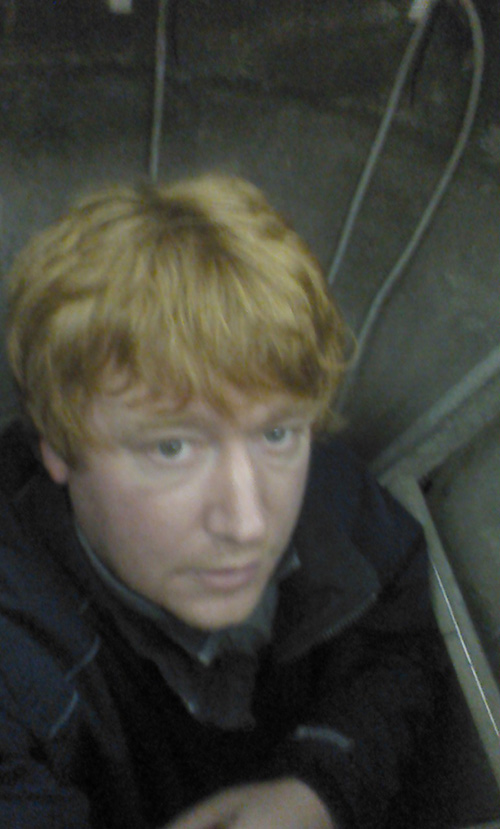
EK: Do you think art can be global and political, if not, what are the main restrictions we are all subjected to? How can art and artists make a difference in this respect?
TR: I think that art is per se political, since it deals with and also influences our perception of reality. And while all our lives are clearly connected in a global economy of good and information-exchange, art does also always operate on a global scale. As an artist I believe that it is worth to be curious and to investigate the (media) apparatuses and dispositifs that surround us, to take them apart and re-design them. What are they good for, what effects do they cause? While the world is getting closer, the world is never the same – people have different histories, problems, possibilities and hopes. As Europeans we take many things for granted, that other people see differently – or vice versa. I think artists can always make a difference, as long as they stay independent and continue to tackle serious questions, but don’t take themselves too seriously while doing so. We should laugh more together.
EK: What are your future aims and plans?
TR: I am looking forward to the new semester in Shanghai, where I will mentor the graduate works of eight students. I will also collaborate with Chinese artist Mujin (Lixin Bao) – a fellow teacher at the Shanghai Institute of Visual Art – on a series of works exploring the notion of the “Chinese Dream” and its perception both nationally and globally. I guess this dialogue will become quite interesting.
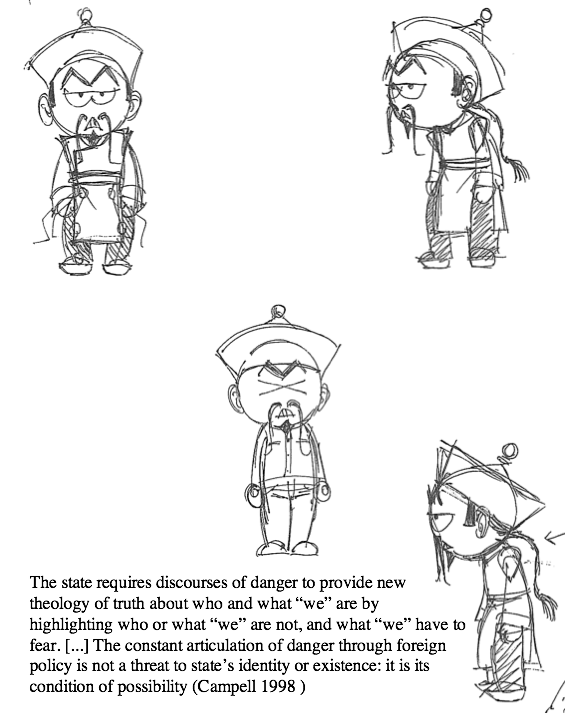
Roger Malina is a physicist and astronomer, Executive Editor of Leonardo Publications (The M.I.T. Press), and Distinguished Chair of Arts and Technology at the University of Texas at Dallas. Dr. Malina helped found IMéRA (Institut méditerranéen de recherches avancées), a Marseille-based institution nurturing collaboration between the arts and sciences.
Mariateresa Sartori and Bryan Connell are two artists recently based at IMéRA. Their work connects with human movement through the city, and addresses the intersection between technology and perception. Recent work by Venice-based Mariateresa Sartori has encompassed drawing and video. Bryan Connell, Exhibit/Project Developer at San Francisco’s Exploratorium, works especially with landscape observation devices and mapping.
Lawrence Bird interviewed Roger Malina, Mariateresa Sartori, and Bryan Connell about the intersection of their work with the city. Images above courtesy: Roger Malina, Rita Gambardella, Bryan Connell.
Lawrence Bird: Roger Malina, in your recent writing you make the case that science is no longer just a field of positive knowledge. Scientists are increasingly open to engagement with the arts — for example artists’ residencies at CERN. You’ve even argued that we’re in a crisis of representation as profound as that of the Renaissance or the 19th century, and this is “driving a new theatricalisation of science.”
Urban life has often been understood as performative – display, performance of social roles, presentation of oneself before others are all part of the public life in cities. How would you say that crisis of representation plays out with regards to this performative dimension of urban life? How is science implicated alongside art in the city, in these conditions?
Roger Malina: One of my arguments for the ‘crisis of representation’ really looks at Renaissance systems of representation — first driven by what the eye could see, and then the eye extended by microscopes and telescopes. These systems of representation were developed that led to a deep contextualising of the viewer in the world.
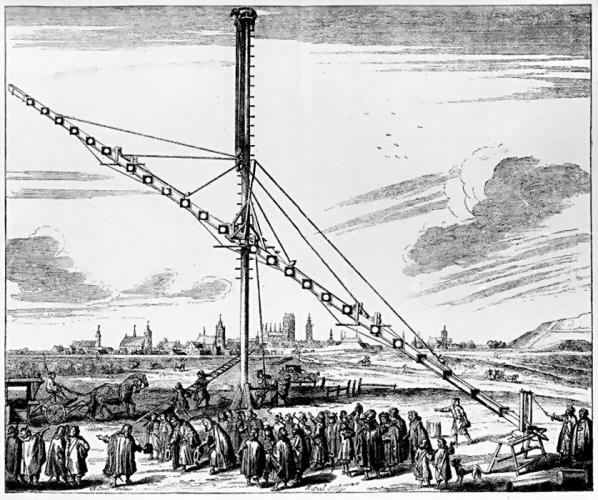
Today we are in a new situation because so much of our perception of the world comes not through extended senses but, in a real way, through new senses. This has been happening over a number of decades; the first wave of this was at the end of the 19th century when there was a cultural shock with the introduction of x-ray images, infra-red and later radio — which didn’t extend existing senses but augmented them.The most recent series of triggers maybe comes from the nano-sciences and synthetic biology — we now perceive phenomena of which we have no daily experience of (eg quantum phenomena). Field emission microsopy or MRI or some of the other new forms of imaging really don’t build on our existing experience — there are discontinuities and dislocations. Another element is of course the hand held device that leads to techniques for ‘augmented reality’ — I have a phone app that I can point at an aeroplane overhead and it tells me what the plane is, where it came from, and where it is going.
Coming to your question about the city — there is clearly a shift in map construction and reading — from the Cartesian map that we have been acculturated to. The ability to toggle between the bird’s eye view and the “street view”, and the ability to view maps that have multiple layers simultaneously are driving artists and others to develop new forms of representation.
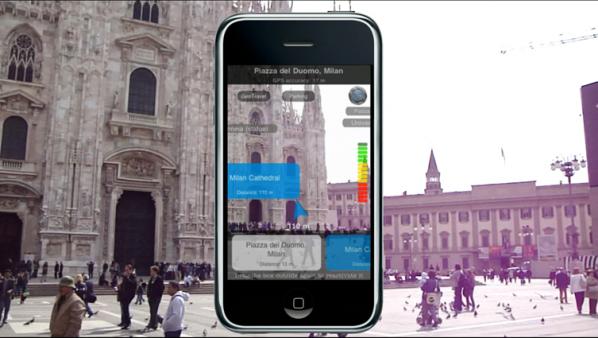
Someone whose work is interesting in this regard is Bryan Connell in San Francisco, he just finished an art science residency at IMéRA in Marseille. He was working on a large urban trail project called GR13 — 300 miles through industrial, urban, sub urban, and wild landscapes (the city had a hell of a time getting right of way through these areas). Bryan is currently working on a web site for the Marseille European City of Culture events, where he’s working on some of these questions of representation. The project involves a collective of ‘artist-walkers’ that I think fits right into this question of performativity.

LB: There’s currently a great deal of interest in the connections between representation, digital technology, and politics, for example the current Hybrid City II conference in Athens. As you’ve pointed out, these often underline the connections between what digital media mean for artists and what they can contribute to citizens — what’s emancipatory about them. What can art offer civil life in this context? Are there any conflicts or contradictions in that relationship?
RM: One pertinent example is the work of Bruno Giorgini, a physicist, and Mariateresa Sartori (visual artist) who work on the “physics of the city.” They were recently in residence in the IMéRA Mediterranean Institute of Advanced Study which hosts artists and scientists in residence who want to work with each other. We now have access to incredible amounts of data on human mobility (pedestrian and various forms of transportation) so it is now possible to study human behaviour quantitatively. Sartori discovered that she could tell many things about a person just through the morphology or topology of their movements through the city. Girogini discovered that people’s movements could be predicted at the 80% level, but 20% of the time he had to introduce what he called ‘social temperature’; in discussions he also referred to this as a ‘free will’ parameter. Barabasi has found similar results analysing cell phone GPS data of individuals. So its interesting to think of the development of cities as 80% predictable and 20% serendipitous. This of course then highlights the role of the arts and culture in making cities part of the cultural imaginary that drives people to make choices. Recently Max Schich here at the University of Texas has analysed very large data bases looking at where prominent people are born and where they die over the last 500 years. Immediately you can see how suddenly certain cities become cultural ‘attractors,’ say the way Berlin or Hong Kong are now. And of course cities are now trying to ‘design’ this into the development of cities. Here in Dallas there has been a huge investment in the ‘arts district’ and in institutions of higher learning in the belief that healthy cities require such investments. See for instance the US National Endowment for the Arts Program; there are many similar programs in Europe.
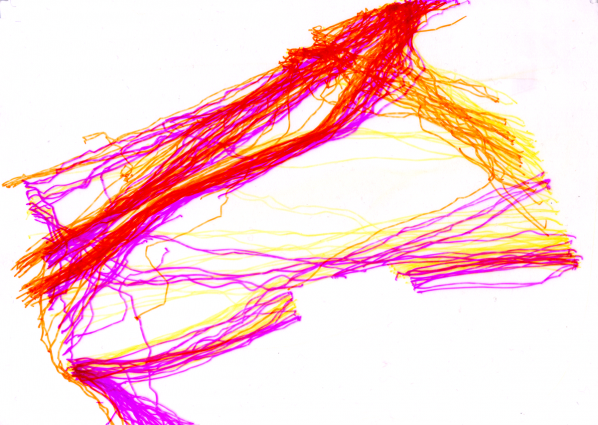
This doesn’t yet address your ’emancipation’ question. One of the things that is happening is that we are becoming a data taking culture (see the recent literature on ‘big data”). The cell phone has transformed every citizen (that has one) into a data taker. Of course much of this data is used by companies for marketing objectives. But many citizen groups are now able to take data for their social objectives. Some of this is captured by the ‘citizen science’ movement ( one example is here). There have been good examples of citizen’s taking data (on pollution, on illegal activities etc.) and then being in a position to challenge ‘authorities’ of various kinds whether scientific, political or economic (see for instance the way citizen groups have mobilised to collect data after man-made disasters such as oil spills, or illegal logging in forests).
A few years ago I wrote an open data manifesto which argued that I would like to advance a new human right and a human obligation:
1. Each of us has the right to the data that has been collected about ourselves and our own environment.
2. Each of must contribute to the knowledge construction by collecting and interpreting data about our own world.
Most scientific data collection is funded by public tax payer funding. The public has a fundamental right to all data collected and funded by public tax money.
LB: How do you imagine an artist’s training will change as these conditions evolve? And a scientist’s — could we foresee any kind of convergence?
RM: One interesting development is a cohort of hybrids, who have one degree in science or engineering and one in art and design ( for example J.F. Lapointe, a researcher at the National Research Council of Canada with degrees in molecular biology and dance) or degrees in Science or engineering and employment in art or design (like myself or Paul Fishwick, a key figure in the field of aesthetic computing). There’s been an emergence of art/science Ph. D. programs that take students from art or design or science or engineering. I suspect this cohort will grow over the coming years.
LB: Mariateresa Sartori, your IMéRA research project with Bruno Giorgini focused on mobility in the city. Can you tell us a little bit about how your work and Dr. Giorgini’s work complemented each other? What kind of evidence did you bring to the table as an artist?
MS: The project I worked on with Bruno Giorgini developed an exploration that began with earlier work in Venice. There I created a series of drawings using a rudimentary, even crude procedure: I traced out the movements of each pedestrian in the Piazza San Marco, drawing their paths with a felt-tipped pen on a transparent sheet placed over the computer monitor. I then faithfully transferred the results onto ordinary large sheets of white paper. The lines thus drawn in different directions created a space, drawing a St. Mark’s Square that is actually not there. As well as the actual physical space, it is also a drawing of our individual and collective manner of relating to space. Each single path determines the route of others, in a continuous and reciprocal game of influences that makes our collective progress.
At IMERA we developed this method for a new environment, a city more ethnically and culturally plural than Venice. Together we set up procedures and tools for collecting data about mobility networks there: nodes, links, chronotopi. These drew on the work of Bruno Giogini’s Laboratorio di Fisica della Città of the University of Bologna. We shot videos focusing on specific behavioural patterns where strategies of shifting, approaching and distancing play a decisive role; and we were also attracted by the places and situations of pedestrian congestion. Using the same technique as in Venice, I translated these into drawings of movement. These again created a space that marks out squares and places which are actually not there, each synthesizing space, time and humanity in a single image.

LB: Is there an emancipatory or governance-related dimension to this work? Degrees of mobility have human rights implications. How does your work as an artist connect with these rights, especially the notion of the right to the city?
MS: The first goal when I work as an artist observing reality is observation, i.e. a way of observing that implies a new attention. The result is always instructive because I do not have particular expectations. After lines have been traced following my process, something always emerges and what emerges can be a useful and indicative element for the emancipatory dimension of the urban condition. I would say that Bruno Giorgini is more involved in that dimension than me, especially in the notion of the right to the city.
LB: There’s a current preoccupation among researchers in a number of fields with the relationship between representation, often engaged with/through technology, and urban life. How has your latest work connected with this relationship?
MS: My way of working with technological instruments such as computers is very particular and limited. I use the computer as a technical tool strongly mediated by the senses, i.e. by human perception. I am very interested in modalities of perception: they are so imperfect, yet sufficiently perfect to make our existence possible.
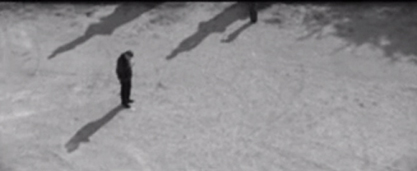
LB: You described the way you work with technological instruments as “particular and limited.” Another way to look at this is that you make the technological system slow down by inserting yourself into the process… and the result is your drawings, which still movement. Might this be one role for art — to insert the human into the machine? Much net art focuses on flows of information, virtual movement, and representing that. While not quite glitch art, do your representations of movement in some sense intentionally put a brake on the machinery?
MS: I find your words enlightening, you describe my way of working better than me….. Actually I insert myself into the technological process…..but this is not a statement of a position against technology.
I can say that what interests me the most (and art’s relation to science is just one instance of this) is the thread of connection between specific cases and general theory, between subjective and objective. Between, on the one hand, the singularity of events and, on the other, general theory. The individual’s experience is singular, unique; but there is always a thread, even if fine, that leads each individual case to a wider generalisation. What interests me is this incessant – indispensable as much as concealed – mental activity that every day leads us to search for generalisations and regulating principles. What interests me is the human tendency to comprehend phenomena, even the most complex, via schematic representation, via a generalisation that leads to the identification of organising principles. I mean “Comprehension” in very wide sense, where emotions and feelings participate too in embracing reality, including reality. Maybe in this sense I put the human in the machine…
There is a discrepancy between how we perceive reality, mediated by our senses, and the truth decreed by science. On a rational level we recognize the truth, but we cannot internalize in a deep way this knowledge; this is beyond our human capabilities. I think that in my artistic research I find myself in this deep discrepancy.
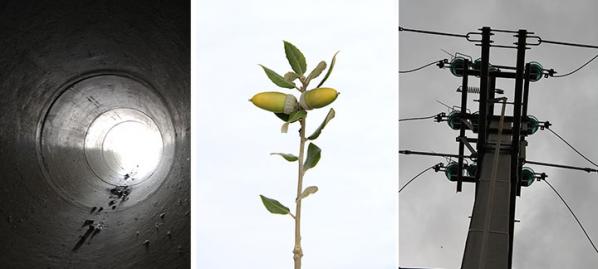
LB: Bryan Connell, your work in Marseille addresses, among other concerns, technology and its relationship to nature. Do you see the urban environment as playing any particular role in that relationship — of having a particular status in our negotiation of it?
Bryan Connell: One of the things that intrigued me about the metropolitan hiking trail in Marseille is the way it plays with our sense of meaning and value in the exploration of contemporary landscapes. Most long distance hiking trails are designed to lead out of urban environments, not into them. We don’t usually think of carrying a field guide that illustrates the taxonomy of fire hydrants, electrical pylons, or urban weeds on an extended city or suburban walk. That kind of engaged, systematic attention is usually reserved for wild natural terrains. From a traditional environmental perspective, the less altered a place is by human technology, the more scientifically interesting, ecologically exemplary, and aesthetically rich it’s going to be. Without undermining the validity of ever-present environmental concerns, the trail functions as an invitation into a more challenging and complex relationship to the emerging para-wilds and novel ecosystems that are arising at the intersection of the natural world and the technological infrastructure of the built environment.
Similarly, the Marseille trail doesn’t really focus on the kinds of urban sites that are traditionally thought of as having significant historic, architectural, or cultural interest. Instead, the trail route incites visitors into an exploration of the everyday environments and working landscapes of the contemporary urban transect – a world of parking lots, freeway overpasses, suburban developments, abandoned railways, and semi-rural wildlands.

Landscape ecologist Earl Ellis argues that to better navigate our way through the current geohistorical epoch, the Anthropocence, we must expand the traditional ecological concept of regional biomes into the parallel notion of “anthromes” – biomes that are complex interconnected melds of human technology and natural systems. In a sense, the GR 2013 Marseille trail is a sketch or system of exploratory paths into what a publically accessible, anthrome based urban ecology observatory might look like.
LB: A similar question is in relation to the image, especially sequential images. What does it mean for our negotiation of the relationship between nature and technology? Between science and art?
BC: We increasingly live in a networked digital metropolis with an image and information density that both mirrors and exceeds the high population densities of the physical metropolis. One topic of particular interest to me is the role these images play in transfiguring the quality of our desire. To what extent do scientific or aesthetic images that increase our ability to find meaning and satisfaction in observing and understanding urban landscape phenomena mitigate our need to physically alter the landscape to conform to an idealized image of what it should or shouldn’t be?
For example, the Marseille metropolitan trail didn’t require much physical alteration of the terrain – it’s a conceptually designated network of pre-existing roads, paths, streets and highways. The trail’s function is not to alter place, but alter the cognitive landscape of trail users so they have a richer sense of place. If you are fascinated by the diversity of ways a para-wild plant population has adapted to a technologically modified environment, do you need to engage in an energy and material intensive re-landscaping of that environment with a palette of conventional horticultural plantings to make it more “beautiful”? In this sense, constructing interpretive images of landscape is more than a way of augmenting a recreational hiking experience, it’s a way of shifting and re-configuring what we think we have to consume and alter to find meaning and vitality in contemporary landscapes.
http://uranus.media.uoa.gr/hc2/
Hybrid City is an international biennial event dedicated to exploring the emergent character of the city and the potential transformative shift of the urban condition, as a result of ongoing developments in information and communication technologies (ICTs) and of their integration in the urban physical context. After the successful homonymous symposium in 2011, the second edition of Hybrid City has grown into a peer reviewed conference, aiming to promote dialogue and knowledge exchange among experts drawn from academia, as well as artists, designers, researchers, advocates, stakeholders and decision makers, actively involved in addressing questions on the nature of the technologically mediated urban activity and experience.
The Hybrid City 2013 events also include an online exhibition and workshops, relevant to the theme
Hybrid City Conference 2013: Subtle rEvolutions will take place on 23-25 of May 2013.
The Hybrid City II events will take place at the central building of the National and Kapodistrian University of Athens.
This document was edited with the instant web content composer. Use the online HTML editor tools to convert the documents for your website.
MOVABLE BORDERS: THE REPOSITION MATRIX workshop
organised by Dave Young
Saturday 18 May 2013, 1-5pm
BOOKING ESSENTIAL. Please register with Alessandra.
The devices that once populated the creepy dystopian futures of science fiction have broken through into our daily reality.
Drones of dozens of different types are becoming a part of everyday life. They scout our public (and private) spaces, carrying out surveillance or reconnaissance in the service of nation states and as unmanned robotic tools, armed with missiles and bombs, acting in defence of “national security”.
According to a European commission document drones will be commonplace in the skies within a decade. There are already many companies building these airborne, robotic spies for military and police use and this has “prompted concerns from civil liberties groups, who fear that the unmanned aircraft will result in more forms of surveillance.” [1]
During the three weeks of Movable Borders: Here Come the Drones! people are invited to view artworks and join a workshop by artists who are contemplating how drones are changing the way we see and relate to each other and the world around us.
Artworks and projects by Bureau of Inverse Technology (US & AU), Lawrence Bird (US), Patrick Lichty (US), Dave Miller & Gavin Stewart (UK), The Force of Freedom (NL) and Dave Young (NL).
Bit Plane by Bureau of Inverse Technology (Natalie Jeremijenko and Kate Rich) is an early artistic reflection on the relation between technology and surveillance and, as such it can be seen as a precursor to the emerging DIY surveillance video enabled by the new availability of drones. The bit plane is a radio-controlled model airplane, designed by the Bureau and equipped with a micro-video camera and transmitter. In 1997 it was launched on a series of sorties over the Silicon Valley to capture an aerial rendering. Guided by the live control-view video feed from
the plane, the pilot on the ground was able to steer the unit deep into the glittering heartlands of the Information Age.
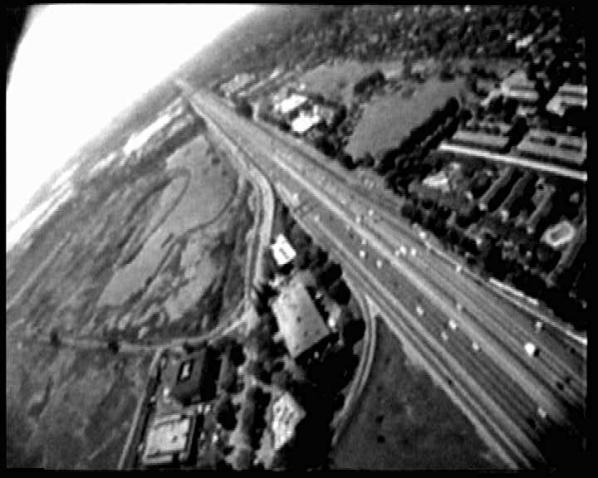
Parallel by Lawrence Bird uses Google Earth to track the 49th parallel, i.e. the prairie border between Canada and the United States. The digital projection invites open interpretations: it is a film about parallel countries; parallel modes of imaging and imagining; parallels between political, technical and visual territories. Obvious digital anomalies in the video, caused by satellite interference, allow for further speculation and imaginative readings.
The Private Life of a Drone by Patrick Lichty is a video travelogue recorded by flying video drones, exploring the area surrounding the Virginia Center for the Creative Arts in Amherst, Virginia (US).
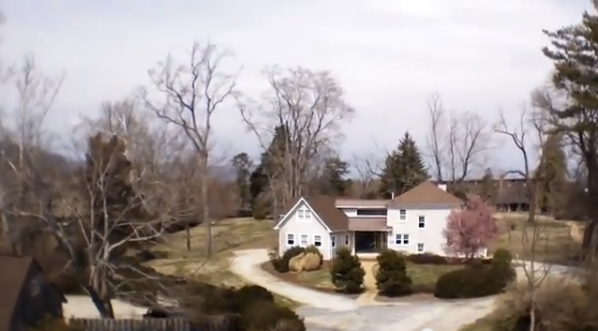
Lines by Dave Miller and Gavin Stewart draws on an emergent cultural interest in drones to explore related issues around privacy, mediation, power, security, morality, legality and others in all aspects of contemporary life. Lines aims to encourage and affect public debate.
TELEWAR is a book and video collaboration between Dave Young and The Force Of Freedom collective. The project tries to make some sense of the uses, effects and developments of the new warfare technologies, like military drones, through the analysis of news reports, military drone culture, drone speak and network theory.
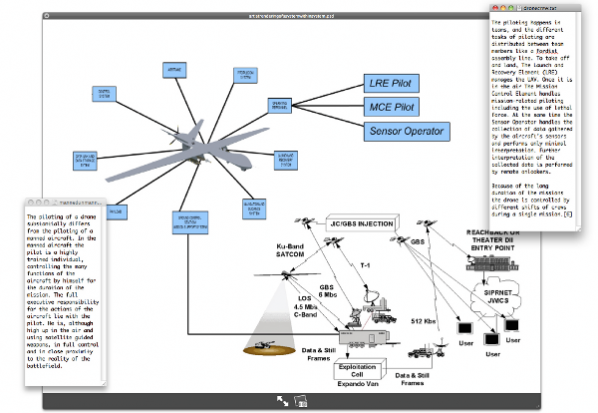
Movable Borders – The Reposition Matrix by Dave Young provides the central installation and information resource of the exhibition.
In a post-national age, where “territorial and political boundaries are increasingly permeable”[2], what has become of the borderline? How is it defined, and what technologies are used to control it?
Movable Borders is an ongoing research project that begins to explore possible answers to these questions through facilitating discussions around the ‘reterritorialisation’ of the borderline in the information age.
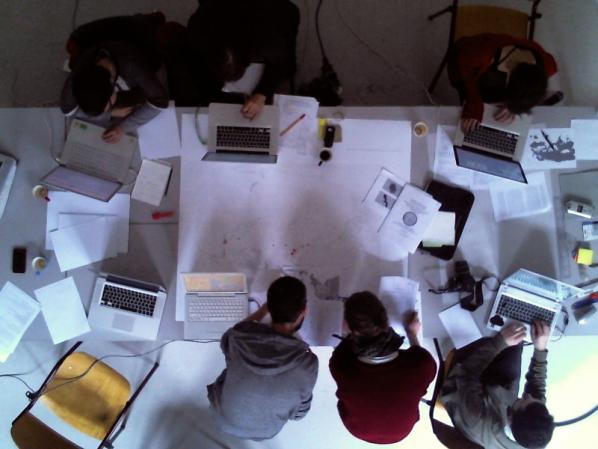
The Reposition Matrix aims to reterritorialise the drone as a physical, industrially-produced technology of war through the creation of an open-access database: a ‘reposition matrix’ that geopolitically situates the organisations, locations, and trading networks that play a role in the production of military drone technologies.
Alongside the installation Dave Young will be holding a workshop on the subject of drones on Saturday 18 May, 1-5pm – BOOKING ESSENTIAL. More info here.
Lawrence Bird
Lawrence Bird is a designer, instructor and writer with an interest in cities and their image. He has trained in architecture (B.Arch), social sciences and urban design (MSc), and history and theory of architecture (PhD). He has recently completed the SSHRC-funded postdoctoral project Beyond the Desert of the Real, based in Winnipeg, Canada. The project focused on desolate urban sites, elicited visual narratives from city residents and graduate students of architecture in response to them, experimented with representations of the city based on these narratives, and used these strategies as points of departure for urban design and urban landscape proposals. Lawrence also makes films, and is currently developing a hybrid film and animation project WPG_POV.
Bureau of Inverse Technology
The Bureau of Inverse Technology (aka BIT) is an organisation of artist-engineers whose stated aim is to be an information agency servicing the “Information Age”. Bureau engineers are involved from design to deployment and documentation of radical products based on commercially available electronic entertainment components such as cameras, radios, networks, robots, sensors, etc. Though its work has long been publicly available, the composition of the Bureau itself is shrouded in some mystery, for some years cloaking its identity in anonymity. In 2004 the Bureau initiated a “retreat from anonymity” when radio journalist and BIT co-founder Kate Rich took up a three month Research Fellowship at Piet Zwart Institute for Media Design Research, Rotterdam in 2004. Current Bureau products include BIT Radio, Feral Robotic Dogs and the Despondency Index.
Patrick Lichty
is a technologically-based conceptual artist, writer, independent curator, animator for the activist group The Yes Men, and Executive Editor of Intelligent Agent Magazine. He began showing technological media art in 1989, and deals with works and writing that explore the social relations between us and media. Venues in which Lichty has been involved with solo and collaborative works include the Whitney & Turin Biennials, Maribor Triennial, Performa Performance Biennial, Ars Electronica, and the International Symposium on the Electronic Arts (ISEA). Patrick also works extensively with virtual worlds, including Second Life, and his work, both solo and with his performance art group Second Front, has been featured in Flash Art, Eikon Milan and ArtNews. He is also an Assistant Professor of Interactive Arts & Media at Columbia College Chicago, and resides in Baton Rouge, LA.
Dave Miller
Dave Miller is a South London based artist and currently a Research Fellow in Augmented Reality at the University of Bedfordshire. Through his art practice Dave draws out the invisible forces that make life difficult. His work is about caring and being angry as an artist. His art enables him to express feelings about the world, to attempt to explain things in a meaningful, yet subjective way, and make complex information accessible. Recurrent themes in his work are: human stories, injustices, contentious issues and campaigning. Recently he has been very bothered by the financial crisis.
Gavin Stewart
Gavin Stewart is Lecturer in Digital Media at the University of Bedfordshire, poet and writer. He is the current convener of the Interactive Media Group. His research interests are the aesthetics of digital texts and the impact of corporate digital media on our understanding of community. Gavin is course leader in BA Media Production and currently teaches units in Media and Cyberculture and Print, Culture and Technology at MA Level. Gavin is is also the co-organiser of the Playful Paradox mini-festival, the End of Journalism conference and the Under the Mask: Perspective on the Gamer conference series.
The Force Of Freedom
The Force Of Freedom is a Rotterdam based collective founded by Micha Prinsen and Roel Roscam Abbing in 2009. In their work they react critically but playfully to new emerging technologies and developments on the internet.
Dave Young
Dave Young is an artist, musician and researcher currently studying the Networked Media course at the Piet Zwart Institute in Rotterdam (NL). His research deals with the Cold War history of networked culture, exploring the emergence of cybernetic theory as an ideology of the information age and the influence of military technologies on popular culture.
Furtherfield Gallery
McKenzie Pavilion, Finsbury Park
London N4 2NQ
T: +44 (0)20 8802 2827
E: info@furtherfield.org
Furtherfield Gallery is supported by Haringey Council and Arts Council England.
Featured image: London Hackspace http://wiki.london.hackspace.org.uk/view/London_Hackspace
…the machine is always social before it is technical.
(Gilles Deleuze)
Though the term ‘lab’ conjures the image of a fairly sanitised environment optimised for scientific experiments and populated by people in white coats, media labs – centres for creative experimentation – are quite different. At their most basic, they are spaces – mostly physical but sometimes also virtual – for sharing technological resources like computers, software and even perhaps highly expensive 3D printers; offering training; and supporting the types of collaborative research that do not easily reside elsewhere. In the early-to-mid-1990s, partly propelled by the exciting possibilities of the internet and associated web browser technologies, groups began to coalesce, bent on developing access to the inherent potential of collective creativity. With the exuberant new dot.com businesses fuelling a ‘creative economy’, the Californian ‘cybercafé’ (surf the internet and slurp the coffee) was emulated in urban centres around the UK and in some cases artists were heavily involved. They saw the internet’s myriad ways of changing the way we make, think about and share art – not to mention its capacity for social empowerment – and wanted to harness these qualities quickly and effectively. With many practitioners coming from the spaces, practices and communities forged by the independent film and video movement, the phenomenon of the UK media lab was born. However, despite the importance of these spaces as the hybrid homes of the then emergent and now embedded creative activities that characterise today’s rich field of digital and media practices, their history and contribution to current lab environments has been little discussed outside a niche arena.
Early Media Labs
Two of the earliest UK media labs were Artec and Backspace (aka Bakspc), both based in London. Artec, which was established in 1990, was initially funded by Islington Council and ESF (the European Social Fund), but soon won additional support from Arts Council England. Conceived by Frank Boyd and Derek Richards, its focus from the outset was to deploy technology for social empowerment and, early on, it provided valuable professional training to the long-term unemployed. In this sense, it did not operate from within an arts context proper, but combined art and technology in the name of social integration. Creative projects were led by Graham Harwood, whose own artistic practice and his collective Mongrel were formed through associations at Artec.
Harwood and Mongrel’s practice is known widely for scrutinising social, political and cultural divisions through a framework of technology. A notable piece from this period was Rehearsal of Memory (1995), which took the collective experiences of staff and patients at Ashworth high security mental hospital, near Liverpool, and presented them as a unified and anonymous computer-based group portrait. Now available as a CD-ROM, the work strongly undermines the assumptions we make about mental health, blurring the line between those branded ‘normal’ or not. It is an excellent example of the way artists and media labs habitually combine creative activities with technology to give people a renewed agency. Around 1995, Peter Ride was brought on board to curate a stream of activity called Channel, which lead to further powerful artworks including Ubiquity (1997) by David Bickerstaff and Susan Collins’ In Conversation (1997).
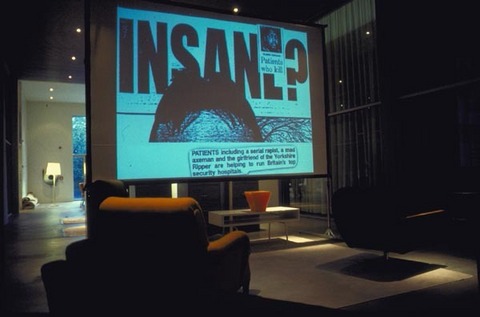
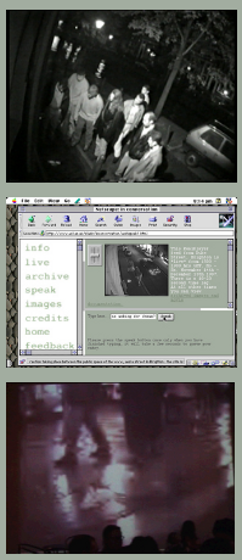
Without regular public funding, Backspace started out as an independent self-organised cybercafé. Initiated by James Stevens as a ‘soft space’ adjunct to his commercial web design business, Obsolete, it had a physical studio and lounge on Clink Street. People could drop in and use the web access and computer terminals in exchange for a nominal membership fee and commitment to maintain the space. What is notable about the Backspace model is how it attempted to foster a co-operatively managed resource. It exemplified a preoccupation amongst internet culture devotees with autonomy and new forms of governance, and struggled with all the contradictions of such ideals alongside the fact of its commercial parent entity. Obsolete shared its (at that time) capacious bandwidth. This gave people web hosting and streaming capabilities that would otherwise have been prohibitively expensive; allowed for the hosting of many artistic projects produced within the space itself; and facilitated many early streaming experiments with link-ups between other European media labs including as E-lab in Riga, Lativa and Ljudmila in Llubljana, Slovenia. Early attendees and co-facilitators of Backspace now list some central figures of the Digital and New Media art fields including: Matt Fuller, Simon Pope, Armin Medosch, Heath Bunting, Ruth Catlow, Pete Gomes, Manu Luksch and Thomson and Craighead – even Turner Prize winner Mark Lecky was a regular for a while.
Globally distributed discussion networks provided a discursive layer for these media labs, with early mailing lists such as Nettime, Rhizome and Syndicate forging international connections around technology, art and politics. Likewise, Mute (at first a newspaper, then a glossy magazine, now a web journal) provided regular critical commentary on burgeoning digital culture.
Foundationally different, Artec and Backspace were united by a belief in the importance of access to tools and training within a social context. In slightly differing ways, they put creative experimentation and social concerns at the centre of the agenda via technology. This was to become an important organisational strategy for this sector. Though both spaces have since closed, Stevens continues to build social and technological infrastructure as Deckspace, at Borough Hall, Greenwich. Without a physical space, Frank Boyd has evolved his media lab system into an industry-orientated programme called Crossover, which assembles creative professionals to workshop cross-platform ‘experiences’ from a variety of creative arenas including film TV and the computer games industry. Crossover is one of many peripatetic media lab models that privilege collaborative creative processes, although it is more goal-orientated than most as participants often pitch to a panel of industry commissioners.
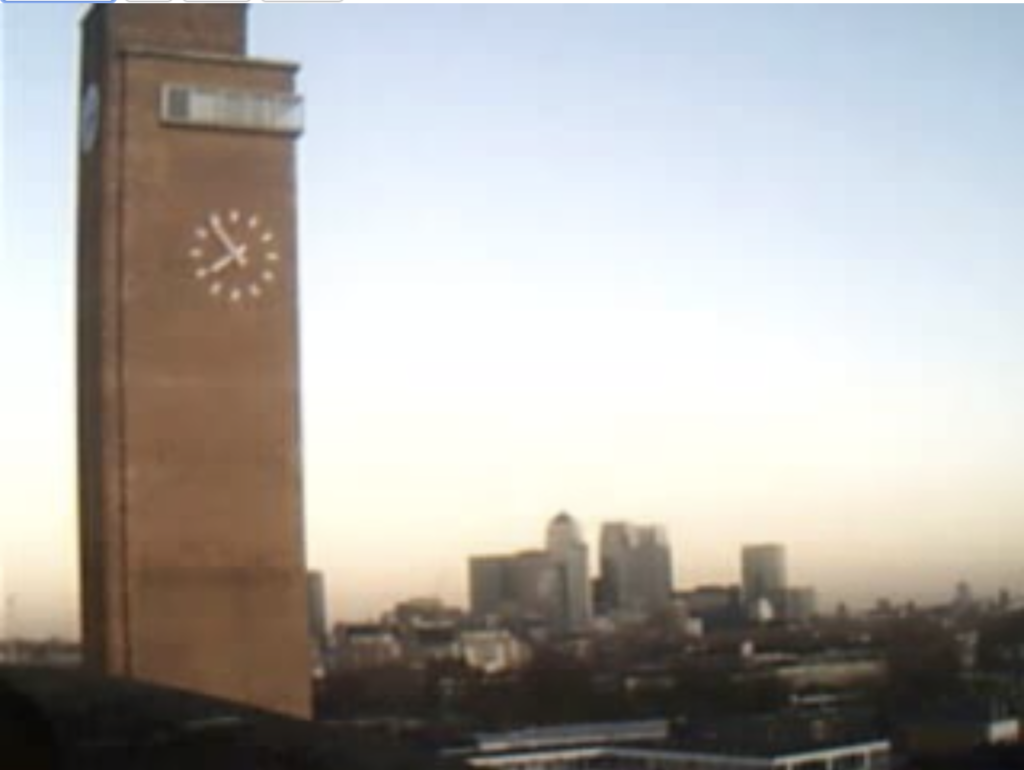
Process over Product
With less of an eye on industry and an abiding interest in the creative process itself, PVA MediaLab was formed in 1997 by artists Simon Poulter and Julie Penfold. In its first incarnation, it took up residence at Dartington College of the Arts, with funding from South West Arts. While there, artists were offered a well-equipped space in which to experiment with technology and develop ideas. In fact it is this developmental freedom that forms another core operational component of the media lab. Rather than asking artists to arrive with pre-formulated projects, or expecting them to see a piece through from start to finish, media labs have consistently placed value on self-determined exploration. PVA helps artists to manufacture methodologies rather than final artworks, fully designed products or content packages. They have also led the way in assisting other media labs to produce a similar system, through their Labculture programme. Highly itinerant, the Labculture model adjusts itself to host organisations, like Vivid, in Birmingham, so they can learn how to set and achieve goals while building the sorts of lasting partnerships that will sustain future activity.
This shared or Open Source way of working integral to media lab culture is also exemplified by GYOML (Grow Your Own Media Lab). A collaborative project between media labs Folly, Access Space and the Polytechnic, GYOML was designed to help generate more media lab initiatives. It has included: ‘GYOML in a Kitchen’, a sound recording and editing workshop by Steve Symons (Lancaster); ‘GYOML in a Van’, which staged an introductory workshop in media-lab culture for community group leaders (Lancaster); a game-centred ‘GYOML for teenagers’ (Rochdale); and ‘GYOML at the Canteen’, catering to film-makers and professional artists with an interest in open source (Barrow-in-Furness). Legacies of this project include the Digital Artists Handbook, an impressive guide to Open Source tools and techniques and ‘Grow Your Own Media Lab (the graphic novel)’, a set of inspiring case studies. Folly continue to work very much in this manner, forming essential infrastructural relationships as and where needed and guiding others through the adoption of free software.
Another example of this attention to operation and openess comes from GIST Lab, in Sheffield, which energises community-based projects through a space that hosts meetings and workshops. Even without a dedicated tech suite, their knowledge-exchange is a short-cut to all manner of original cross-over work, and they have supported yet another project that literally and metaphorically recreates aspects of the media lab model. 3D printing (or rapid prototyping) is increasingly popular in producing anything from car parts to jewellery, by layering materials like plastic into finished three-dimensional objects. RepRap, however, is able to print the spare parts it needs to be built while it is still itself under construction. Just like media labs, this self-replicating 3D Printer is all about sharing access to a successful system.
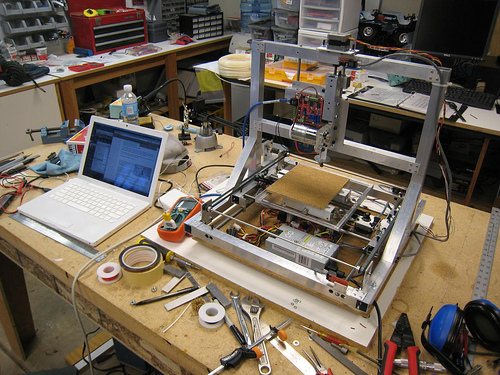
If media labs are not driven by material production, neither are they all about technology. Arising from the work of the art group, Redundant Technology Initiative, Access Space in Sheffield established its media lab through the use of free and recycled technology and learning. Given our cultural predisposition for wanting the latest, fastest equipment and our reprehensible dumping of perfectly serviceable technology, abundant hardware is sourced from all manner of locations. The latest Free and Open Source software is installed on the hardware where expensive proprietary software once lay and the media lab space, complete with this equipment, is opened to the public five days a week. The one proviso placed on this access – continuing the recycling theme – is that once a media lab participant has learnt how to do something, they should pass this knowledge on. As evidence of the success of this system Access Space boasts impressive outreach capacity: more than a thousand regular visitors, of which only about thirty-five percent are university educated, and over half are unemployed, and they habitually work with people experiencing disabilities, learning disorders, poor health, homelessness or other measures of exclusion.

One of the projects that clearly shows what they do is Zero Dollar Laptop, a collaboration with the Furtherfield organisation and community. Through a series of workshops, homeless participants are given the ability to use and maintain a free laptop complete with free software in self-led creative projects. It is this model of learning through self-directed creativity that arises again and again in media labs because it provides demonstrable results in helping people acquire and retain the skills they need. Without ‘bells and whistles’ new technology, Access Space emphasise the importance of ideas over technology and demystify all manner of computer-based skills. SPACE Studio’s MediaLab is also an excellent example of a lab working at a range of levels to offer beneficial specialised training. They teach software packages at a professional level to film makers, artists and a range of media industry workers, as well as offering film-making and media training for NEET (Not in Education, Employment or Training) teenagers in the local area. There are also a number of DIY Technology workshops including those regularly hosted by MzTEK who have expanded their operation as a result of their connections with SPACE. MzTEK are all about encouraging women to build technical skills and enter the new media sector. Growing from a small group to wide and supportive network they answer underdeveloped areas of knowledge. In addition to this, SPACE’s PERMACULTURES residency series has, to date, hosted eight residencies supporting over eleven artists, helping them explore technology and go on to show in a range of spaces.


The media lab also plugs an important gap in the art gallery and museum network. Digital and New Media arts are distinctive for collapsing boundaries between the place of production and exhibition. As a result, few existing art spaces have been in a position to fully represent it. Media labs, as well as community websites like Furtherfield and Rhizome, international festivals including ISEA and Transmediale and curatorial resources like CRUMB (the Curatorial Resource for Upstart Media Bliss) have imaginatively responded to this situation. Media labs in particular have been very successful in fostering relationships between artists and galleries. They have helped to translate not only the ideas expressed by this type of art – which can require much additional contextualisation – but also their physical installation in spaces not designed for this new breed of work.
For example, Folly recently collaborated on an experiment in the exhibition and acquisition of New Media art with the Harris Museum and Art Gallery. Entitled Current, the project saw expert panels first select works to be exhibited at the gallery (in Spring 2011) and then choose one to enter the permanent collection. Not only did this give the gallery the chance to add a timely contemporary work to their collection but it formed a useful public case study showing other institutions how they might engage with emergent art forms in various new media.
Media labs greatly contribute to the collaborative working methods the creative sector now thrives upon. Cross or interdisciplinary partnerships involve people from very different industries or working cultures combining and even reinventing the way they work in order to unearth all manner of new practices and products. Many universities, having born witness to a boom in research which straddles different academic subjects and industry sectors (due in some part to government funding imperatives around ‘knowledge transfer’), have established their own media labs. A relatively early example of this was i-DAT (the Institute of Digital Art and Technology) at the School of Computing, Communication and Electronics at the University of Plymouth. A large project with many interrelated strands is their op-sys (operating systems) network of research into architectural, biological, social and economic data and how it can be made publicly available and useful. The University of Nottingham has the Mixed Reality Lab, which was established in 1999 with £1.2 million in funding from the JREI (Joint Research and Equipment Initiative) programme as well as ongoing grants and investments. Run by Steve Benford, it hosts around eighteen PhD students providing resources for researchers and post-graduates working in areas that intersect its host department, the School of Computer Science, and associated training facility, the Horizon Doctoral Training Centre. It maintains a number of diverse projects, some of which have won prestigious awards and award nominations including Can You See Me Now, a collaboration with Blast Theory. The CoDE (Cultures of the Digital Economy) Institute at Anglia Ruskin University in Cambridge has a digital performance laboratory that focuses on sound-based work. Culture Lab is Newcastle University’s bespoke unit of media-lab-style flexibility, where artists work experimentally and across disciplines, and Sandbox, a similar resource, is located at the University of Central Lancashire. Another approach for universities is to partner with existing media labs. Pervasive Media Studio, a Bristol-located media lab, was set up by Watershed, a cross-artform production organisation, HP Labs and the South West Regional Development Agency. They have a partnership which runs for three years with the University of West England’s Digital Cultures Research Centre and work in a number of different ways including offering Graduate and New Talent residencies for those just starting out in their careers. The Pervasive Media Studio has helped to establish events like Igfest, the Interesting Games festival, held annually in Bristol, as well as development platforms such as Theatre Sandbox, which helps theatre makers introduce technology to their practice. They also support artists, including: AntiVJ, Duncan Speakman and Luke Jerram.
As we have seen, some labs have been nomadic or temporary while others have evolved into new incarnations. A media lab might be part of an array of dependencies with institutional responsibilities i.e. Folly, Isis Arts, Lighthouse, Pavilion, Pervasive Media Lab, PVA, Vivid and more, all of which regularly produce an abundance of quality experimentation in Digital art and culture. While new incarnations of the media lab may respond to three distinct but related phenomena: the rapidly evolving technology sector; the transient networks of geeks and digital experimenters; the need for sustainable models for innovation in industry. MadLab, in Manchester, provides space and facilitates meetings and workshops for ‘geeks, artists, designers, illustrators, hackers, tinkerers, innovators and idle dreamers’. Their ‘drop in’ events, commonly known as ‘Hacklabs’ (for example *Hack to the Future* during the Edinburgh International Science Festival), give people instant hands-on experience with all sorts of code and kit. Although hacking is still seen as a specialist and somewhat murky activity, the term is being increasingly decoupled from its conventional criminal associations and made accessible to mainstream arts territory. In January 2011 the Royal Opera House facilitated a ‘Culture Hack Day’, bringing cultural organisations such as the Crafts Council and UK Film Council together with software developers and creative technologists to usefully open up and share data. Other HackLabs may have less of an arts focus, but do have impressive resources built using the open membership model (pioneered by the likes of Backspace). The London Hackspace boasts a laser cutter, digital oscilloscope and kiln, all donated or collectively purchased.
Scattered through many of our city centres are office/studio-based working spaces which cater to the creative industries by offering flexible working environments and abundant networking and training opportunities. The Hub, in London’s Islington and Kings Cross areas (with up to thirty further Hubs in cities across the globe), gives fee-paying members access to facilities and a way of working orientated towards connecting people from across the network in cost-effective innovation. These spaces are indicative of the emphasis placed on the creative economy as the big hope for economic renewal driven by small entrepreneurs grabbing and shaping the opportunities in technology, entertainment and design.
Inspirational before Institutional
Looking briefly at some of the ways media labs have operated since the 1990s shows them as uniquely fertile spaces for all manner of shared expertise and creative innovation. They have made a fundamental contribution to Open Source culture. Working as openly and collaboratively as possible, participants have found ways of sharing process and product, while an interdisciplinary nature has revealed a plethora of creative possibilities. Fulfilling a difficult remit by offering a home for many of the emergent artistic practices currently transforming artistic activity, they have led us away from ‘art for art’s sake’ and towards work which has demonstrable meaning and lasting social and economic benefit. Large institutions might be extremely well-versed in mounting financially advantageous blockbuster exhibitions, but the beauty of media labs derives from their ability to develop and disseminate the socially-transformative systems that have already and will continue to shape the future of the arts.
A big thank you to everyone who contributed to this research despite their incredibly busy schedules and a special shout to: Simon Poulter for pulling over his car, Clive Gillman for kindly kicking things off, Sarah Cook for an innovative approach to note sharing and Peter Ride for not taking a lunch break.
You can find Charlotte’s original article on Collaboration and Freedom – The World of Free and Open Source Art http://p2pfoundation.net/World_of_Free_and_Open_Source_Art
As part of the Furtherfield collection commissioned by Arts Council England for Thinking Digital. 2011
This conversation follows in a series of interviews with women who work at the intersection of art and technology. Amy Alexander’s work as an artist, performer, musician, and professorapproaches art and technology from a performing arts perspective, often examining intersections of art and popular culture.
Amy Alexander is an artist and researcher working in audiovisual performance and digital media art. She has worked under a number of pseudonyms including VJ Übergeek and Cue P. Doll. Coming from a background in film and music, she learned programming and began making time and process-based art on the Internet in the mid-1990’s with the Multi-Cultural Recycler and plagiarist.org. Amy has performed and exhibited on the Internet, in clubs and on the street as well as in festivals and museums. Her work has appeared at venues ranging from the Whitney Museum and Ars Electronica to Minneapolis‚ First Avenue nightclub. She has written and lectured on software art and audiovisual performance, and she has served as a reviewer for festivals and commissions for new media art and computer music. She is an Associate Professor of Visual Arts at the University of California, San Diego. During summer/fall of 2012, Amy is Artist-in-residence at iotaCenter in Los Angeles.
Rachel Beth Egenhoefer: You’ve taken on many roles as an artist, musician, performer, coder, organizer, professor. How would you explain what you do to the “average Joe” who has not idea what a code artist is?
Amy Alexander: I usually don’t try to explain to people what a code artist is. I generally just tell them about the types of projects I or my students do, (“museum installation,” “club performance,” etc.) and what some of them are about. Then I explain that it’s done by writing software, building electronics, making videos, etc. But the point is more about the projects, not about how specifically they are made.
I also think talking about code-as-art is both less necessary and less difficult than it was five or ten years ago. What motivated me and a lot of other code artists back then was a concern that algorithms had a cultural impact that wasn’t well-recognized. Nowadays, people are familiar with the idea that Google sorts your search results in a particular way, websites you visit develop demographic profiles of you, etc. – they’re already concerned about algorithms. So I think it frees up both artists and audiences to focus on other aspects of the work. Of course, there are definitely some situations in which focusing on algorithms-as-art is important. Just like photographers sometimes focus on the nature of photographs, video artists on video, etc.
RBE: You’ve worked as yourself, as well as other performers such as Cue P. Doll and Übergeek. Can you describe the differences between some of your characters, and how do you see identity as a key element in your body of work?
AA: Some of the online characters just evolved. I tend to anthropomorphize things, and I like to break into characters; I’ve just always done those things. So in some cases when I’m developing a project from a particular perspective, a character emerges who personifies that perspective. For example, The Original Plagiarist.org (1998) website was a collection of projects in which grandiose attempts to opportunistically plagiarize from the Internet always turned out to be transparent. So the character of Plagiarist emerged as the proud proprietor of this site and creator of all its projects – and the only person who couldn’t see the futility of the plagiarisms.
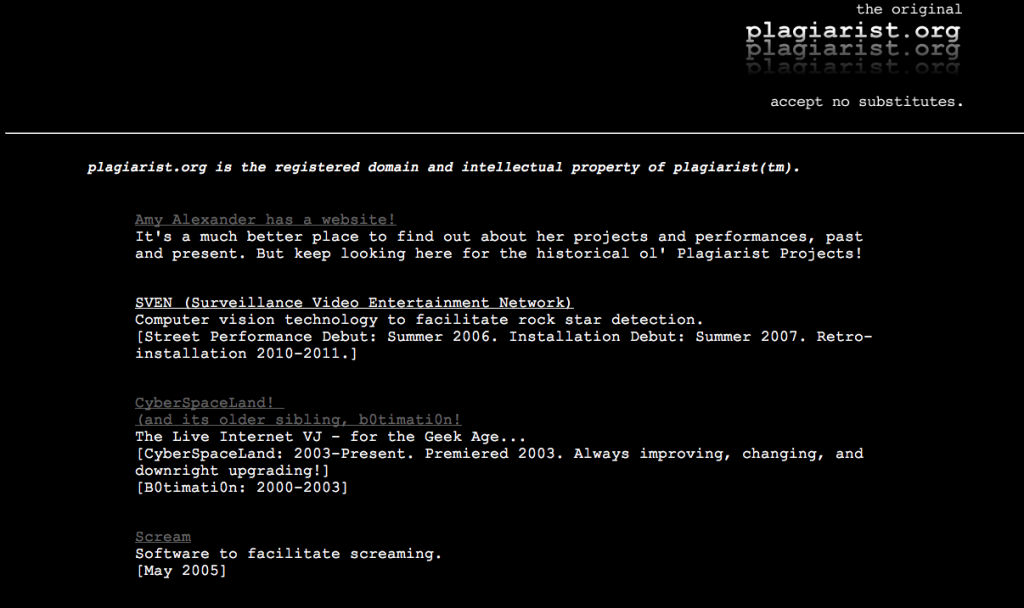
Übergeek is different, since I physically go out and perform as her. She’s both a theatrical character and actual club performer – in varying proportions depending on the context of the show. The theatrical character is a geeky rockstar wannabe. That opens up space for Übergeek to exaggeratedly escape the physical restrictions of performing on a computer – by waving around an “air mouse,” dancing on a DDR pad, etc. The club performer comes from my growing up performing music. I’d never thought about it, but the zone musicians go into to perform is really like playing a character. You have to become someone else. A few years ago I heard Steve Schick explain that when he has to perform a difficult piece of music, he imagines he’s someone else – and that other guy can play the piece. Eventually I realized that any performance of any kind I’d done that I’d been remotely satisfied with, whether music, VJ show, or performance art – I’d mentally become some other person. Going into character is really important, even if the character is just, “the performer.” It can be easy to forget the crossovers between performing arts and visual arts, but there’s a lot we can learn from one another.
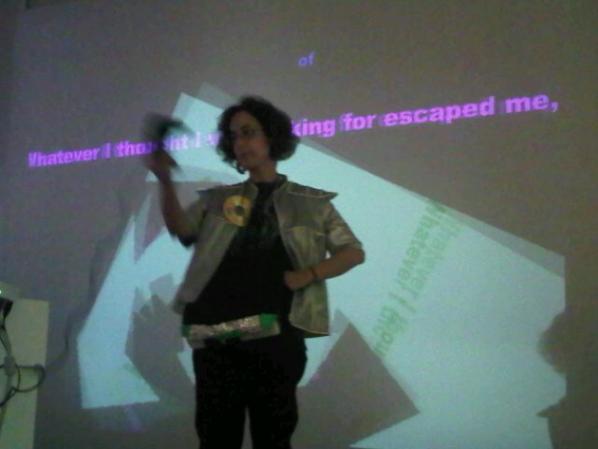
RBE: Do you think this happens to us when we interact online, that we become performers? (Some people believe for instance that Facebook is really a performance of ourselves, not our real selves) Do you see any intersections of performance in “online” vs “physical/ in person” interactions? (I realize this gets into an entirely different question, the idea of intentional performance and unintentional, but perhaps you see an overlap?)
AA: I think there’s an overlap, but there’s also an overlap between the kind of “performances” we do online and those we do in “real life.” I don’t buy the dichotomy that the physical world is real/true and the online world is fake. We perform different sides of ourselves in different real life situations – work, friends, family, large group, small group, etc. Sometimes we perform more consciously than others. On the other hand, sometimes we feel less inhibited in online interactions, so we behave more naturally.
That’s not to say there’s no difference between online and offline interactions – but then again, these differences didn’t just suddenly emerge when the Internet came along. Think back to when people sometimes had pen pals by snail mail, for example. The relationships could be friendly, intimate, or performative. When things like immediacy and nonverbal communication disappear, that invites a different kind of behavior – be it more natural, more performative, or a combination.
RBE: What connections do you see between identity, code, and performance?
AA: I guess I’ve responded to identity & performance in the question above. As for code & performance: people have pointed out that code parallels musical notation, in that both are executable languages. If you think about scores by people like John Cage, where scores could actually be diagrams or verbal instructions to the performers, the connection between performance and instruction set becomes even clearer. This is interesting historically and theoretically, but for many of us who use code in performance, the connection becomes self-evident in practice. Code launches processes and actions, and performance *is* processes and actions, and there’s a back and forth between the performer and software. It’s not that much different for me performing software than performing a musical instrument; if I play violin, I finger, bow, pluck in various ways to get various sounds. You can think of the violin as interface, the notes and gestures as parameters, or whatever. But to be honest, trying to create precise analogies is a recipe for disaster. The point is, you perform both of them, and you have to learn how to do it. The difference with software is, you build your own instrument; that’s both a blessing and a curse. So you try to balance playability with flexibility, and so on. Because of my experience playing music, I keep trying to build ones that will accommodate clumsy performers like me!
RBE: Do you see all code as being “performed”? (Or perhaps is saying code is executable the same as saying code is performed?)
AA: It depends on which sense of the word “performed” you’re using. In the sense that means to do some sort of process – like to perform your job duties – yes. You can think of data as nouns and algorithms as action verbs. You “run” code, and though the physical metaphor might be an exaggeration, in general, some sort of an action happens. So in that sense, the processor is performing the code.
But in the other sense of the word – intentional performance, performing arts, performance art, etc. – running code is innately no more of a performance than breathing. People like John Cage have made interesting performances out of breathing, and people like Alex McLean have made interesting performances out of running code. But it’s not that way on its own, except in the Cagean sense of it being performance if you think of it that way. I think that’s interesting, but I’m personally more interested in code’s cultural, rather than formal, implications. In other words, I’m not so excited that processes are dynamic and self-repeating for their own sake. I’m more interested if, for example, that means we have increasing difficulty finding unpopular or obscure information online, because the popular perspectives have formed an algorithmic echo chamber.

RBE: Your newest work is using audiovisuals, performance, solar energy, and the history of dance in cinema. How did you arrive at this combination of ideas?
AA: The project is Discotrope: The Secret Nightlife of Solar Cells. It’s an audiovisual performance – a collaboration with Annina Rüst, with algorithmic sound design by Cristyn Magnus. There’s really two parts to the project: the projection system, and the content and performances that we develop for it. The system is a disco ball where some of the mirrors have been replaced by solar cells. The cells power the motor that turns the ball. We project video onto the ball instead of colored light. The result is, reflected, fragmented video images move around the room. Since the video projections “solar”-power the ball, the speed at which the images move around the room varies with the brightness of the images.
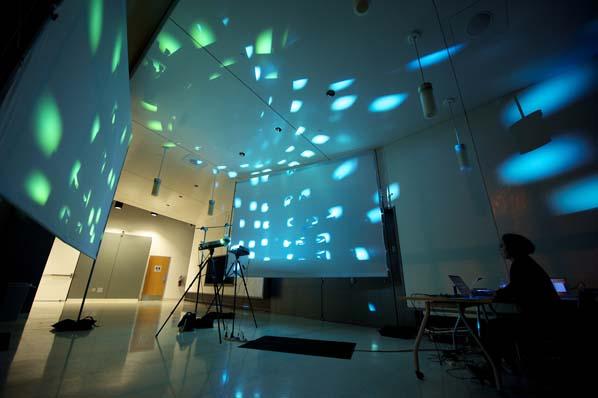
The way this all came about was I’d been interested in the philosophy behind hybrid cars and various other things – that when we “waste” energy, we might actually be creating it. I kept wondering if this idea could be applied to media somehow, and I kept trying various experiments with video: could the talking heads on cable news power an LED? etc. Never quite found the right outlet for this idea, though. At some point, Annina and I came across a disco ball, and we noticed the similarity between its mirrors and small solar cells. Then the idea of projecting videos onto it hit us, and it all came together as a “media-powered” system. Of course, that was just the general idea. After Annina built the initial prototype of ball, it took many hours working with it the studio for the “instrument” to reveal itself – i.e. how exactly does a video-powered disco ball become useful visually and performatively? Figuring that part out was just elbow grease – but getting from rough idea to what-is-this-really always is for me; I have to get my hands on things and play with them.
The content framework we’re working with for at least our initial round of performances is “the history of dancing ‘at’ cameras.” Since it’s a disco ball, we envisioned performing it at community dance parties, etc., and so people dancing seemed like the obvious thing to project. We started from the idea of projecting the people at the party onto it live – but we realized we also wanted to expand beyond that. Again, the elbow grease process: I’d try different clips of people dancing on YouTube, old movies, TV shows. Eventually a connection emerged between early cinema clips and contemporary YouTube clips. In both cases, people dance pretty much like vaudeville performers, directly for the audience – as opposed to cinematic narrative style, in which the viewer is a fly on the wall. In the dancing “at” cameras style, there’s a more direct, intimate connection between dancer and audience. We’ve written some things about this on the Discotrope blog – and I’ll probably write more there soon. Another thing we became interested in is how representation (gender, physical, etc.) does and doesn’t change from early movie camera demos and Hollywood films to YouTube, where people are generally self-cast and self-directed. And I’m really interested in the relationship between all of this and the muddy space between exhibitionism, voyeurism, and surveillance. That’s a theme that’s run through a number of my projects, and dancing at cameras certainly exemplifies that murkiness.
Of course, a lot of the dancing at cameras perspective relates to film history in general – cinema’s origins in theatre and vaudeville, the development of montage, etc. So it’s interesting to see it return with YouTube. Teresa Rizzo has written a really interesting article related to this called, YouTube: The New Cinema of Attractions.
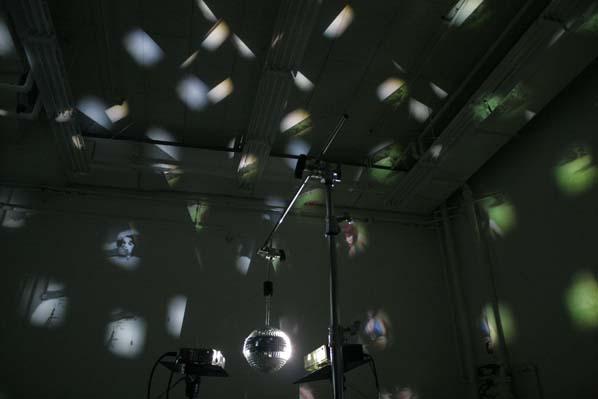
RBE: When you say “people dancing at cameras” I immediately thought of surveillance cameras. Is your disco ball a type of surveillance camera?
AA: I’m really interested in the blurring between surveillance, exhibitionism, and voyeurism. The Multi-Cultural Recycler, SVEN, and CyberSpaceLand all hit on that theme in one way or another; this time it’s cinematic dancers. The cinema/YouTube performers who appear in Discotrope all knew they were on camera, so overtly it’s more about exhibitionism and voyeurism. Glamorous 1950’s female burlesque dancers did their strip tease acts for the camera; sixty years later, not-so-glamorous scantily-clad men proudly stomped through the Single Ladies dance on YouTube. One group does work-for-hire within the Hollywood studio system; the other does what they want. Does that make one voyeurism and the other exhibitionism, or is it more complicated than that? in some cases, we see the performers much differently than they probably saw themselves. Does that make it surveillance? I think it’s all very muddy, and that’s what I find interesting.
The flip side is that there are people in some of Discotrope’s YouTube videos doing things like dancing in Walmart, which gives the video a surveillance camera look even though it’s obviously not surveillance (in the traditional sense, at least.) People turn the tables on surveillance video and make their own production numbers in surveilled/controlled areas – for fun and as a type of resistance. That’s one of my favorite parts of Discotrope. Then we get to recreate those Walmart spaces in the big Discotrope projection. It makes it even more like an old Hollywood production number, and it makes it weirdly immersive. This is fun for us, because Walmarts are not the kind of thing normal people like to recreate immersively. 🙂
RBE: For this piece you are creating something for other people to perform with. Are there any differences for you in creating work that you will perform vs. others performing?
AA: Ah, those pesky multiple senses of “performance” again!. 🙂 I do the visual performances for Discotrope, so for now I’m primarily building the software system for myself to perform. So far Annina is the only other person who performs with the software. Like anything, it’d require some tweaking to be distributed for more general use, though I’ve tried to make it not too terrible in that regard. 🙂 More challenging/interesting might be for performers to get the feel for moving the ball – like anything, it takes practice to get proficient.
But perhaps you’re talking about performers in terms of the audience who can dance to Discotrope, or the parts of the show where audience members can dance on camera interactively. In this case, they’re both performer and audience at the same time. That’s an interesting challenge, because in designing the show, we have to think about them in both ways.
RBE: You are starting a residency at the iotaCenter in Los Angeles, what will you be working on there?
AA: It’ll be mainly exploratory/preliminary research; things will likely be changing/developing as I go along. But my general plan is to explore two threads: gestural and spatial cinematic performance. In performing CyberSpaceLand over the years, I found myself unconsciously developing certain gestural/structural performance techniques that were much different than what I’d consciously designed for the piece. That spawned some ideas about gesture, time and space that I’m going to try to take further. The spatial thread grew out of some things we’ve played with in Discotrope in terms of deconstructing cinematic narrative in a 360 degree space. I’ll be exploring these spatial cinema ideas both in regards to Discotrope and as broader research.
iotaCenter’s a great place for doing research in abstract / formal and experimental cinema, visual performance history, etc. They’ve got a terrific collection of films and texts. I’m hoping to also use the opportunity to get together with other experimental cinema and visual performance folks in LA. It’d be great to organize some fun/intellectually-stimulating/breathtakingly-earthshattering screening/performance events.
RBE: This interview is going to be part of a series of interviews with women working in art and technology. What do you consider to be important today about being a woman working in art & technology? Do you think it is still useful to discuss the female voice as a separate voice in the field?
AA: It’s a tricky subject, because we both need to hear women’s voices and avoid tokenizing or homogenizing them. Women artists working with technology do tend to have different perspectives than men, and there are far fewer of us. So often when the dominant themes emerge, they tend to be the “masculine” themes by virtue of sheer numbers. A corollary is that often women artists feel pressured to focus on gender issues or certain types of social issues. Again, it’s a problem of critical mass and self-perpetuating themes. Since a fair number of women are already involved with those topics and many women’s interests overlap there, they have momentum. But this ends up discouraging women from discussing or doing work on other topics they’re interested in, So, while we need to talk about shared experiences among women in art and technology, we also need to recognize that they have a diverse range of work and perspectives.
RBE: How have you seen perceptions of gender change through the years either in teaching, performing, or working as an artist?
AA: It’s interesting to think that the first programmers were women, and that at the time it was considered clerical work. (See Researcher reveals how “Computer Geeks” replaced “Computer Girls” by Brenda Frink.)
As men started to fill programming jobs, the perception of programming shifted. It became something “technical” that was somehow inherently “man’s work,” even though it had been clerical “women’s work” only a few decades earlier. I’ve seen something similar happen as a female computing artist. I think there are more of us now – at least we don’t seem to be the novelty we were ten or fifteen years ago. And I’ve seen a shift in attitudes and perception among undergraduate computing arts students: by now both the men and women have grown up playing video games and doing a variety of Internet activities that might have seemed like “boys-with-toys” pastimes a decade ago. So their perceptions of what they’re learning to do as computer artists is a little more open and less gendered. But unfortunately, there are still circular perceptions in all age groups that whatever technical work women are doing can’t be too serious by virtue of the fact that a woman did it. It would seem to parallel the current political debate in the US about the pay gap between women and men. There are always arguments that women’s jobs aren’t as demanding, and they usually end up with someone saying, “I can’t believe we’re still talking about this in 2012!” So on one hand, the more things change, the more they stay the same. On the other hand, as more women computing artists emerge, we’ll hopefully soon achieve sufficient critical mass for world domination. Don’t say I didn’t warn you.
This conversation follows in a series of interviews with women who work at the intersection of art and technology. As someone who works as an artist, curator, organizer, professor, researcher, and board member Sue Gollifer embodies this intersection across many venues.
Sue Gollifer has been a professional artist and printmaker for more than thirty years, Gollifer has exhibited her work worldwide and been collected by major international public institutions. A pioneer of early computer art, she has continuously explored the relationship between technology and the arts and has written extensively on this subject. Gollifer is a Principal Lecturer in Fine Arts and the University of Brighton where she is also the Course Leader of the MA Digital Arts Program. She has been instrumental in shaping major international arts communities including: the Design and Artists Copyright Society (DACS), the Computer Arts Society (CAS), and the College Arts Association, (CAA), ISEA, SIGGRAPH, Lighthouse Brighton, and many others. Gollifer is currently also the Director of the ISEA International Headquarters.
Rachel Beth Egenhoefer: Given the many hats you wear as an artist, curator, organizer, professor, many people describe you as many things… how do you describe yourself?
Sue Gollifer: I am an artist.
RBE: But you do other things too?
SG: I know I do. At the moment I’m more of a curator and an organizer, but at the end of the day I am still an artist.
RBE: How do you define your role as an artist in relation to being on the many board of directors you are on (such as ISEA, CAA, DACS, and others)?
SG: I’m not a theorist or in a senior management position but I think that these organizations need people who have a broad sense of the discipline to be on their boards to make sure that people like me and people like you have a voice.
RBE: So you see yourself as representing artists?
SG: Yeah, and I think the fact that I have a European background gives me a broader image as well. When I think about being on the board of some local organizations like Lighthouse or Phoenix in Brighton they value that I’m also part of an International network such as CAA and SIGGRAPH and ISEA. It’s quite reciprocal too. The bigger organizations value my spectrum.
RBE: What do you learn as an artist from doing all these other organizational things?
SG: I think what it does is it starts me making work. It’s like any of those things. But I think it started off when I was a consultant to Higher Education in the UK and I just got used to facilitating and networking and telling people about things. And I realized I was really quite good at that.
RBE: Networking?
SG: Yeah. But not just networking. I organize a lot of mailing lists, where I act as a kind of filter for people, letting them know about events and festivals, and ideas that are going on.
RBE: So given that you work in all of these roles, as an artist, as an organizer, as a filter, what changes have you seen over the years of working in these fields?
SG: Well, technologies have changed our lives with the Internet and mobile phones. You know I travel a lot, but half the time people don’t know that I’m not really there, because I still do what I’m doing somewhere else. Where you are doesn’t really matter. You still kind of function, which has its good points and its bad points really, cause you’re always on call.
RBE: What about changes in content or questions that people are asking? Either in art practice or education or conferences and festivals, have there been any changes?
SG: I think the reason why ISEA is successful is because, although we all have our distributed networks and we’re always in constant touch, I think the act of physically bringing people together is really important. But I do think also that a lot of the organizational things like content management systems and the ways that you hear about various festivals and things is made so much easier. At the same time there are so many of them. It’s really important with my ISEA hat on that I’m thinking about the “un-conference” and that you don’t get stuck in a rut. There is a changing landscape and environment and you need to keep up with that.
But with my educator’s hat on, thinking about PhDs and research papers, there’s a lot more to do with money and research and getting money from science backgrounds now. But the idea of research gets lost. What they value is that people are writing about stuff, they’re not actually doing it, but writing about it, using research as evidence.
RBE: What is the role of research in art?
SG: I don’t know. What do you think? Do you think it’s the work? Do you think it’s making the work?
RBE: Well, I think research can inform the work, and work can inform research. But I think the point you brought up about research and the sciences and the value of it, it seems like it can become problematic when it is seen as a moneymaker. Or when the purpose of it is to get money and not the purpose being to inform the work.
SG: Yeah, I was involved in a science project and there was a lot of money in it and they obviously valued the significance of the artists being in there but really you have to fit your research around the money rather than the other way around. It just got out of sink.
RBE: Does that map at all on to how conferences and festivals are set up? Does the work dictate what will be at the event, or does the event dictate what will be made by artists?
SG: Well, to get back to the research thing. Research as evidence of something, even if you are putting work in an exhibition or putting work in a paper or something, you still need evidence.
RBE: But as far as themes or content, how is that dictated? For example the upcoming ISEA is all about “Machine Wilderness”. Was that a result of artists making a lot of work in that realm and we should have a festival about it, or do you think that it was a decision to have a festival about this and encourage artists to think and make work like this?
SG: Well when people put in a bid to host ISEA, they put in what they think the nature of what ISEA will be about. Obviously when we look at proposals we look at not only the relevance but also the integrity of the people delivering it. “Machine Wilderness” in this case is very much around the themes that Andrea Poli is interested in. The theme of ISEA in Istanbul was “Contained/ Uncontained” which was similar but also a bit broader.
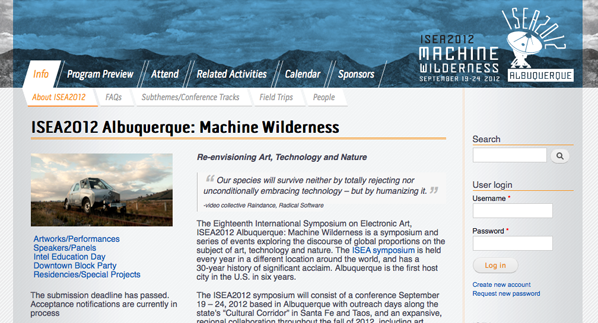
RBE: How do you see the differences in cultures influencing different ISEA’s? ISEA purposely has the festival in different cities around the world, how does that influence the work or the field or what people are thinking and doing?
SG: Well if you take the case of the ISEA in RUHR, Germany, it was to do with the Creative Industries, and creating awareness of new industries. You know we come in and inform people about new things. There’s the idea that we can change things. Or bring things to a city in a way of education and outreach. It shouldn’t be just us sitting in a dark room talking to each other.
RBE: So you see it as a way to bring new media awareness to these different cities?
SG: Yeah.
RBE: But then what do the artists and participants get in return? Or what does ISEA get in return?
SG: You get to travel and meet people! I think you get a different perspective.
We did have two bids coming through for ISEA2014 from Zayed University, Dubai, UAE and Simon Fraser University, Vancouver, BC. Recently the ISEA Board agreed that the Dubai bid, with its focus on the burgeoning field of art and technology in the Arab World would provide a unique opportunity for ISEA to connect audiences and artists from the Middle East with the international electronic art community.
A strong aspect of the bid was the focus on women’s education and ensuring that young women have the potential to influence the future of the region and develop international contacts.
I hope that ISEA can leave a legacy somewhere. I mean otherwise we might as well just have it over Skype calls. The overarching theme of ISEA2014 ‘Location’ will explore strands such as Technology; Science & Art East Meets West; Emerging Economies/Emerging Identities; Nomadic Shifts and Digital Archaeology and Collaborative Spaces.
RBE: This interview is part of a series of interviews with women using art and technology. What do you think is important in having a female voice in today’s art world?
SG: I talk to my students about my role and my job and things like that, and my female students think that it’s really great that I run a digital arts course. If I were a man it would be very very different. I think it’s equally important that students aren’t just taught by women, but women of all ages, those that are married, not married, children, no children. I think we do have to establish role models to a certain extent.
I was a feminist in the 60s and 70s but I never thought that we should be different. I just wanted to be accepted for who I was really. That might be a bit anti-feminist, but I always fought for women for education and opportunities. This goes back to the Dubai thing to a certain extent, the university there started off because one of the princesses wanted to learn about art but there was no place to do so. So it started and went on to have a validated degree. And maybe one day it will have a masters program and women can apply for scholarships and travel abroad?
RBE: Do you think it’s important to have “Women Art & Technology” as a separate category? Or should it just be “Art & Technology”?
SG: Art and Technology.
RBE: Aside from being a female role model for your students and talking about the female voice, what else do you think is important for your students to know right now or learn right now?
SG: Code! (laughs) But I don’t like to think we’re bringing them up differently?
RBE: Or even taking gender out of it, what do young people need to know?
SG: They need to be aware of things. But it depends on what they are trying to do and what direction they want to go in… A big thing is confidence. A lot of my women students do lack confidence.
RBE: Why do you think that is?
SG: I don’t know what it is.
RBE: So what do you do to boost their confidence?
SG: I give them a voice. I give them a space and an opportunity in the class.
When I used to do interviews for undergrad programs in Printmaking, it always started off that the women had better grades, better portfolios, better skills, but at some point it switches. And they loose that confidence and that voice. I don’t know what it is really.
Do you find that?
RBE: The program I teach in has a majority female students. I think that it might be easier for them. I do wonder though sometimes if they are more confident when they are in a classroom with me verses one of my male colleagues or just a different background. But I think there’s also the other end of the spectrum where they are overly confident because they are growing up in this world where you have to be liked constantly on Facebook. You know, like me, like my image, like me, like me, like me… They need to be constantly validated and that spirals into “I’m amazing”. But those aren’t the ones who are asking the tougher questions; those are the ones who want to be liked.
SG: There’s another aspect. Maybe not about confidence, but I think there’s a smoke and mirrors element. There are some men that seem to have all the jargon without actually any credibility. And the women I know with credibility don’t necessarily tell everyone that they do it.
RBE: There are actually studies about that, and how male and female brains are wired differently to behave differently.
SG: I think they address issues in a different way.
RBE: What are you working on now?
SG: Alan Turing!
RBE: What is your role in the Turing Project?
SG: I’m putting together with Anna Dumitriu the exhibition ‘Intuition and Ingenuity’, a group exhibition that explores the enduring influence of Alan Turing – the father of modern computing – on art and contemporary culture. 2012 will be the 100th anniversary of the birth of Alan Turing, one of the greatest minds Britain has produced; the world today would have been a very different place without his ideas.
I’m also curating a projected drawing Exhibition for the Drawing Research Network (DRN) conference in Loughborough in September.
I have also just been part of selection partnership for two newly commissioned pieces of work for Brighton Festival, ‘Sea of Voices’, and ‘Voices of the SEA’. Plus reviewing work for SIGGRAPH art gallery 2012 and for ISEA2012, and papers for the journal ‘Digital Creativity’, of which I am assistant editor.
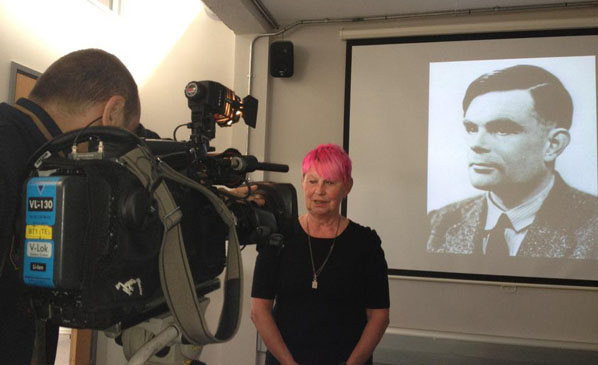
RBE: What excites you about the future?
SG: I don’t know really. I hate to get gloomy about the future, but I do think it’s going to get worse. I mean you live in San Francisco and I live in Brighton so I don’t think it’s hit us quite yet, but I am starting to notice a lot of shops closing. And I know that things I took for granted like buying a house, having children and having a job, I don’t think they have these choices anymore.
RBE: How do you think this will impact the art community?
SG: There are surprisingly good opportunities for the use of vacant shops and offices for exhibition spaces and studios and surprisingly people buy art because they think it’s an investment for the future.
RBE: Do you have anything else you want to tell the Furtherfield readers?
SG: I think it’s going to be interesting and exciting in the future, despite all this, I think it’s going to be exciting to see what comes next.
Other interviews in this series:
Woman, Art & Technology: Interview with Lynn Hershman Leeson By Rachel Beth Egenhoefer
Women, Art & Technology: Interview with Sarah Cook